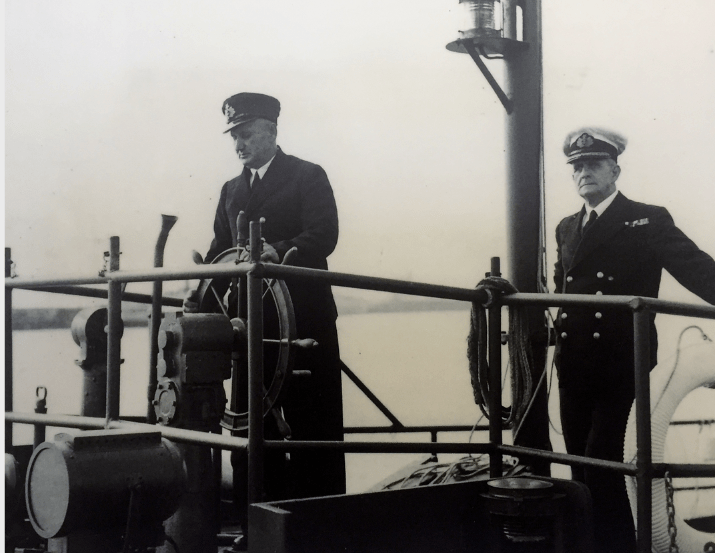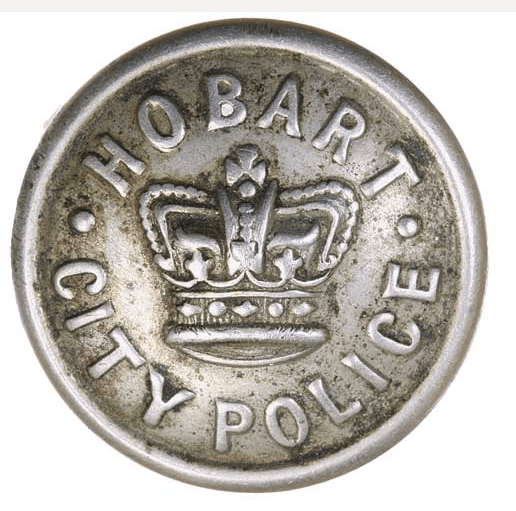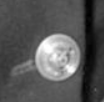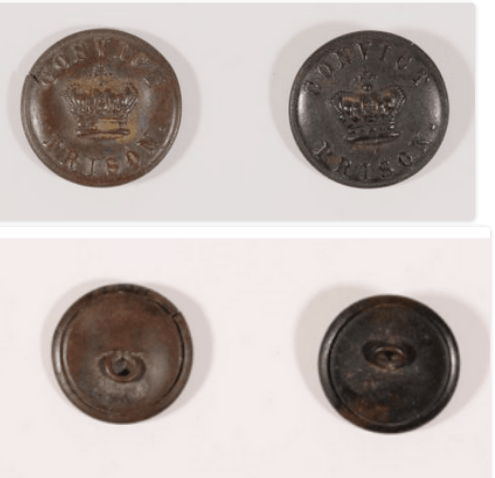Table of Contents
FIRE BRIGADES
Early fire fighting services were provided by the military, then later by volunteer groups, some sponsored by insurance companies or municipalicities. See the ‘Sporting Clubs and Volunteer Organisations” page for more on some of these early brigades.
http://www.austbuttonhistory.com/uniform-buttons-2/sporting-clubs-and-volunteer-organisations/
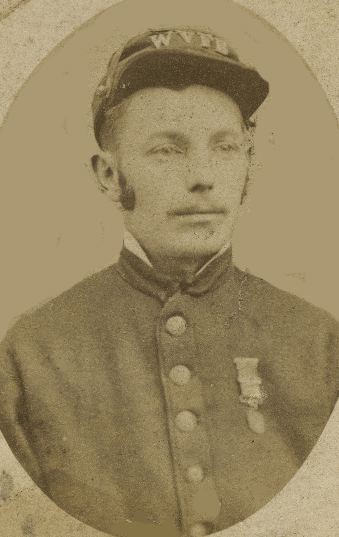
State Library Victoria # pi025909.
Country Fire Brigade
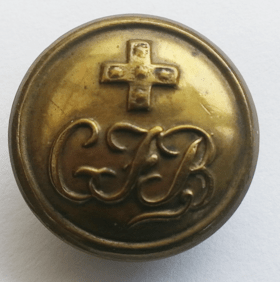
W. Mockton Fitzroy
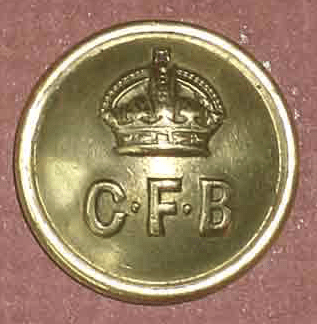
Thanks to Colin: unknown maker.
The button by Mockton was thought to be from the Castlemaine Fire Brigade. The article below shows it was for the Country Fire Brigade.
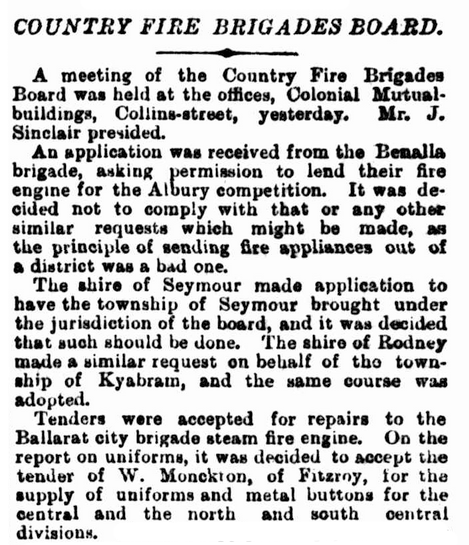
The Age (Melbourne), 25th November 1892 page 5.
Country Fire Authority Victoria
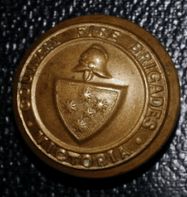
Stokes & Sons Melbourne
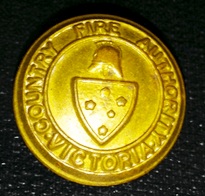
A. J. Parkes Brisbane
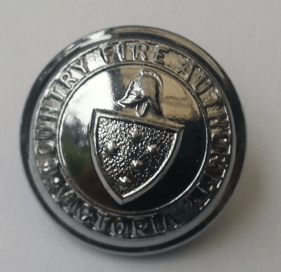
Stokes & Sons Melbourne
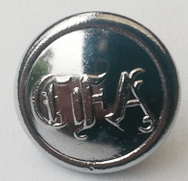
Stokes Melb
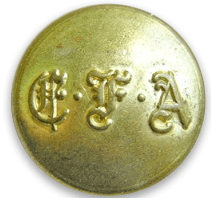
A. J. Parkes: Tony Earle’s button. VBCC magazine July 2018
The CFA was created on 2 April 1945 following significant bushfires during the period 1939–1944 which killed 114 people, destroyed nearly 1400 homes and damaged large areas of the state. Significant numbers of livestock also perished. Subsequent investigations by a royal commission in 1944 showed a lack of cohesive firefighting ability outside the central metropolitan area. The CFA took over existing brigades, many of which had been established in the 19th or early 20th century.
See https://en.wikipedia.org/wiki/Country_Fire_Authority
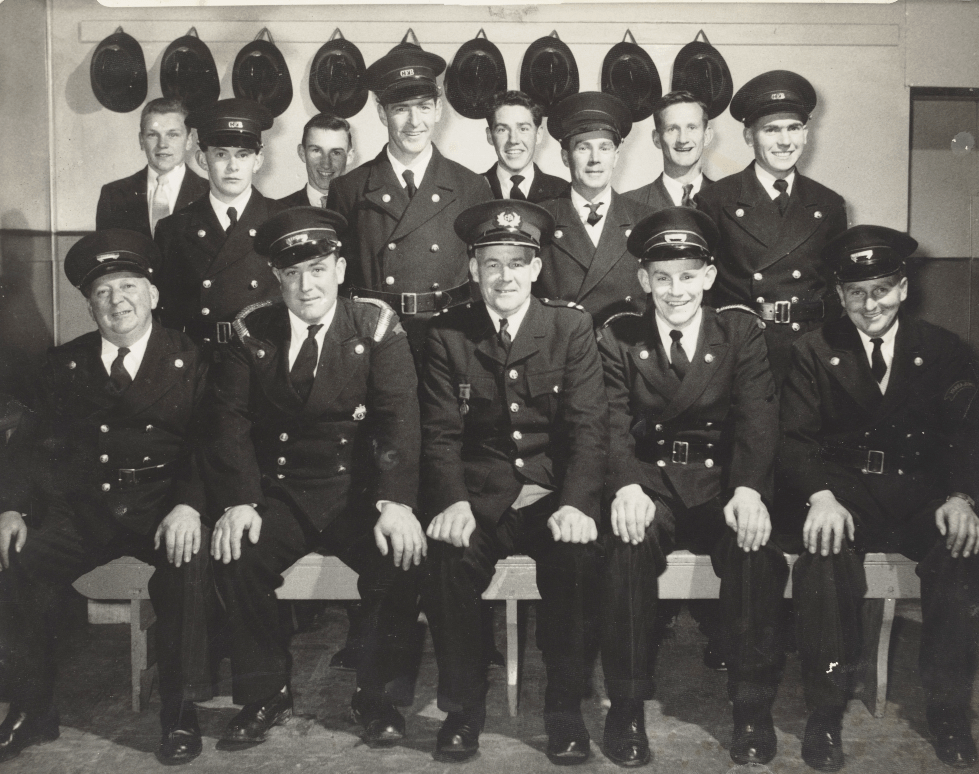
Country Fire Brigades Board
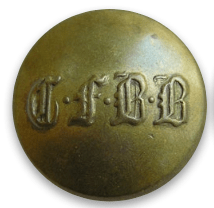
Stokes Vic: Tony Earle’s collection. VBCC magazine February 2016
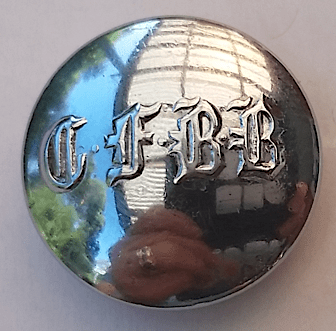
K C Luke Pty Ltd Melb
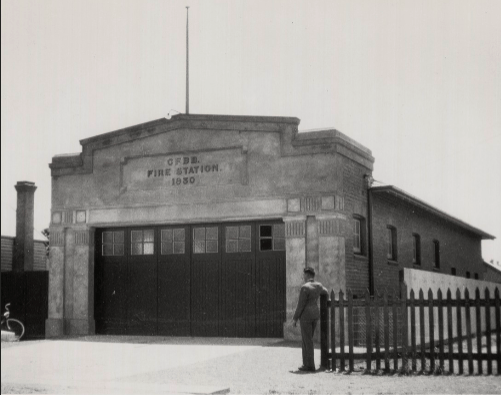
State Library Victoria Unknown fire station labelled C.F.B.B. 1930 https://viewer.slv.vic.gov.au/?entity=IE1866435&mode=browse
Established under the Fire Brigades Act of 1890 to have responsibility for all fire brigades greater than 10 miles (16 kilometers) from Melbourne whilst the Metropolitan Fire Board (MFB) took care of Melbourne and its near suburbs. The first meeting was held on 18th March 1881. It was largely responsible larger towns such as Ballarat, Geelong and Bendigo which left rural services in the hands of local landowners with little assistance, training or equipment although 220 local units were formed by 1931, and by 1944, with the Forests Commission’s partial support, 768 Bush Fire Brigades.
The calamitous Black Friday bush fires in 1939 lead to a Royal Commission recommending the creation of a single fire service for country Victoria to improve the ineffective rural services. Possibly delayed by the War, the 1943/44 fires placed further pressure on parliament to finally implement this. The Country Fire Authority (CFA) was appointed on 19th December 1944.
Photos below: published in the Australasian (Melbourne), 20th March 1897 page 24, of Fire Brigades participating in an annual demonstration and parade.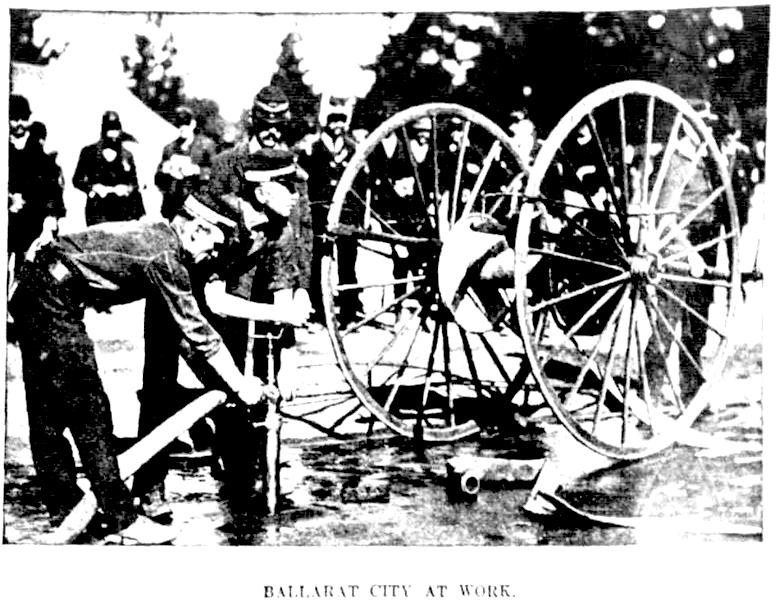

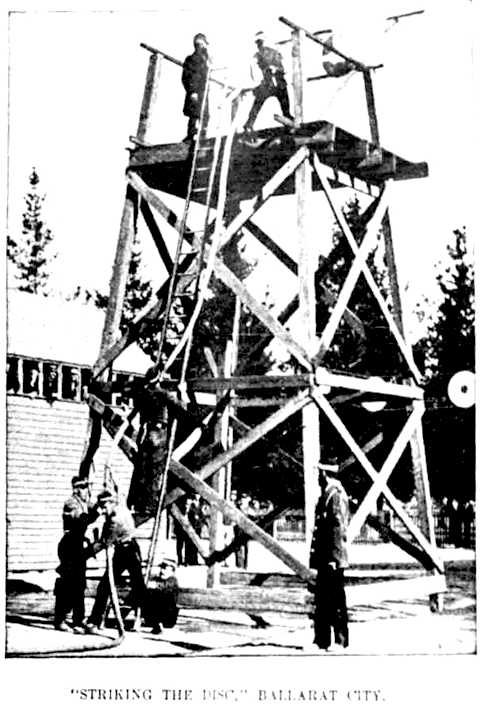
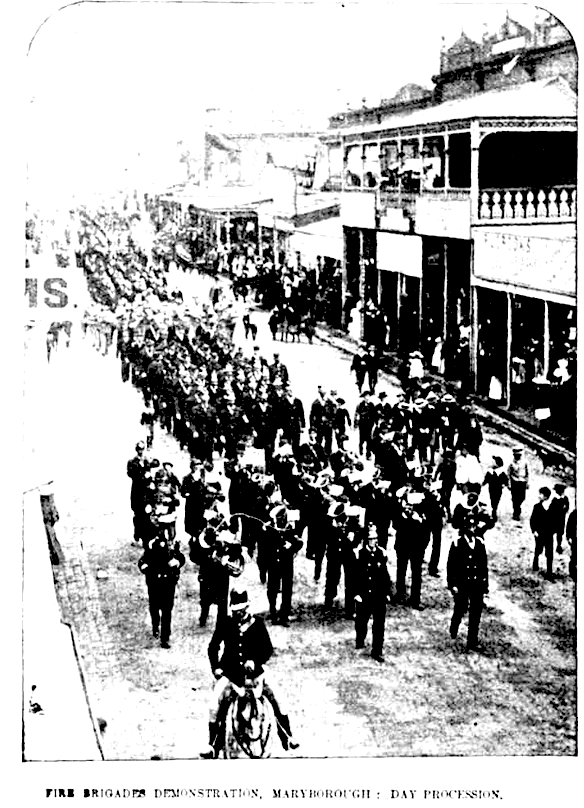
Fire Brigade Commission
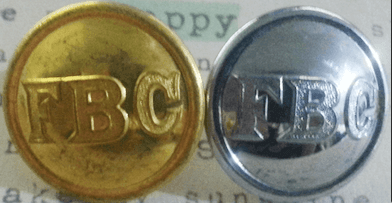
Fire Brigade Commision (Tasmania) Stokes & Sons
These buttons are from the Tasmania Fire Brigade Commission (1946-1977) which was tasked with establishing and maintaining an efficient fire brigade in that state.
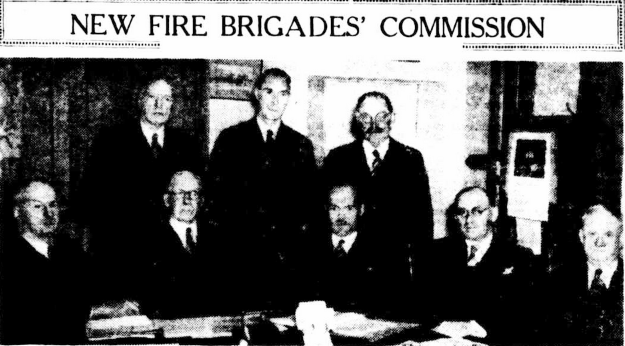
The Mercury (Hobart) 21st March 1946 page 6. The first board meeting of the new Commission.
Hobart Fire Brigade
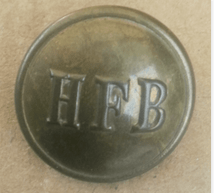
Hobart Fire Brigade, Stokes & Sons Melb.
In 1859 the first Hobart Fire station was established. In 1879 the Hobart Town Fire brigade advertised that it was maintained “soley by the undermentioned Insurance Companies”, naming eleven in all, and warning that the brigade would not service businesses not insured by those named!! In 1883 the Governing Council approved a new Hobart Fire Brigade to take over the existing fire tower and fire fighting equipment. In 1911 the headquarters was moved from Bathurst Street to Argyle Street.
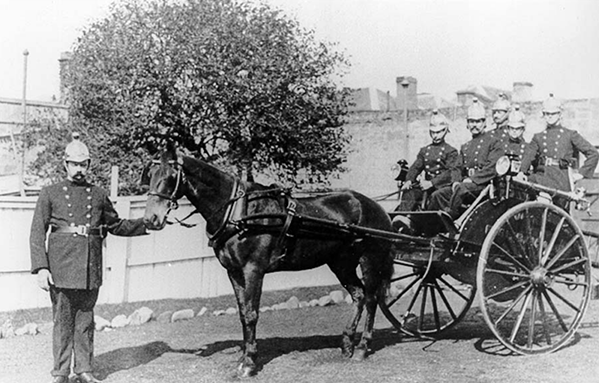
Libraries Tasmania image # PH30-1-1641. 1900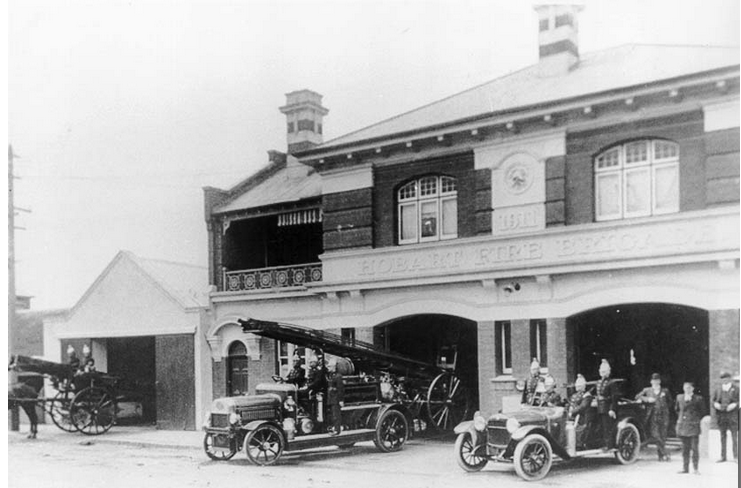
Libraries Tasmania image #PH30-1-1628. Hobart Fire Brigade Station 1910.
Melbourne Fire Brigade
These two buttons were both made in England for A. Bowley, but perhaps at different times due to the different construction.
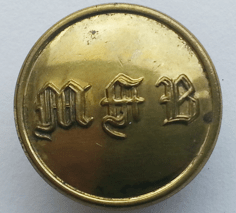
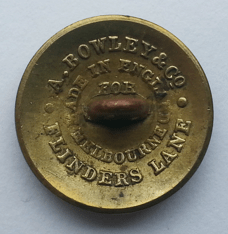
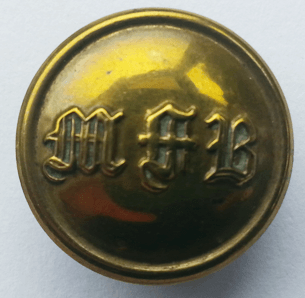
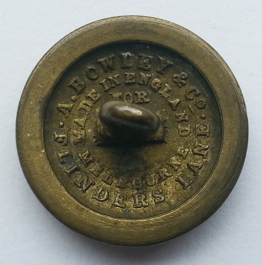
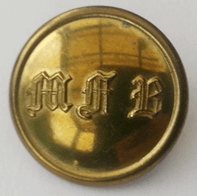
Melbourne Fire Brigade: Stokes
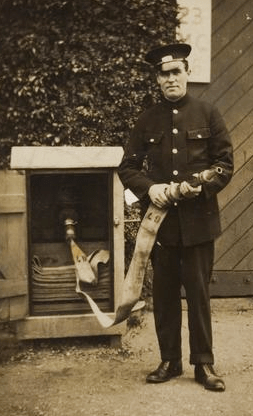
Williamstown firefighter, 1930.
From Museum Victoria https://collections.museumsvictoria.com.au/items/1689713
Up to 1890 Melbourne was protected by rival volunteer and private brigades. Following several serious and fatal fires that year, the Melbourne Fire Brigade was formed in 1891. According to the first annual report it had “59 permanent firefighters, 229 auxiliary firefighters, 4 steam fire engines, 25 horse drawn hose carts and 58 hose reels… 33 horses and 48 stations”. In 1891, the Brigade attended 816 calls and 485 fires, of which 188 fires were classified as serious. The firefighters did not become full-time professionals until 1950. Females were allowed to join from 1988.
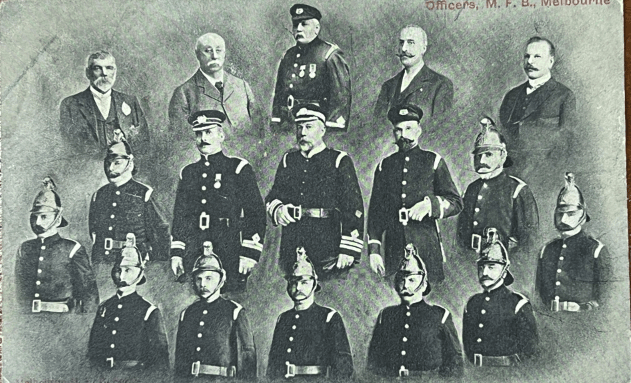
Postcard showing members of the Melbourne (Metropolitan) Fire Brigade.
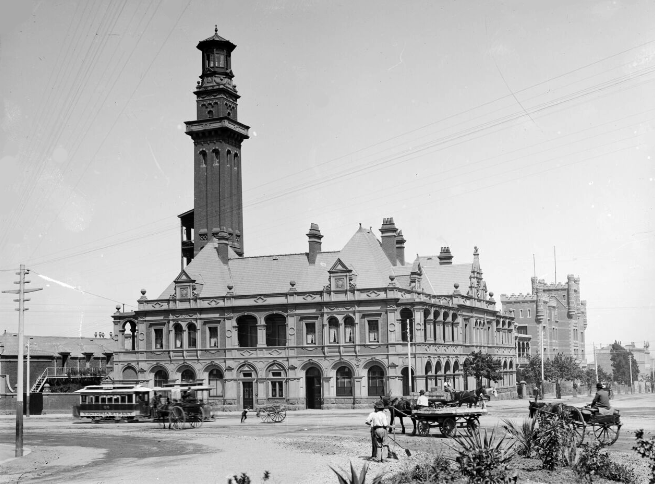
From the State Library http://handle.slv.vic.gov.au/10381/73953. Eastern Hill Fire Station. Opened in 1893, firemen lived on the premises until 1970.
New South Wales Fire Brigade
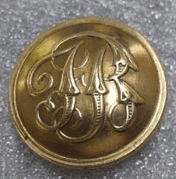
Amor Sydney
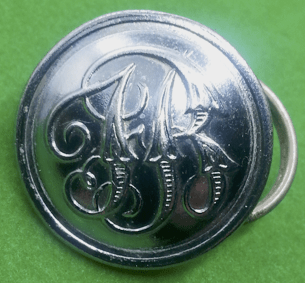
Amor Sydney
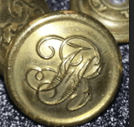
Rider & Bell Sydney
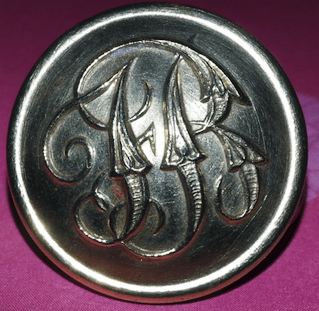
Stokes & Sons Victoria
The New South Wales Fire Brigade was formed in 1910. It was renamed Fire and Rescue NSW in 2011. Before then there had been military, insurance and volunteer brigades, then from 1884, the Metropolitan Fire Brigade (MFB).
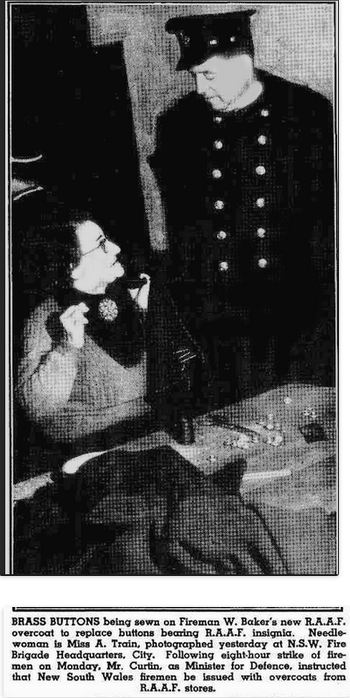
The Daily Telegraph (Sydney) 6th July 1944 page 9.
What could have prompted the Prime Minister to intervene over firemen’s coats?
Apparently the N.S.W. brigade were the only firemen in Australia not to receive a overcoat as part of their standard uniform. Earlier the union’s request for uniforms had been knocked back “due to the war situation”. However, having shivered through the previous winter, they were not prepared to do so again, and were happy to accept surplus military coats. Only 669 in total were needed to supply each man. There was at that time only one overcoat for general use at each station. These were, to quote “ old, battered, not weatherproof, and are supposed to be used in turn by men who go on watching duty. They are not fit to put on a dog.” Whilst the union’s demand for coats within a month seemed rather abrupt, in fact “our men have been demanding coats without success for 15 years.”
At first they only refused to perform non-emergency outdoor duties without coats, but when some men were suspended, a general strike was called. That is when the Prime Minister stepped in. It seems ridiculous that with coats available for use, an 8-hour strike had to occur before this was resolved.
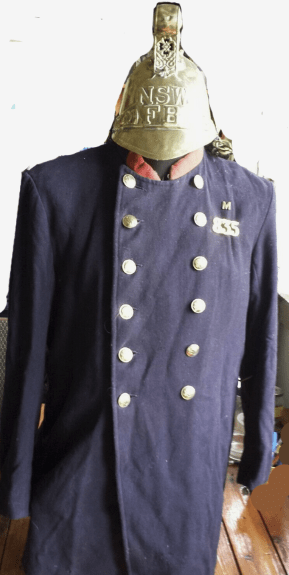
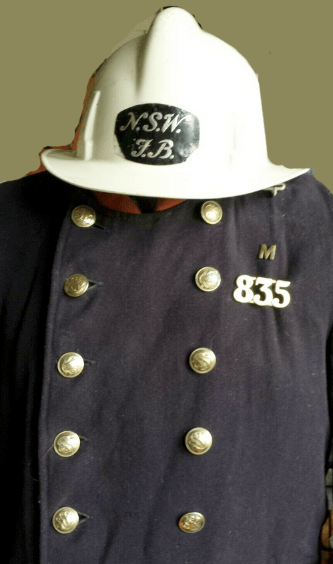
Images used with permission.
Queensland Fire Service
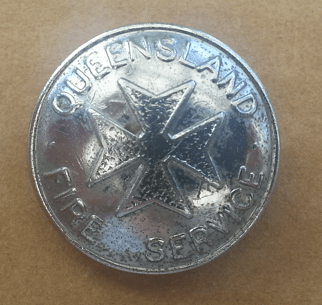
A. J. Parkes Brisbane. 1990-1997
The Brisbane Fire Brigade formed in 1860. In 1990 eighty-one fire boards were replace with the Queensland Fire Service and the Rural Fire Council. The QFS has since been merged with other services into the Queensland Fire and Emergency Service.
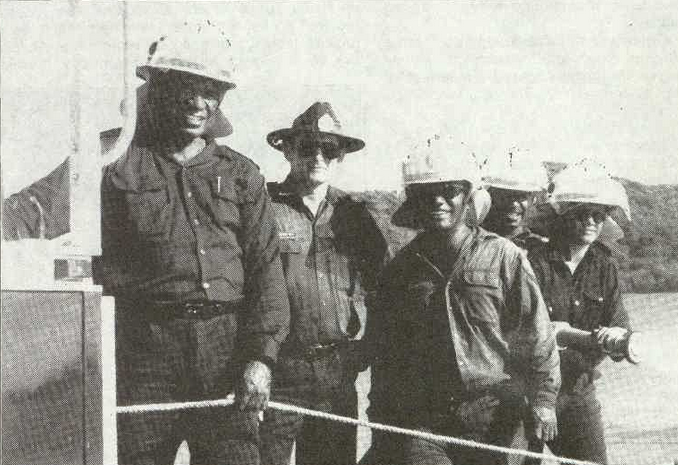
Torres News (Thursday Is, Qld), 21st June 1996 page 13. Members of the QFS on Thursday Island.
South Australia Fire Brigade
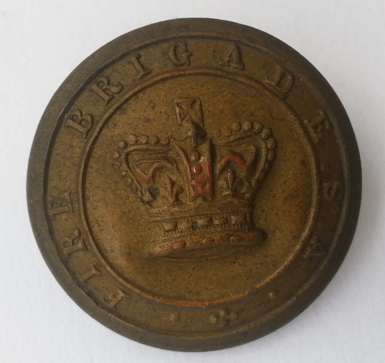
Backmark: Stokes & Martin Melb 1882-1893.
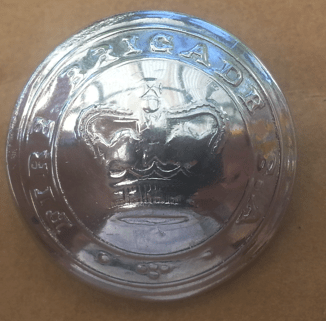
A. J. Parkes Brisbane 1953-1981.
The Adelaide Fire Brigade was established in 1859. From 1870 (or before), a South Australian Fire Brigade Association existed, consisting of brigades belonging to various insurance companies. The South Australian Fire Brigade was reorganised in 1882. At that time it operated 3 floating steam fire-engines, 2 steam tugs, 4 barges, 3 large and 35 small land steam engines, as well as over 100 manual engines, 29 horse carts and 13 vans.
It was renamed in 1981 as the South Australian Metropolitan Fire Service (SAMFS).
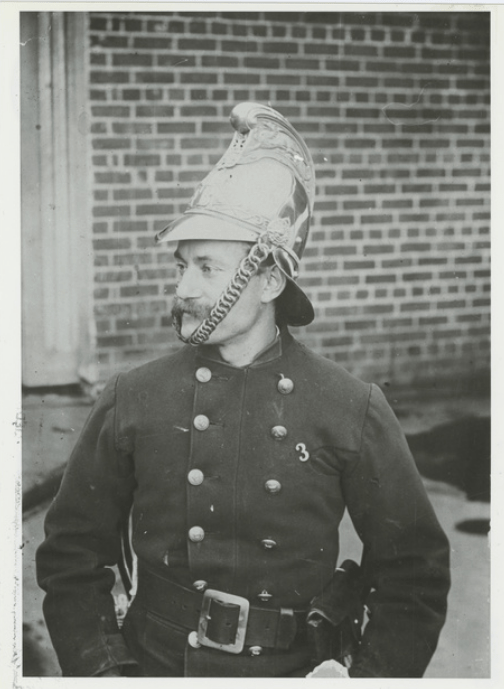
State Library SA image #B40262. it states that this is Senior Officer Westly in 1930, however, the buttons on his uniform clearly have a Queen Victoria crown!
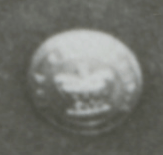
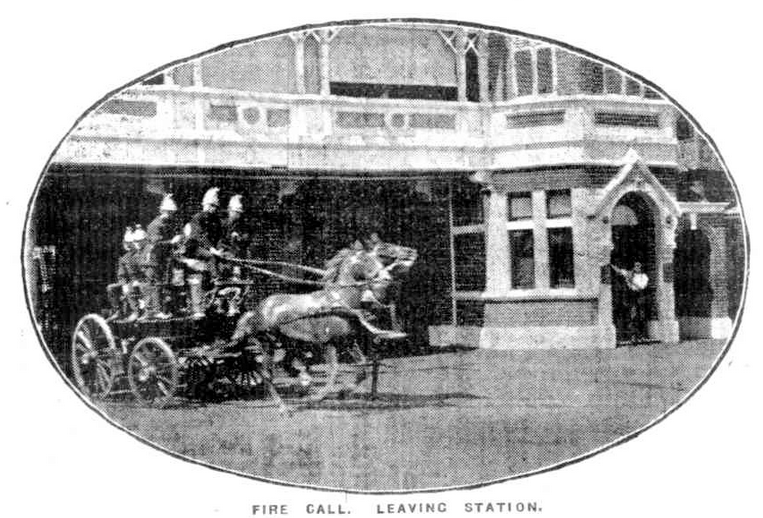
Daily Herald , 28th January 1911 page 3.
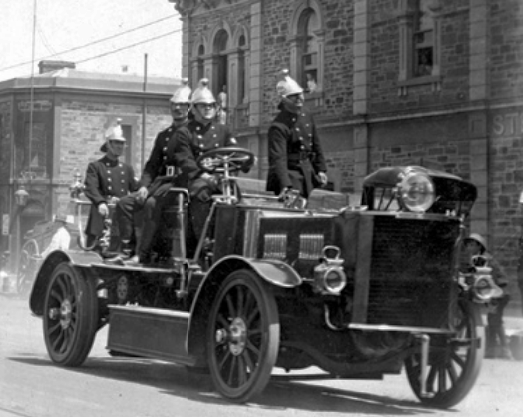
State Library of SA. Detail of image #PRG 280/1/12/275. c. 1913
Unknown Fire Brigade
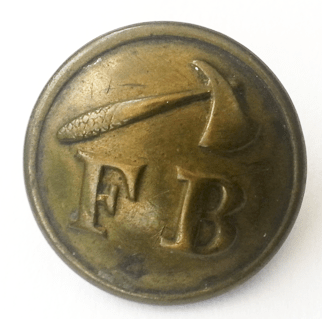
Stokes and Sons Melbourne
West Australia Fire Brigade
http://www.ufuofwa.net.au/vault/union-history/
https://www.dfes.wa.gov.au/schooleducation/heritage/Pages/default.aspx
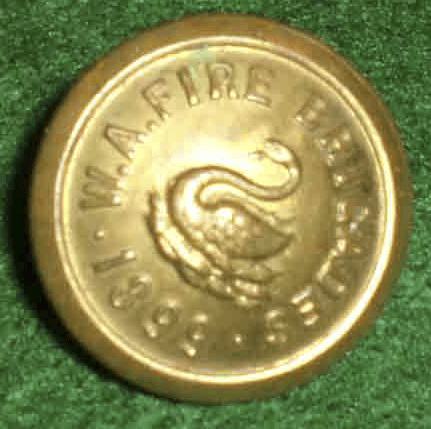
“1899” button
In November 1898 the WA Fire brigade was formed by government decree, so 1899 was the first year of operation.
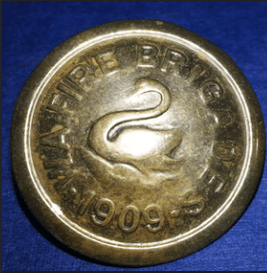
“1909” buttons. Sheridan’s Perth
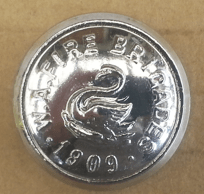
Stokes & Sons Victoria
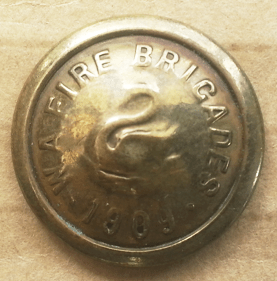
Stokes & Sons Melb
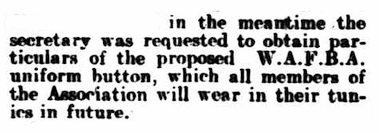
The West Australian (Perth), 14th September page 7. Which button was being discussed, the 1899?
The year 1909 is marked on the buttons as this was the year the WA Fire Brigade Act was passed into law, and all pre-existing fire brigades came under central control.
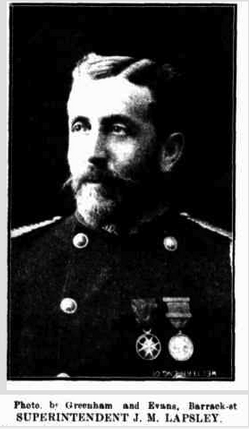
Western Mail (Perth) 19th February 1910 page 26.
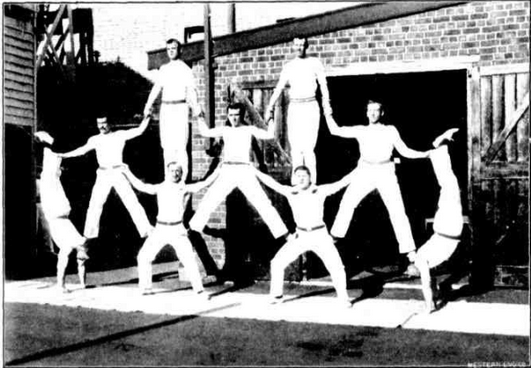
Western Mail, 4th September 1909 page 28. Gymnastic display by Perth Firemen.
MISCELLANEOUS GOVERNMENT SERVICES
Australian Lighthouse Service
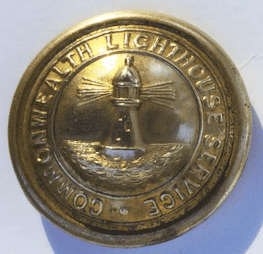
Stokes & Sons Melbourne
The Commonwealth took over control from the states of the service during the period of 1913-1915. Its role was to maintain navigational aids, light house maintenance and to transport families and supplies to and from lighthouses.
City Of Melbourne
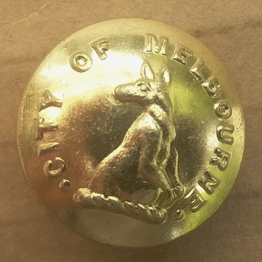
Stokes & Sons
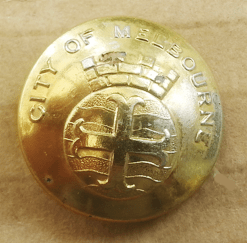
Stokes Melbourne Australia
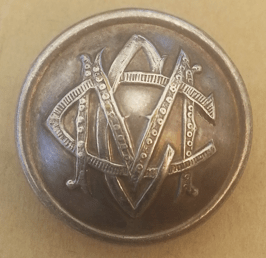
Stokes & Sons Victoria. Two holes in back plate.
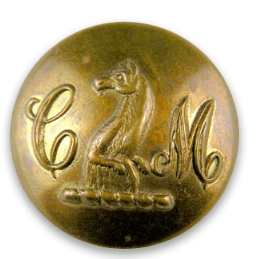
Tony Earle’s button, from the VBCC magazine August 2015. Stokes & Sons Melb. This kangaroo looks like a llama sitting up.
The buttons were used for Town Hall staff such as attendants, chauffeurs, hall-keepers, etc.
To see The City of Melbourne Collection of buttons, see http://citycollection.melbourne.vic.gov.au/uniform-buttons-city-of-melbourne/
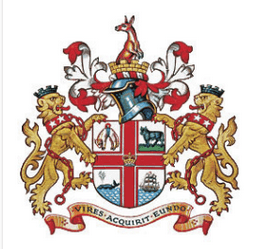
Melbourne City Coat of Arms.
City Of Prahran.
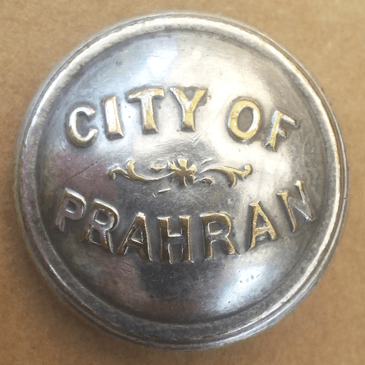
Stokes & Sons Melbourne. c.1953-62
The city of Prahran was declared in 1879. At first they did not adopt uniforms, seeing them to be a waste of money. From 1888 the caretaker at the town hall was supplied with one:

The Telegraph, St Kilda, Prahran and South Yarra Guardian, 1st September 1888 page 6.
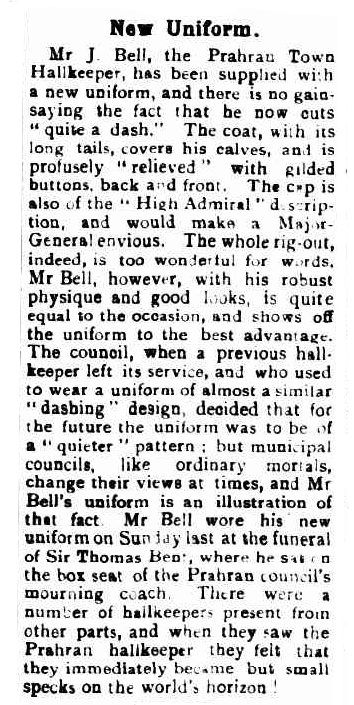
Malvern Standard, 25th September 1909 page 2.
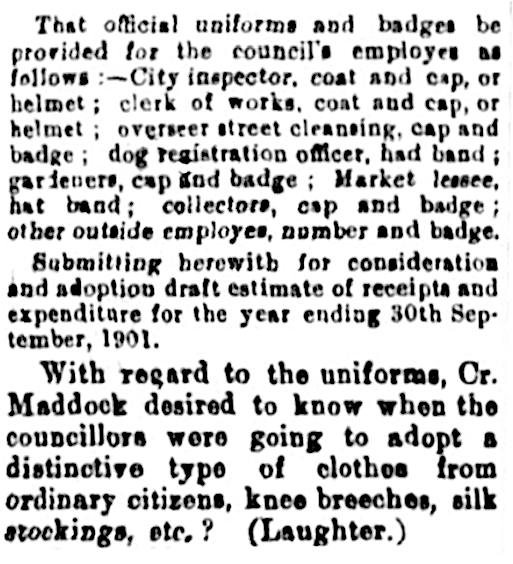
The Prahran Telegraph, 24th November 1900 page 5.
From 1900 outside officers and employees were to wear uniforms. There was ongoing problems with Inspector Rider, who would not always wear his whilst on duty! Complaints were made! In 1908 it was reported that the nature and colour of uniforms for street sweepers had not been decided upon.
I wish I could claim the button belongs to Mr Lacy, Mr Bell or to stubborn Inspector Rider, but the button is of the type made post-1950 with two holes in the back plate. Could it be one of these volunteers?
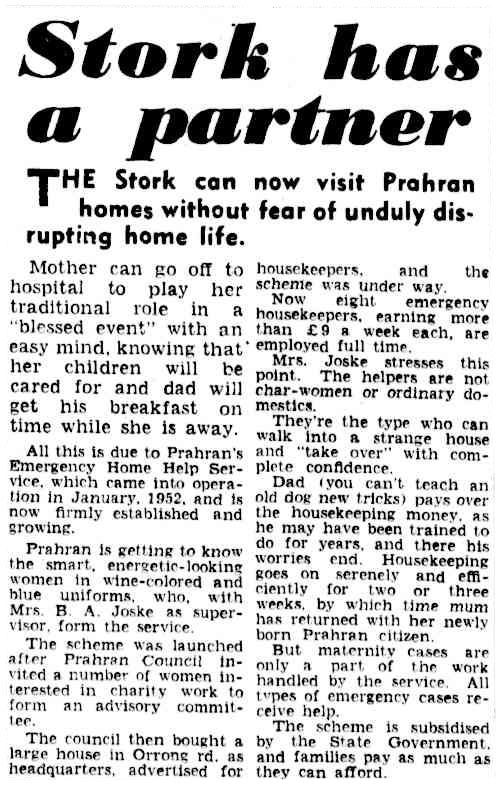
The Argus (Melbourne), 13th October 1953 page 20.
Customs
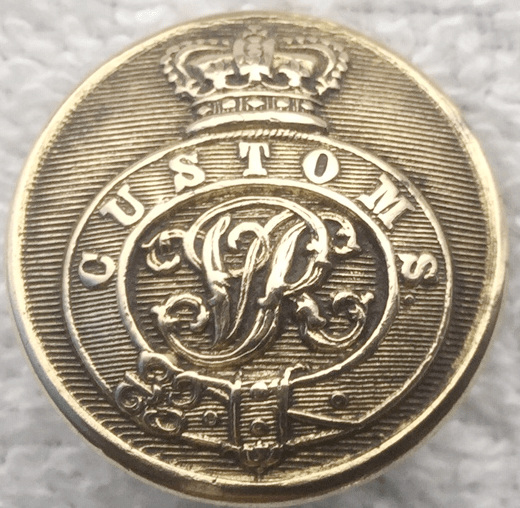
Carol’s collection: Customs uniform button. Backmarked T.G. Brown & Son, Adelaide.
The above was a South Australian Customs Department button dating 1878-1897.
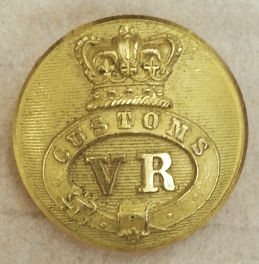
Backmark: Hammond Turner & Sons, with a crown.
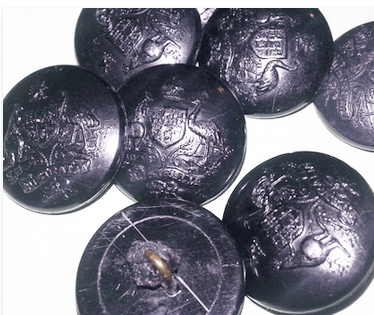
Post 1954.
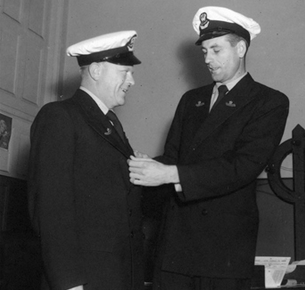
Newcastle Libraries. Newcastle Morning Herald 28/4/1955. Custom Officers.
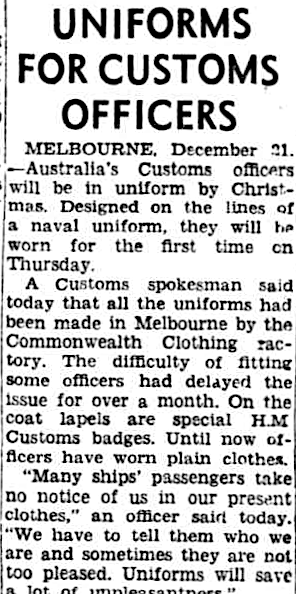
Morning Bulletin (Rockhampton,Qld) 22nd December 1954 page 1.
It’s interesting to realise that Australian Custom officers had no uniforms prior to December 1954. The buttons above are from custom uniforms. They show the Australian Coat of Arms are made of made of a hard black plastic.
See also http://www.austbuttonhistory.com/16th-november-2021/
Fremantle Harbour Trust
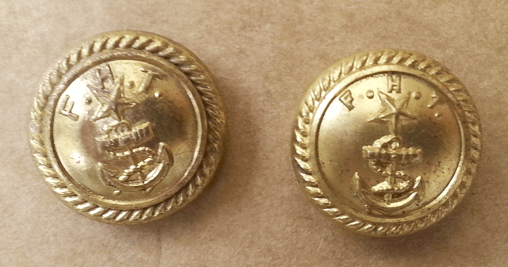
Backmarks: blank, and Firmin London.
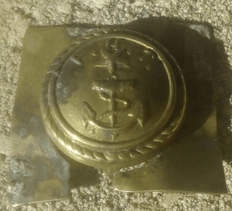
Unfinished Sheridan button. It has a standard naval type design with the letters F. H. T.
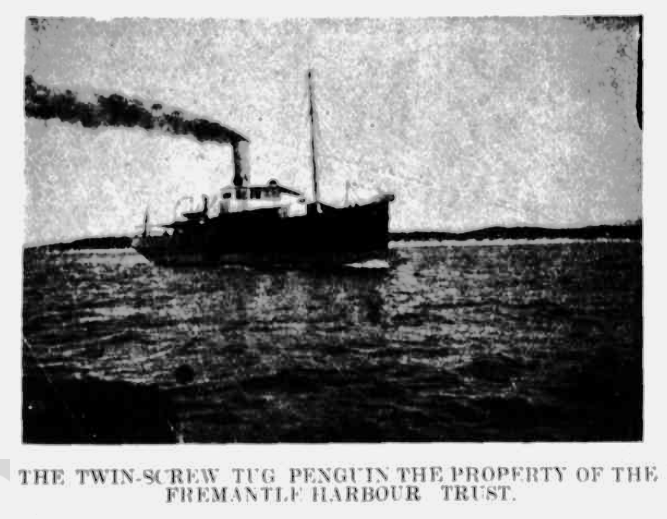
Western Mail (Perth) 13th February 1904 page 30.
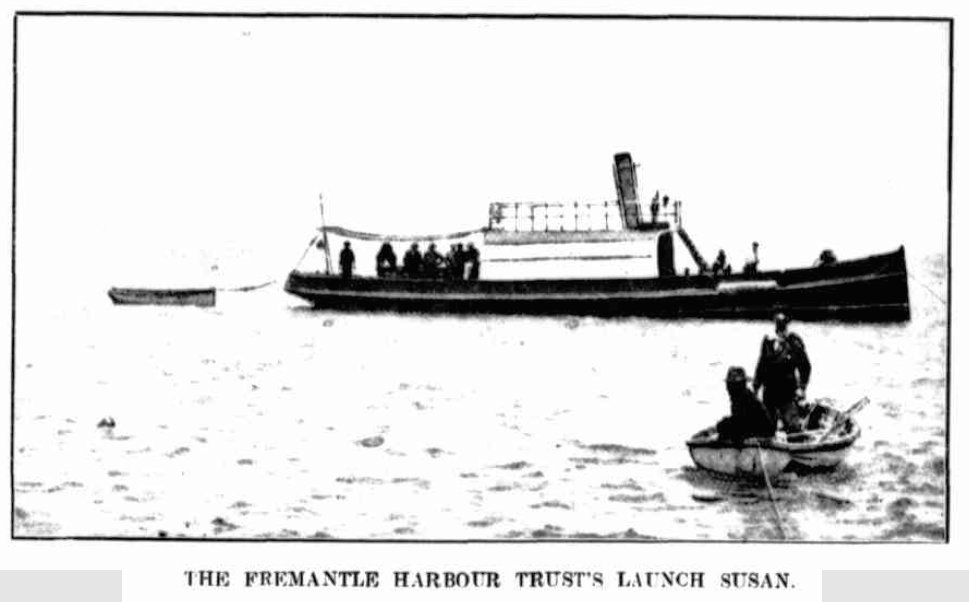
Western Mail (Perth), 17th March 1904 page 29.
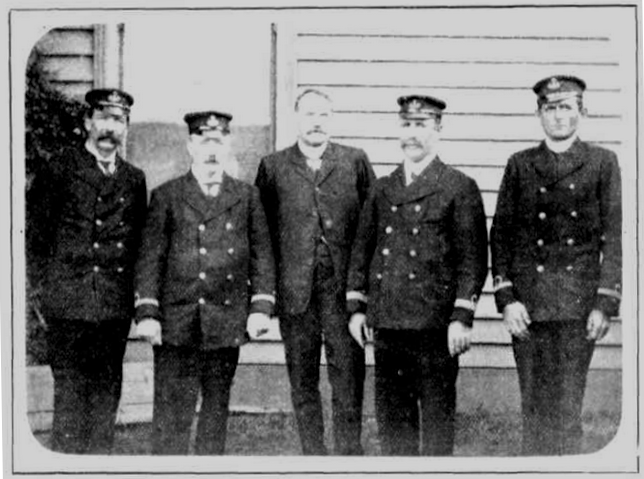
Western Mail (Perth), 23rd June 1906 page 29.Chief Harbour Master and Fremantle pilots.
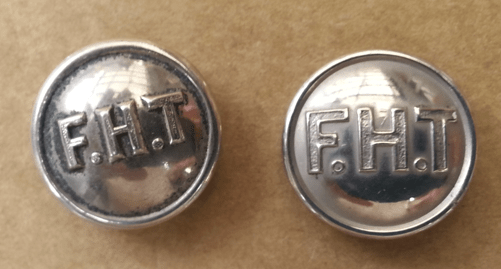
Backmarks: Stokes & Sons, and blank with 2 air holes.
Harbour masters were first appointed at Fremantle in 1829. Five commissioners met for the first formal meeting of the new Fremantle Harbour Trust on 5th January 1903. They were responsible for control of the harbour including building and maintaining all sheds, piers, roads, the lighthouse, buoys and signals, etc, built there. They could lease land for industries and businesses. They would employ people to load and unload wharves, and also pilots and signalmen. They would manage wrecks, collect shipping dues and make regulations relating to the harbour. This was replaced by the Fremantle Port Authority in 1964.
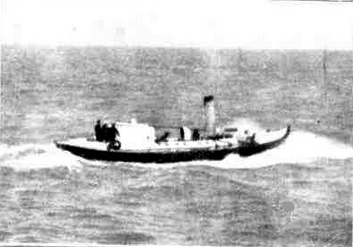
Western Mail, 14th April 1927 page 20. The Harbour Trust Pilot Lifeboat, the Lady Forrest, that guided boats into harbour in all weather for 64 years.
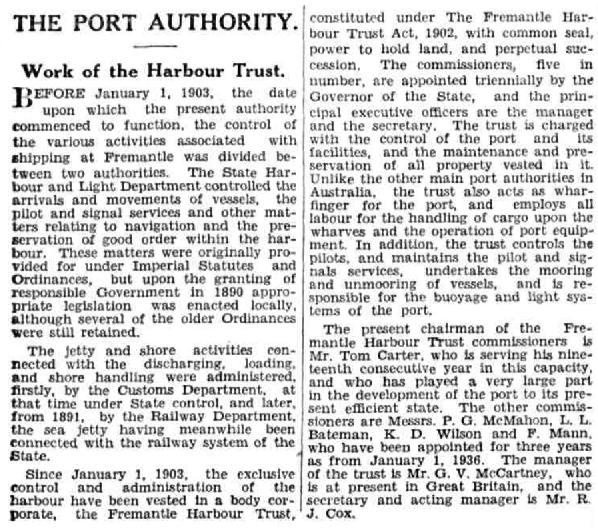
Western Mail (Perth), 20th May 1937 page 16.
Fremantle Port Authority
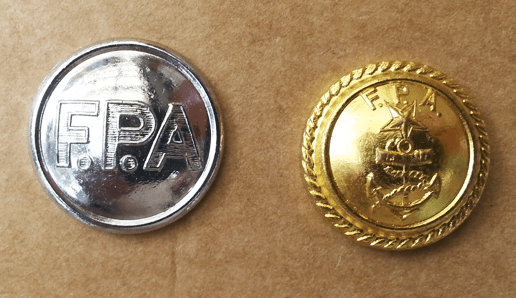
Sheridan Perth
The trust was replaced in November 1964 by the Fremantle Port Authority, who “manage shipping channels, navigation aids, cargo wharves, the Fremantle Passenger Terminal, road and rail transport infrastructure, moles and seawalls and other port infrastructure.”, as per the WA government website.
https://fremantlestuff.info/buildings/harbourtrust.html
https://www.fremantleports.com.au/
Government House Hobart
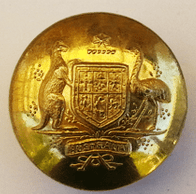
Stokes & Sons Melb. This style button has been used for other Government Houses around Australia.
The current Government House is the 3rd (4th if you include the tent the first Governor had to live in for two years), built from 1855-1857.
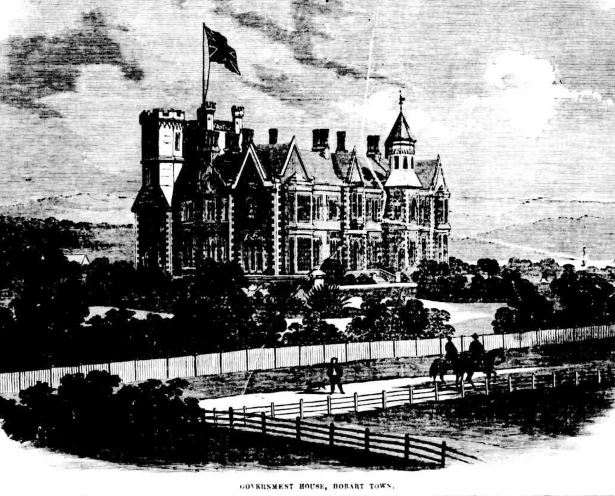
The Cornwall Chronicle (Launceston) 26th February 1870 page 1 of supplement.
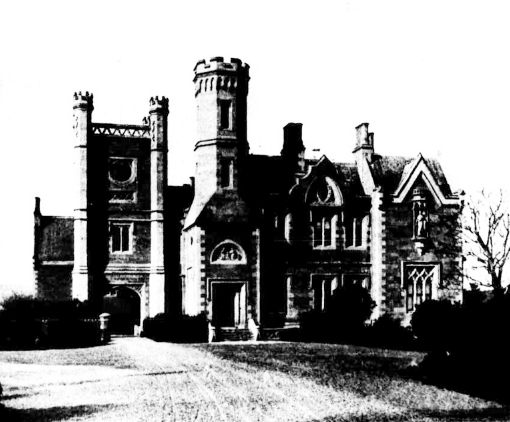
The Australasian (Melbourne), 1st October 1932 page 71.
Maritime Services Board of New South Wales
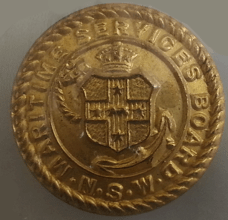
Stokes & Sons Melbourne. Buttons dates 1937-1952.

The Sydney Morning Herald, 31st January 1936 page 10.
The Maritime Services Board of New South Wales was established in 1936, replacing the previous Sydney Harbour Trust and also the Department of Navigation, and would continue until 1995. It administered the ports of Sydney and Newcastle as well as issuing watercraft licenses. The button shows a simplified shield of N.S.W. with a King’s crown and an anchor.
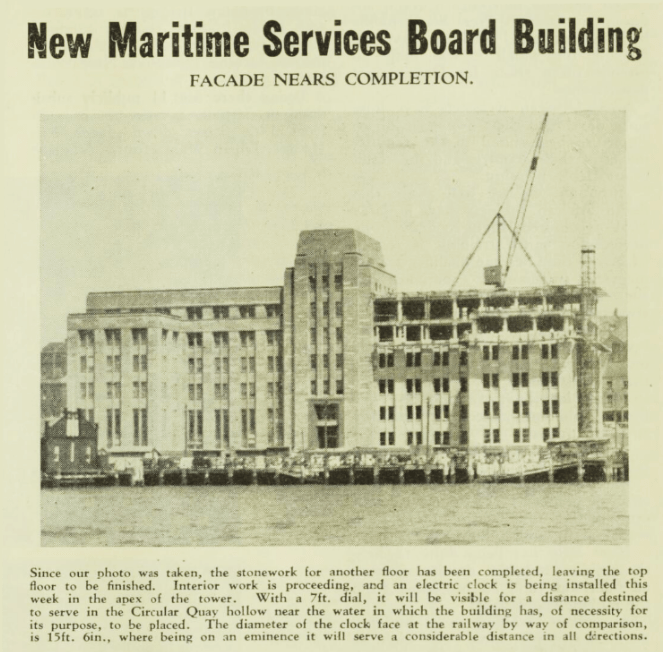
Building and Engineering magazine, 24th December 1951 page 75.
Metropolitan Transit Authority, Victoria

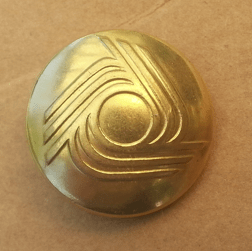
Stokes Australia

Stokes & Sons (pre 1962)
The MET was a Victorian Government authority operating passenger trains, trams and buses from 1983, when it took over from Melbourne & Metropolitan Tramways Board, VicRail metropolitan trains division, and the Loop Authority. In 1989 it was merged with the State Transit Authority ( STA; operating country and freight trains) to form the Public Transport Corporation (PTC). The PTC was progressively privatised from 1993.
NSW National Parks and Wildlife Service
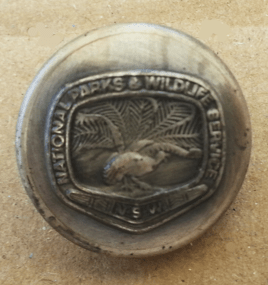
Backmark: Amor Sydney
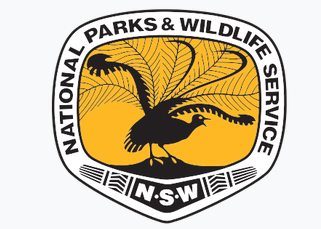
In 1967 the Fauna Protection Panel and the Reserves Branch of the Lands Department were amalgamated into this new service, under the Department of Lands, Industry and Environment. They study and conserve wildlife and land, map protected areas, and up-keep fire trails. The photo below is from the NSW State Archives of the first meeting of its staff. The buttons can be seen on the jackets.
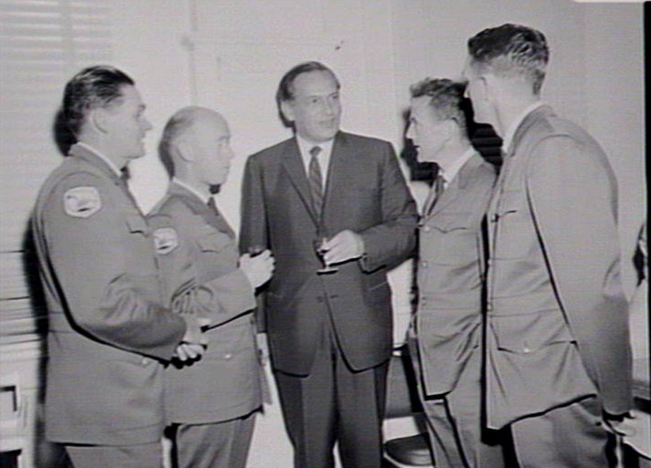
File #FL2401623.
Parkside Mental Hospital
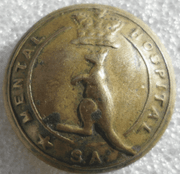
Backmark: S. S. & Co Ltd Adelaide
In 1909 the Parkside Lunatic Asylum was renamed as Parkside Mental Hospital.

The History Trust of South Australian, South Australian Government .
Although the button is labelled Mental Hospital S.A., it must related to this institution. It was renamed Glenside Hospital in 1967.
South Australian Marine Board: 1860-1925
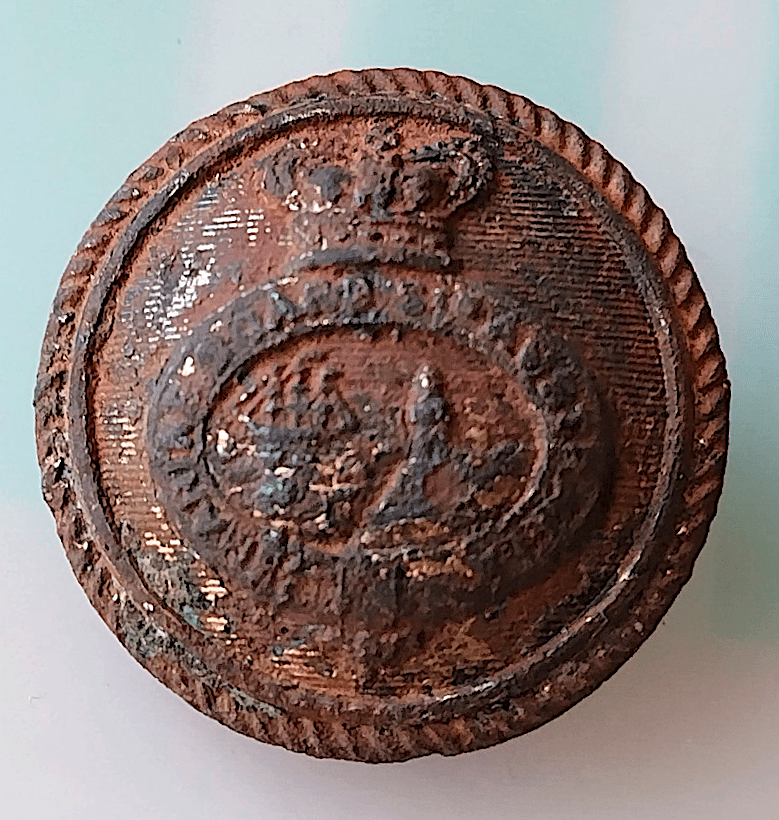
Imaged used with permission of Robert Cuthbert. Date button 1882-1901.
What a wonderful button this was when new. The image is from the Board’s seal, gazetted in 1882:
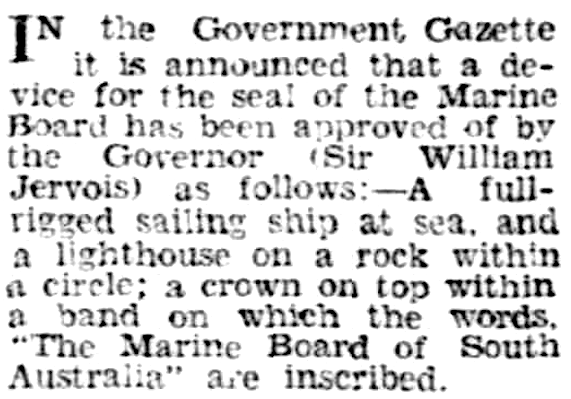
The Advertiser, 27th October 1882 (as reported in the Advertiser 27th October 1932 page 17).
The words ‘Marine Board Sth Australia’ are within a garter encircling the image, and is surmounted by Queen Victoria’s Crown, dating it from 1882-1901, although the board operated from 1860-1925.
According to the Encyclopedia of Australian Science and Innovation, in 1860 the board took over the responsibilities of the Trinity House of Port Adelaide and the Port Adelaide Harbour Trust. The Marine Board was responsible for shipping safety, buoys, lighthouses, pilots, dredging and explosives amongst other functions. They were responsible for Port Darwin, as the Northern Territory was then part of South Australia.
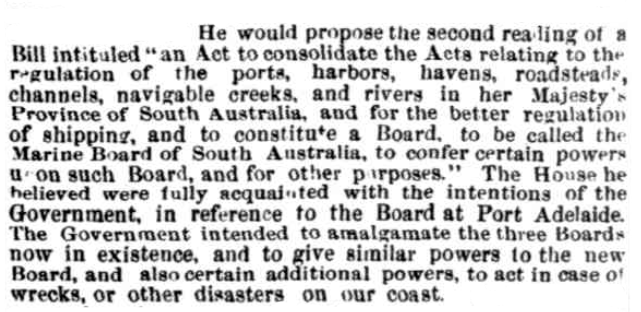
South Australian Weekly Chronicle (Adelaide), 1st September 1860 page 5. Part of a long-winded report in which various members of Government complained they had only just received the Bill, hadn’t had time to properly read it, but still had complaints to make.
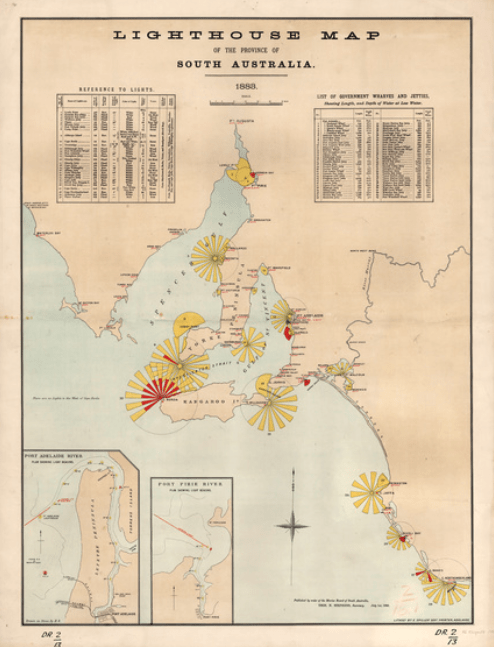
State Library of SA: Lighthouse map of the province of South Australia/ Marine Board of South Australia [C 930] 1883. Shows lighthouses, bays, jetties and wharves.
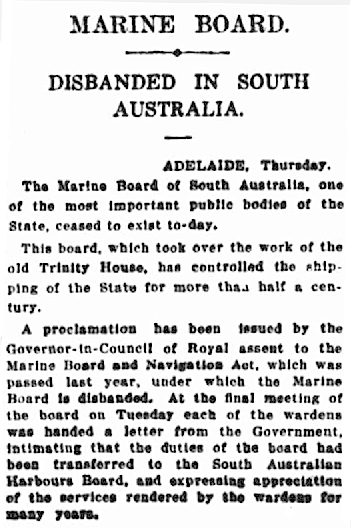
The Sydney Morning Herald (1st January 1926 page 4.
Qantas
See also the Private uniform page, as it started and returned to private ownership.
Queensland and Northern Territory Aerial Service was a private company started in 1920. In 1934 it merged with Britain’s Imperial Airways to form Qantas Empire Airways Limited (QEA) and began flying internationally. The fleet was taken over by the government during WW2 for war use.
In 1947 QEA was nationalised by the government, with the British shares bought by the Australian government and Qantas Limited wound up , the Queensland routes being transferred to TAA. It remained named QEA until 1967, when it was renamed Qantas Airlines. Qantas was re-privatised between 1993-1997.
State Government Insurance Office
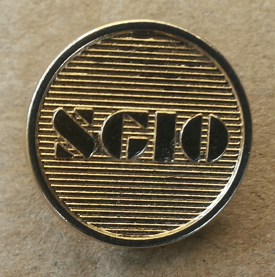
No maker’s mark.
The State Government Insurance Office was set up in Western Australia in 1926, after the success of the Queensland version from 1916. The main thrust was to support gold miners who might develop lung disease in the course of their profession. There was opposition to this from the Opposition (no pun intended), claiming it would cost too much and should be left to private insurance companies. The Labour Government at the time claimed that private firms were refusing to offer quotations for the scheme, forcing the government to do so. Despite the actual existence of the Insurance Office, the scheme did not pass into state legislation until 1938!
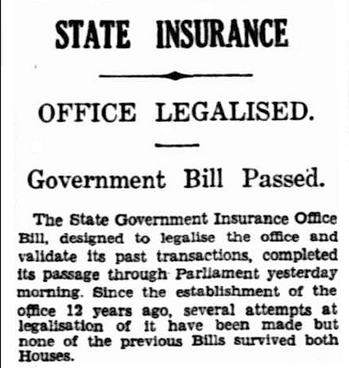
The West Australian (Perth), 17th December 1938 page 22.
Over the years the insurance office extended to cover compulsory 3rd party motor vehicle , school children’s and general insurance. Privatised in 1994, the firm offers car,motorcycle, home,business, boat, caravan and travel insurance.
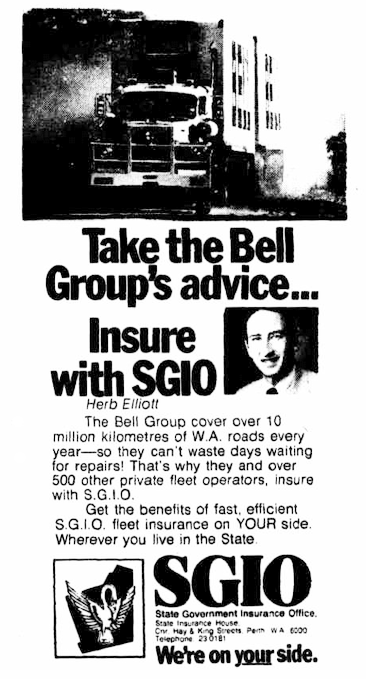
The Beverley Times (WA), 19th May 1977 page 5.
Tasmania, Department of Government
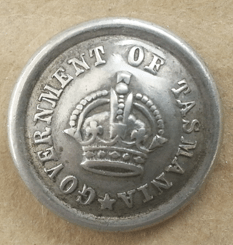
Tasmanian Department of Government
Trans Australian Airways
The post WW2 Labour government formed a government owned interstate airline. They were to run it as a not-for-profit company, with the profitable eastern seaboard routes subsidising flights in remote areas that the private airlines weren’t interested in supporting. It was meant to be a monopoly, but this was successfully challenged in a High Court appeal by existing airways. The first official flight of Trans Australian Airways was on 9th September, 1946. ANA was obliged to improve its service and punctuality in the face of the new competition, but it ended up failing and being bought out by Ansett.
For more information see http://www.austbuttonhistory.com/uncategorized/4th-march-2021-taa/
1946-64 design
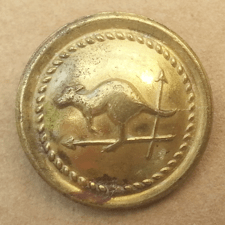
No backmark. Captain’s. 14mm diametre.
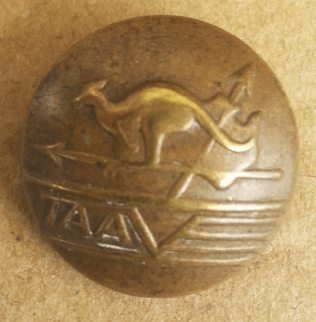
Stokes & Sons Melb, drop shank.
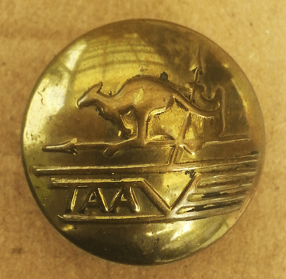
Stokes & Sons Melbourne, fast shank

Stokes Melb, Staybrite
1964-83 design
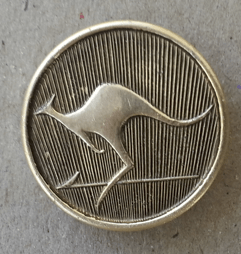
Stokes
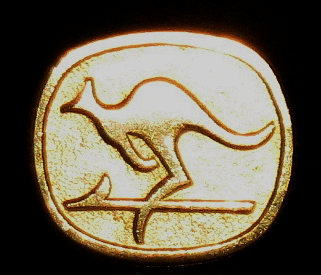
No backmark. 1964-1983 blazer button

K. G. Luke Melb 1964-1976
1984-6 design

1986-1992 “Australian Airlines” design
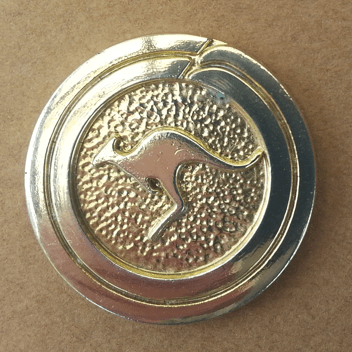
Metalised plastic. No backmark. 1991-93. From the period when T.A.A. became part of Qantas, re-badged as Australian Airlines.
1993-4 design
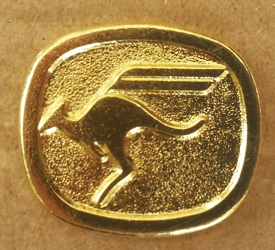
1993-4 pilot’s blazer. Worn during the merger of Australian Airlines and Qantas.
South Australian Government (generic)
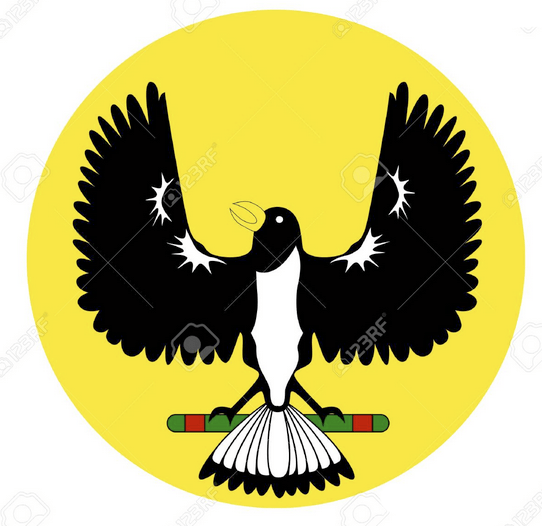
State badge.
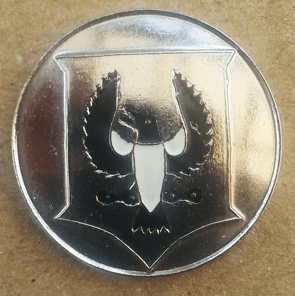
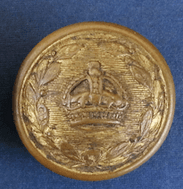
The button on the right is by Stokes & Sons.
State Electricity Commission of Victoria
The SEC was the government owned electricity supplier in Victoria, established in 1918. By 1972 it was soley responsible for generation, transmission and supply. In the 1990s it was split up and privatised.
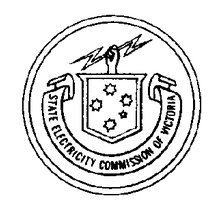
This logo was used from 1918-1970s and is seen on Ballarat tramways button.
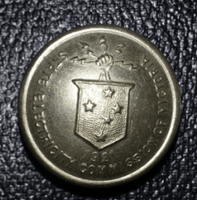
Stokes & Sons

This logo was used from the 1970s-1994.
State Transport Authority (South Australia)

A.J. Parkes Brisbane 1974-94
The STA was the authority overseeing public transport in South Australia from 1974. In 1994 it was split into TransAdelaide and the Passenger Transport Board.
Sydney City Council Law Enforcement Officer
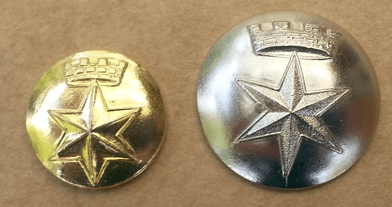
No makers mark.
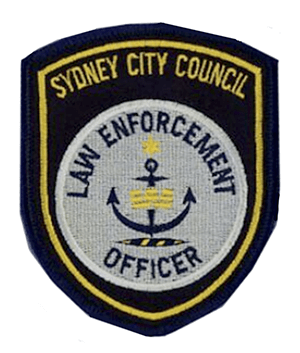
Council Officers police the City Council’s by-laws and regulations. The following article outlines the kind of actions taken in Melbourne in 1916, and were probably similar in most cities. Just remember, don’t cause a nuisance when feeding your horse!
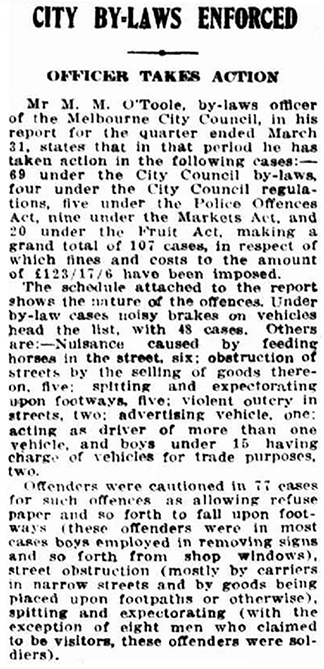
The Herald (Melbourne), 29th April 1916 page 6.
Sydney Harbour Trust
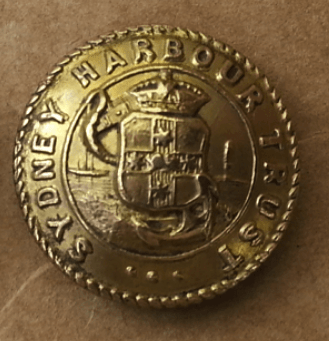
No backmark
This was a New South Wales government authority from November 1901 until 1936. The need for such a trust had been debated since 1892. It had many responsibilities including regulated movement of vessels, handling of cargo, preservation and improvement of the port,removal of wrecks, dredging, licensing piers, maintenance of swimming baths, wharfage, fire fighting, and safety. Its scope included all foreshores, lighthouses and tugs within the harbour.
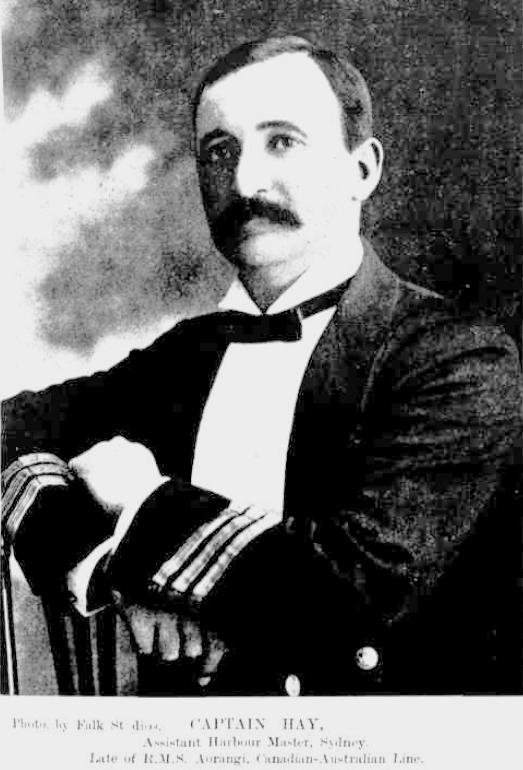
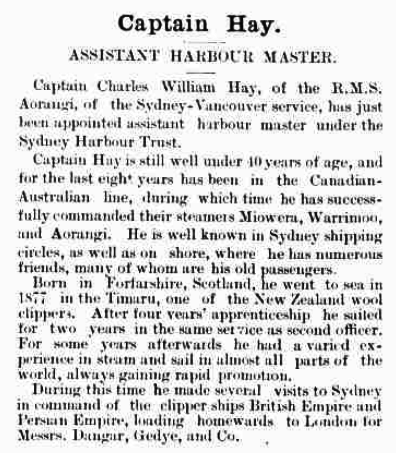
The Sydney Mail and New South Wales Advertiser , 7th December 1901 page 1433.
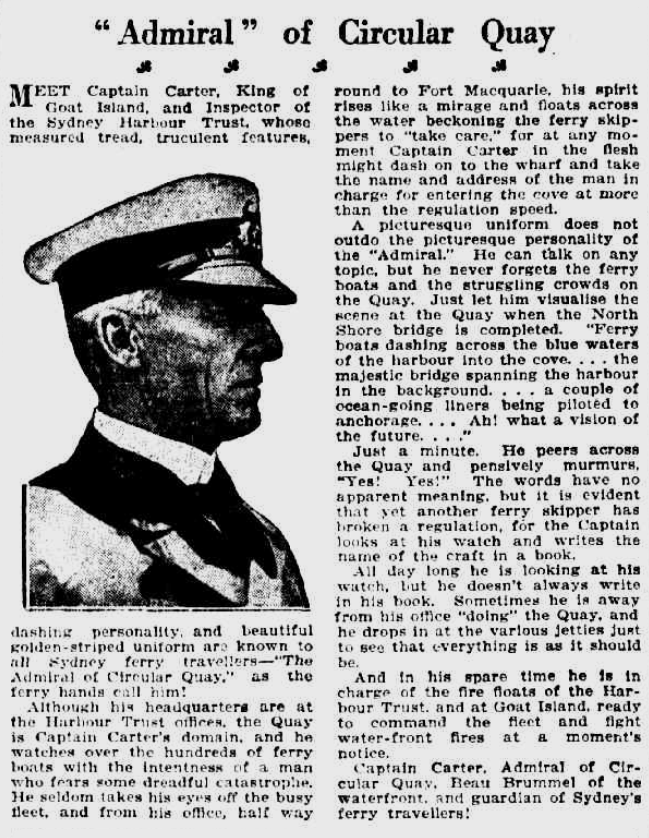
Smith’s Weekly, (Sydney), 29th November 1924 page 15.

The Sydney Morning Herald, 31st January 1928 page 14.
After 1936 these duties were taken over by the Maritime Services Board (see above).
Trans Australian Airlines
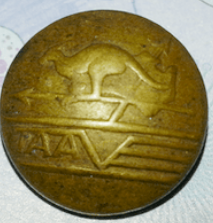
Stokes & Sons Melbourne
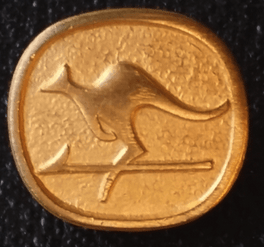
K. G. Luke Melb
TAA was set up by the national government in 1946 to compete with the privately owned (and dominant) company, Australian National Airways. It was a popular and successful airline, although hamstrung by the limiting “two Airlines Policy” imposed by the succeeding conservative governments. In 1986 it was rebranded Australian Airlines then acquired by Qantas in 1994.
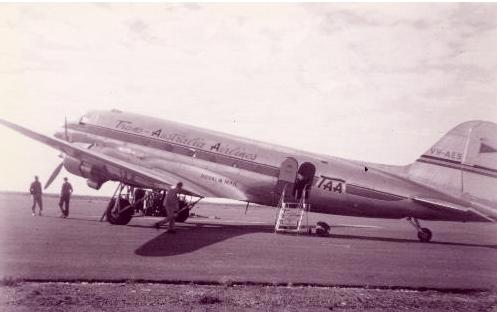
NT Library Douglas C-47-DL 1954. https://hdl.handle.net/10070/36286
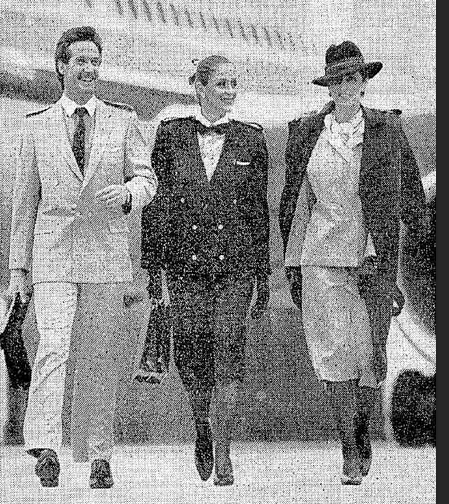
The Canberra Times, 15th November 1984 page 17. New uniforms.
Victoria State Emergency Services
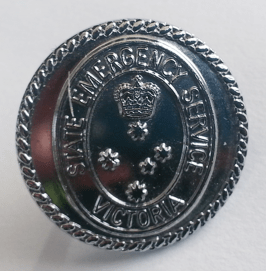
A. J. Parkes
The Victoria SES has its roots in the volunteer Civil Defence Organisation set up in 1950, to mobilise rapidly in the event of war. It was renamed in 1975 as the State Emergency Services, and has been involved in most major emergencies since 1950. It is an independent statuary body answerable to the State Minister for Emergency Services. “We are the control agency for flood, storm, tsunami, earthquake and landslide throughout Victoria, and provide the largest road rescue network in Australia, with specialist teams in 102 of our 149 units across the state. “
See https://www.ses.vic.gov.au/who-we-are
West Australian Hospital For Insane
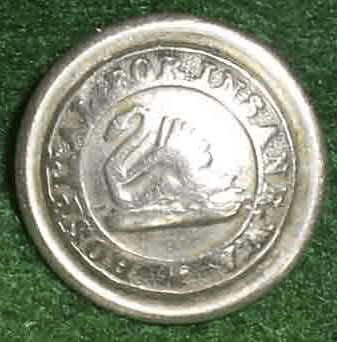
Patients were treated the Fremantle Lunatic Asylum from 1865, and also the Whitby Mental Hospital from 1897. These were described as not fit for purpose, so a new hospital was built in Claremont from 1903/4. The old buildings, from 1975 called Swanboure Hospital, were closed in 1986.
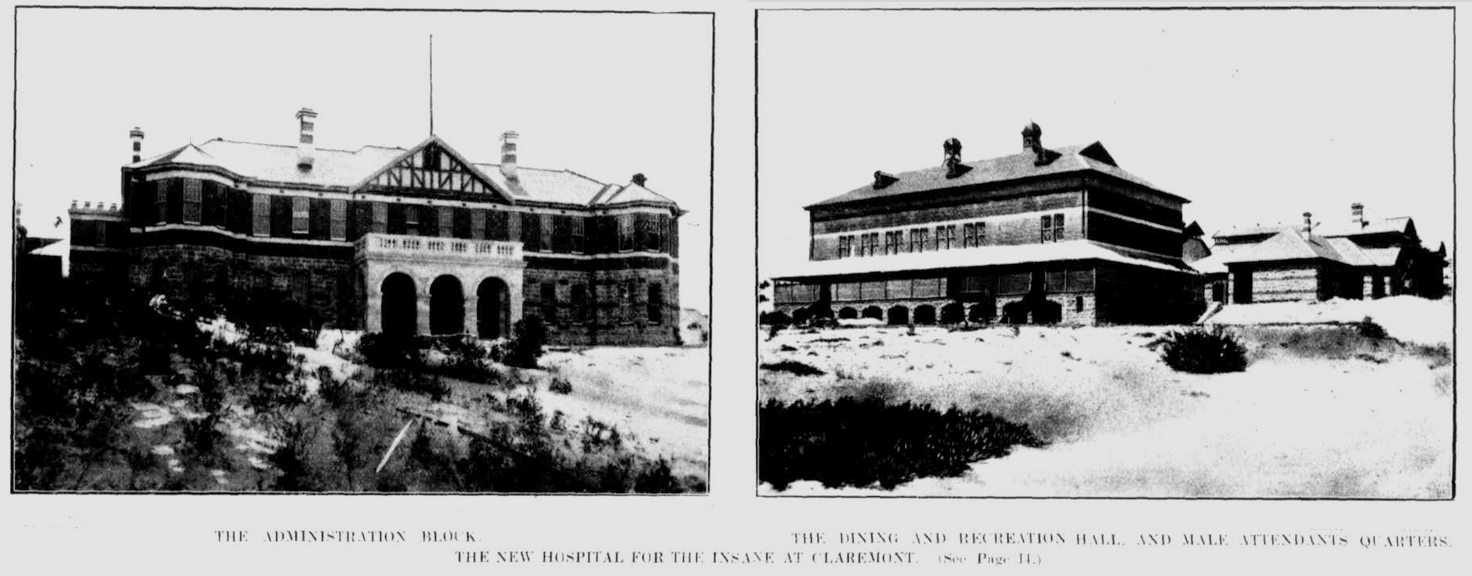
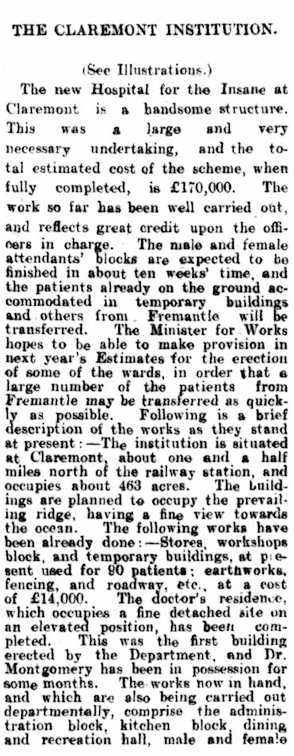
Western Mail (Perth), 3rd February 1906 page 14. The photos below come from an article in the same paper on 24th August 1912 page 6, entitled “How the State Cares for the Afflicted in Mind – The Hospital for the Insane at Claremont”.
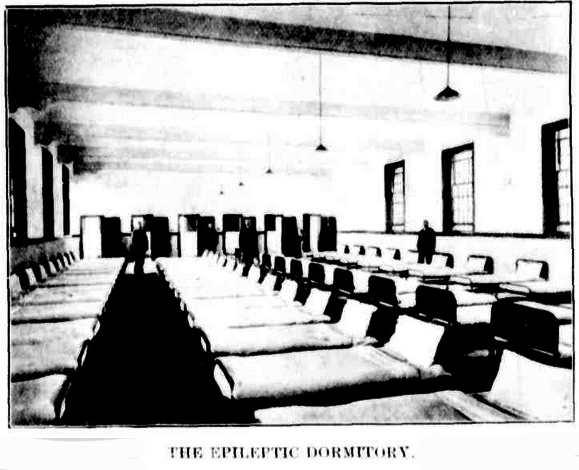
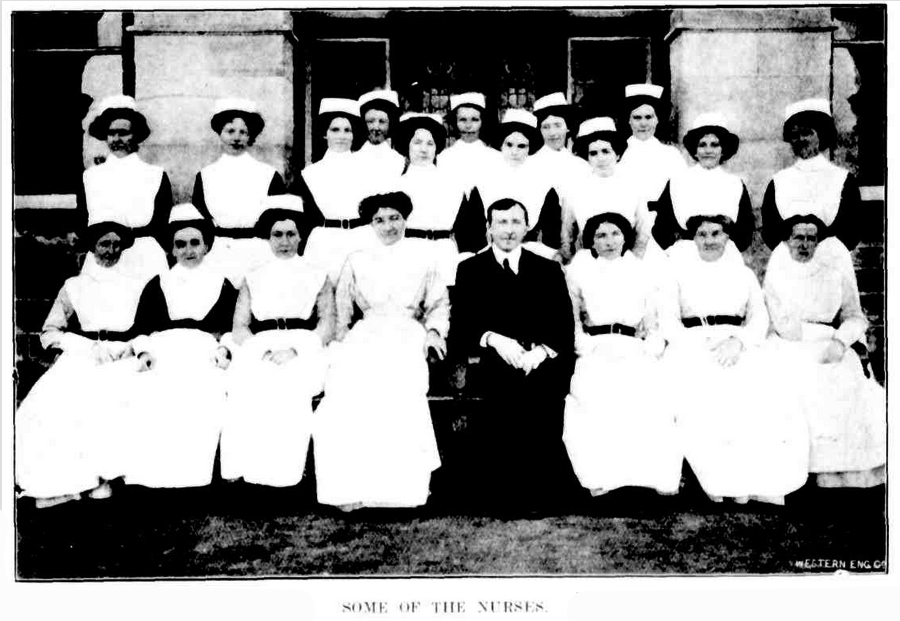
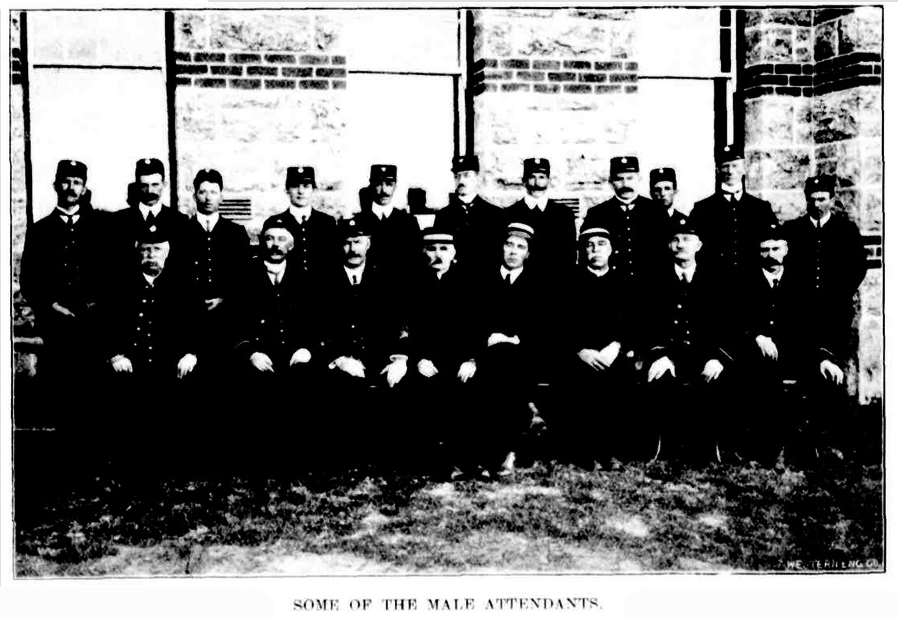
POLICE/CORRECTIONS & ENFORCEMENT
Australian Capital Territory Police
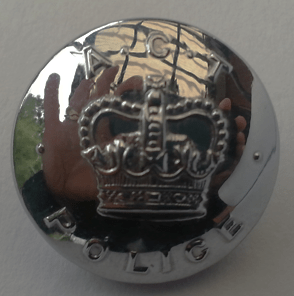
Stokes & Sons Melb
The Commonwealth Police (ACT) was renamed the Australian Capital Territory Police Force in 1957. See ‘Commonwealth Police’ below.
Commonwealth Peace Officer
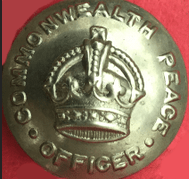
Stokes & Sons. King’s crown : button dates 1925-1952
The Commonwealth Peace Officer Guard (POG), established in 1925 to provide physical security at government locations across the nation, came under administration of the Commonwealth Investigation Service (CIS).
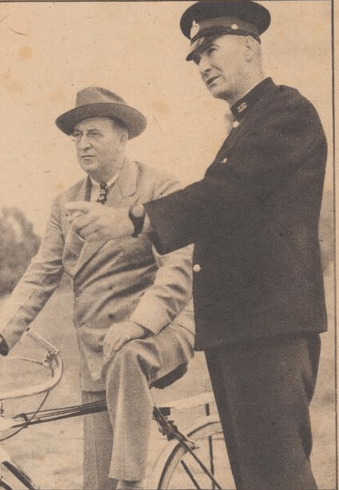
Pix magazine, 27th February 1943 page 4. A Peace Officer in Canberra directs a visitor.
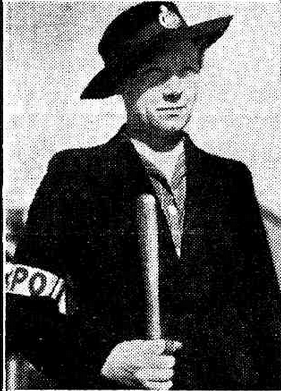
The Daily Telegraph (Sydney), 16th September 1942 page 9.A female Peace Officer with her regulation issue 9 inch baton.
Commonwealth Police Force
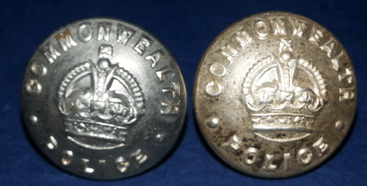
Stokes & Sons 1927-1952
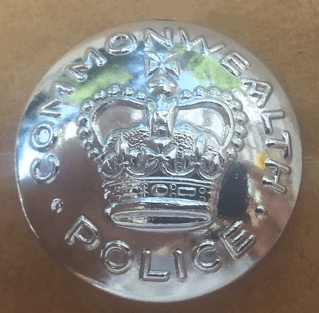
Stokes & Sons Melbourne 1953-1957
From 1927 until 1957 police of the Federal Capital Territory were known as Commonwealth Police (ACT) and the Kings Crown buttons likely belonged to this group ( There had been an earlier unit under this name.)

Commonwealth of Australia Gazette, 7th May 1964.
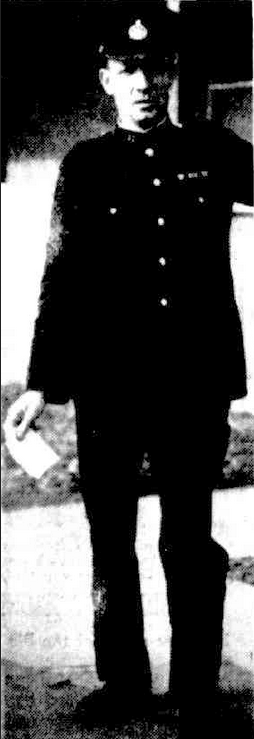
The Herald, 31st May 1935 p 12. A Commonwealth Police Officer.
The first Commonwealth Police:
In 1917 the pro-Conscription Prime Minister, Billy Hughes, who had been ‘egged’ whilst speaking in Queensland, became so fed up and distrusting of the state of Queensland (led by anti-conscription Premier T. J. Ryan) that he created a plain-clothed Commonwealth Police Force to ensure that Commonwealth law was adhered to in that “rogue” state and to report on “subversive” activities (i.e. those of groups that disagreed with his views!) This force was disbanded post WW1.
Her Majesty’s Goal NSW
See NSW Goal Warders
Her Majesty’s Gaol Tasmania
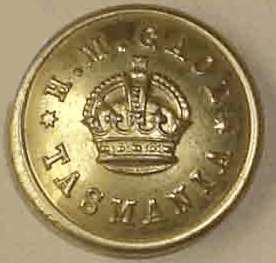
HM Goal Department replaced the Sheriffs Department in 1936 and was in turn replaced by the Goals Department in 1944. It was responsible for the Campbell Street Goal in Hobart as well local goals and watch houses.
Native Police
A button in the MAAS museum has an unique, if troubling, Australian story.
According to the description given in Trove, it dates to 1842-1856: ‘The name ‘New Holland’, which was not widely used to describe Eastern Australia after 1840, suggests that the button dates from the early years of the native police. If so, the button would come from either the native police force that operated in Port Phillip until 1852, or more likely the force that operated in the northern frontier of N.S.W. from 1848.
See: https://collection.maas.museum/object/85030
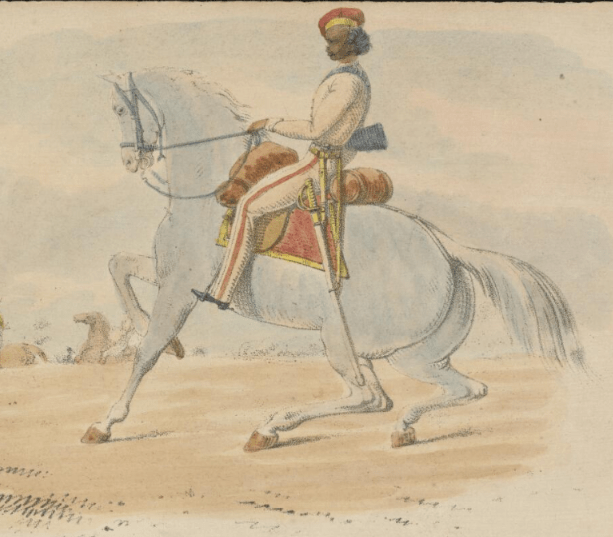
From the Illustrated Australian Magazine in 1851. Artist Thomas Ham https://nla.gov.au/nla.obj-136207439/view
The British used armed indigenous forces throughout their colonies. Native patrol troops, usually under a white officer, were used as cheap, brutal and effective forces. Such troops were set up in all mainland colonies of Australia in the 19th century. Troops were recruited far from where they were to be deployed to ensure lack of tribal sympathies and to provide a disincentive against desertion. The use of native troops was also a clever ploy to reduce revenge attacks against white settlers.
The first government funded troops were in the Port Phillip District from 1837. It was hoped that this employment would have a civilising effect for the aboriginals. Unfortunately these troops were used to commit violence and to aid in the dispossession of the aboriginal people. Colonisation of the mainland would have taken much longer without these troops. Eventually, the use of these troops were called into question, but not before decades of murderous behaviour.
See also:
https://www.qhatlas.com.au/content/native-police
http://aboriginalhistoryofyarra.com.au/8-native-police/
https://archaeologyonthefrontier.com/2020/09/03/buttons/
Naval Dockyard Police
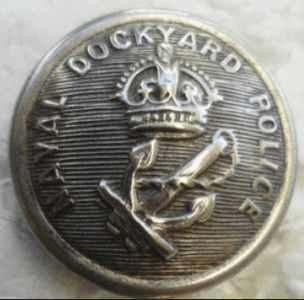
Stokes & Sons
The Naval Police formed in 1913, called at that time the Naval Dockyard Police, although they were civilians, and had no real police powers, but did guarding duties. During WW1 they took on counter espionage. They did not cease to be a civilian organisation and become auxiliary of the Navy until 1923, when they also were given statuary powers. They remained an auxiliary until 1972 when they become part of the navy proper. They were then renamed Naval Police.
New South Wales Department of Correctional Services
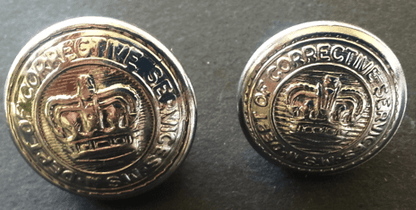
Amor Sydney
The term “Department of Correctional Services” dates from 1970-2009. As Amor became Amor-Sanders in 1978, perhaps these buttons date prior to then.
New South Wales Goal Warders
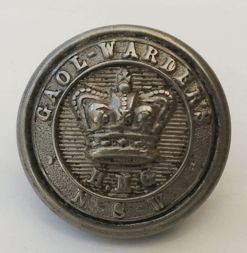
Firmin London.
The Queen Victoria crown, plus the “H.M.G.” for Her Majesty’s Gaols, indicate this button dates pre-1902.
New South Wales Police Pipe Band
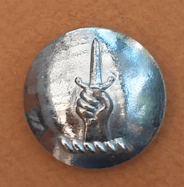
Stokes & Sons Melbourne.
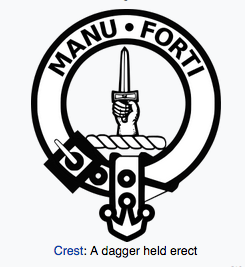
From Wikipedia
Started in 1946 by Commissioner William John Mackay, in his honour it has adopted the Mackay tartan and used the crest on the buttons. Unfortunately, the band was made redundant in July 1989.
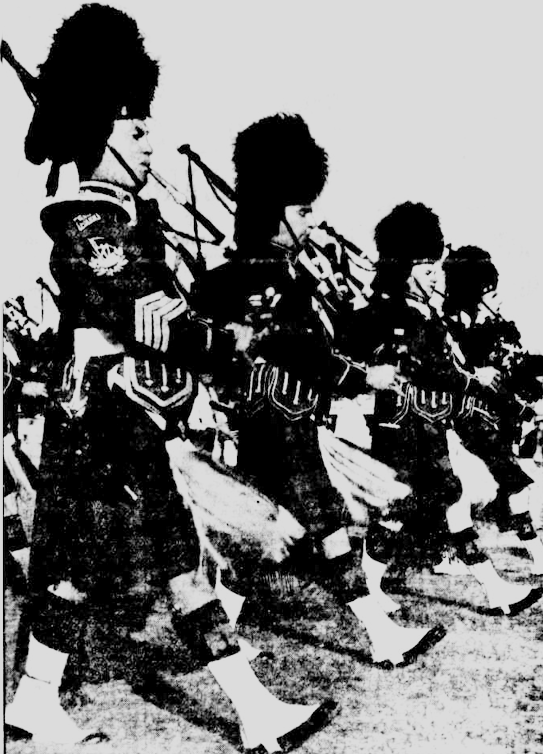
The Courier-Mail (Brisbane) 2nd January 1954 page 4. NSW Police Pipe Band members.
New South Wales Police
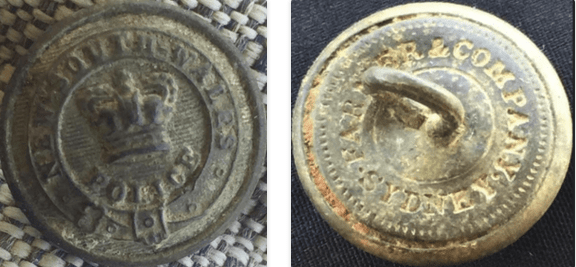
QV crown. Farmer & Company Sydney
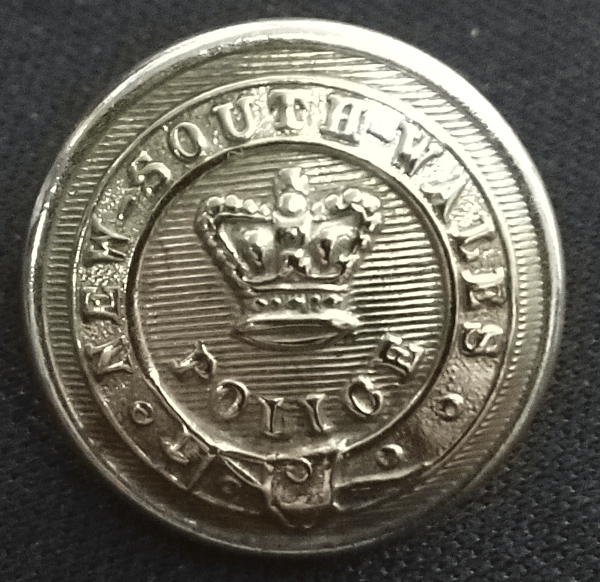
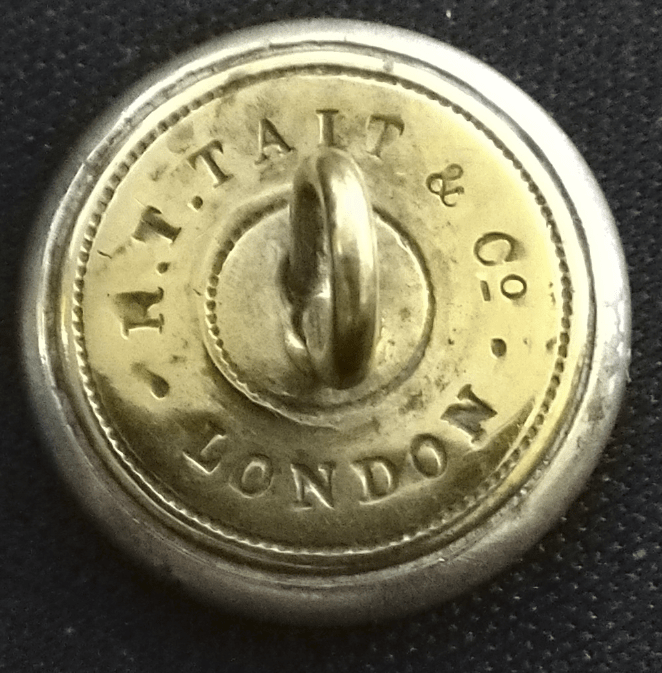
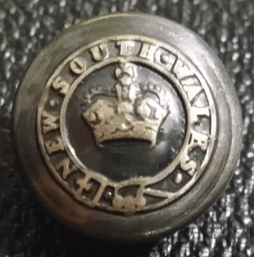
Amor Sydney.
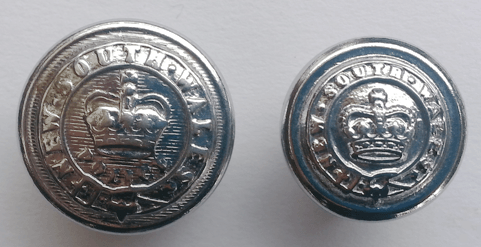
Both by Amor Sydney. The button on the right (and above) is not marked ‘POLICE’ but presumably is.
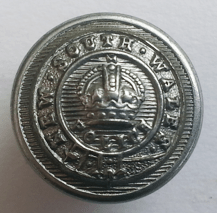
K. G. Luke Pty. Ltd. Melb NSW Police, King’s Crown
The origin of policing in New South Wales was the use of marines who came with the first fleet in 1788, followed by the short lived appointment of a civilian constable, Mr. John Smith. This was followed the next year by the appointment of trusted convicts to the role of Night Watch which in turn became the Sydney Foot Police. Early policing was to protect Sydney from thieving and petty crimes after dark. In 1862 all the colonial police forces, such as the Gold Escort and the Mounted Police, were amalgamated.

The Sun(Sydney), 16th May 1911 page 5.
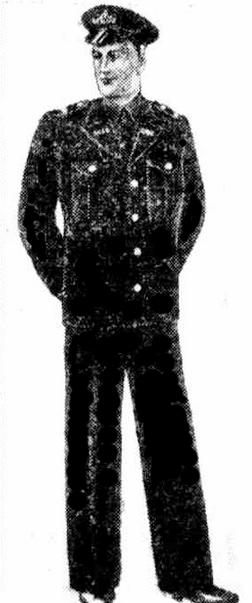
The Sun (Sydney) 13th August 1944 page 2.This modern uniform was released in 1944, having been delayed for 2 years due to demand for service uniforms.
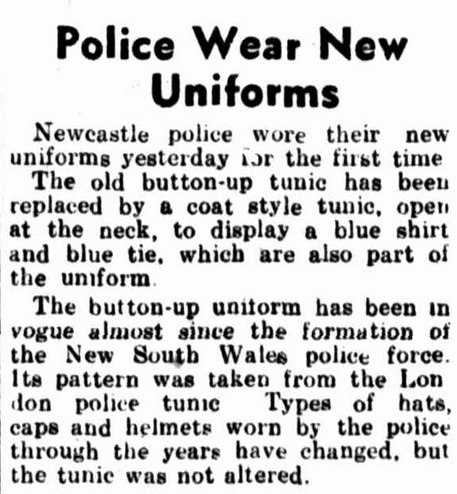
Newcastle Morning Herald and Miners’ Advocate (NSW), 3rd September 1947 page 2.
NSW Prisons Department
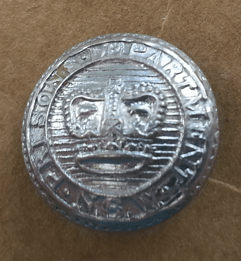
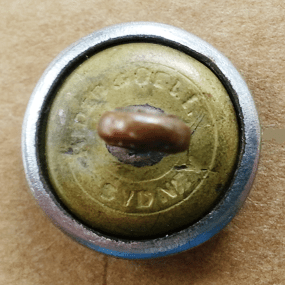
Northern Territory Correctional Services
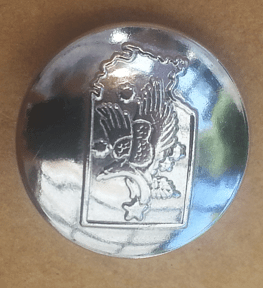
This is for Northern Territory Correctional Services, a title used since at least 1978.
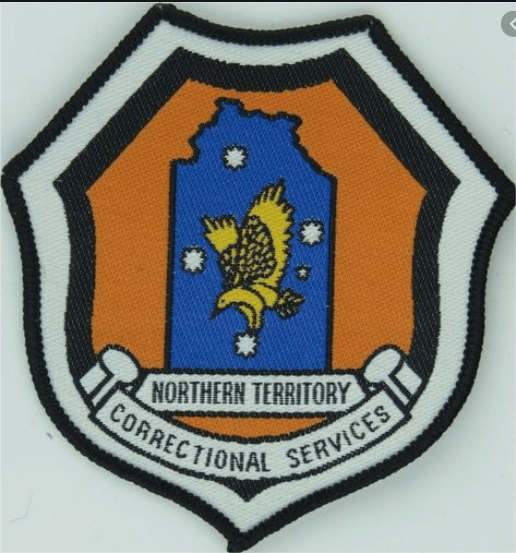
The MAAS museum has a hat badge with the Australian Coat of Arms with the title “N.T.PRISONS” underneath, from the 1940s. https://collection.maas.museum/object/304341
Recent photos show prison staff wearing a khaki shirt with a silver button on each pocket.
Northern Territory Police
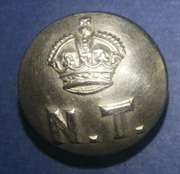
Stokes & Sons.
The current Northern Territory Police force started in 1911. Before that the Territory was served by South Australian Mounted Police from 1870 and the Native Police Corps from 1884. Wikipedia notes they have 70 stations and shopfronts, 3 boats, 1 helicopter, 23 horses and 72 camels!
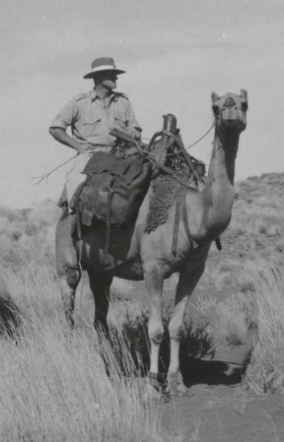
Camel Patrolman, 1949 reference: PIC/11104/7 LOC Box PIC/1110
Protective Service Officer, Victoria Police

A. J. Parkes Brisbane. Gilt.
PSOs have provided security services in Victoria since 1987 to guard places such as the law courts in Melbourne; the Victoria Police Centre, St Kilda Road Police Complex, Parliament House, Treasury, the Shrine of Remembrance, and 121 Exhibition Street (Department of Justice). In 2011 legislation was amended to allow for PSOs to patrol train stations and trains after 6pm each day. recruits undertake training at the Police Academy.
Queensland Police Force
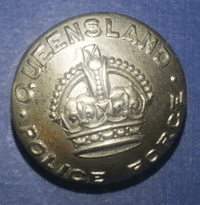
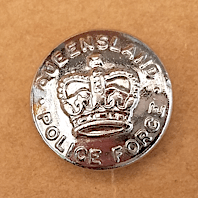
Queensland got its own force in 1864, the year of the state’s separation from New South Wales. It was not until 1931 that 2 women were appointed to the force.
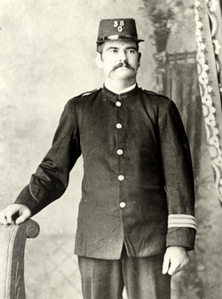
From the Queensland Police Museum. An unknown office 1881. (image no oai:ehive.com:objects/553465, PM0378)
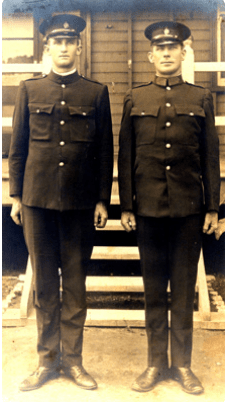
Two Queensland officers in 1913. Both enlisted and died during WW1.
Queensland Prison Department
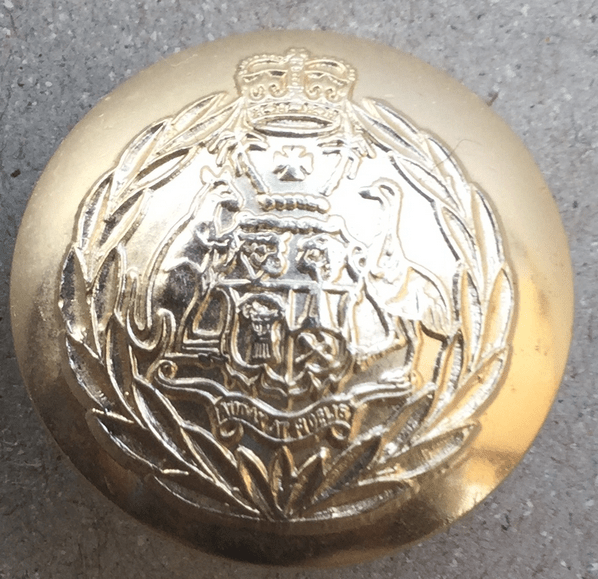
From Carol. Stokes Melb.
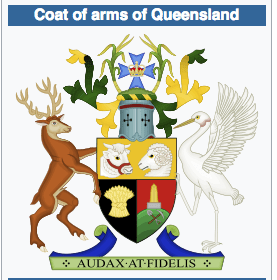
Queensland Coat of Arms.
It has the Queensland Coat of Arms, but with the wrong supporters; i.e. the animals are the kangaroo and emu as on the Australian Coat of Arms, not the red deer and brolga. The department was known as the Queensland Prison Department from 1891 until 1988. This button was worn in the 1970-80s. It is now known as Queensland Corrective Services.
South Australian Penal Establishment
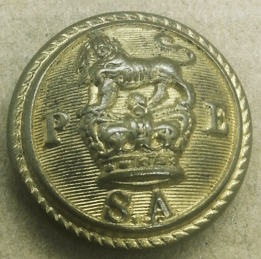
Backmark: Harrison & Smith Birmingham. c 1875.
South Australia’s first permanent prison was built 5 years after it was settled in 1841 in Adelaide. In 1853 another prison was built in Northfield (“The Stockade”) next to a quarry for the prisoner’s to be used for labour. By 1870 there were 7 gaols in the colony.
South Australian Police
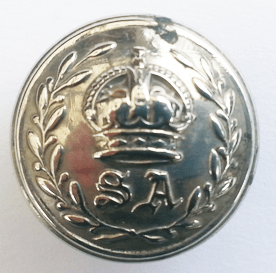
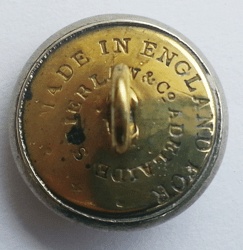
Made in England for Shierlaw & Co Adelaide.
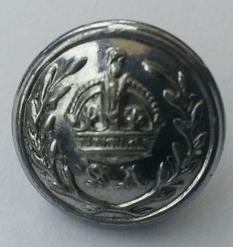
Stokes & Sons
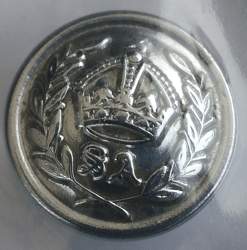
A. J. Parkes
This force was formally established in 1838, making it the oldest in Australia, and third oldest worldwide. Being a ‘convict free’ colony, its force did not start with former convicts or soldiers. It pioneered the used of fingerprinting in Australia, and had the first women police in the Commonwealth in 1915.
According to John White (retired SAPOL and member of the South Australian Police Historical Society), “Unlike other police forces in Australia that had specific ‘police’ designed uniform buttons, South Australia Police only used a generic ‘SA’ button which was also adopted by other South Australian government agencies, such as the then SA Gaols and Prisons Department (later renamed SA Correctional Services). Other than the buttons used on the 1854 Garibaldi jacket, SAPOL uniform tunic buttons have remained the same design (except for the change from a King’s to Queen’s Crown in 1974) since their introduction in the 1840’s and up until the present time. Only two sizes of buttons have been used, they are, large and small. Generally, the small buttons were used on the Mounted Police and Junior Constable/Cadet tunics and the large on the Foot Police and general duty uniforms. The use of the Monarch’s crown in South Australia is an interesting one. In 1951 then Police Commissioner Ivor Green designed a new police cap badge to replace the then existing Brunswick style South Australia Police cap badge. The new badge featured the State’s piping shrike bird emblem and a King’s Crown. The badge featured the King’s Crown in anticipation of the Royal visit to Adelaide by King George the 6th in 1953. The new badge was issued in 1951 to all police officers. Unfortunately the King died in 1952 and was replaced by Her Majesty QEII. The problem for SAPOL was that a considerable amount of money had been spent on the new badge with the King’s Crown and SAPOL was not in a financial position to issue a replacement badge with the correct Queen’s Crown. It did not seem to worry SAPOL or the State Government that we were using the wrong crown and in the ensuring years the Piping Shrike badge with the King’s Crown continued to be manufactured and remained in use along with the King’s Crown uniform police buttons. It was not until Commissioner Harold Salisbury from the UK was appointed Commissioner of Police in 1974 that it was pointed out to him that we were using the wrong crown. It was then decided from that time onwards that any new batch of cap badges and buttons manufactured were to feature the Queen’s Crown. As a result from 1974 all new recruits were issued with the Queen’s Crown cap badge and buttons, however, the King’s Crown badges already on issue to members were not withdrawn and remained in use along with the Queen’s crown version until both badges were withdrawn in 1998 and replaced by the current cap badge.”
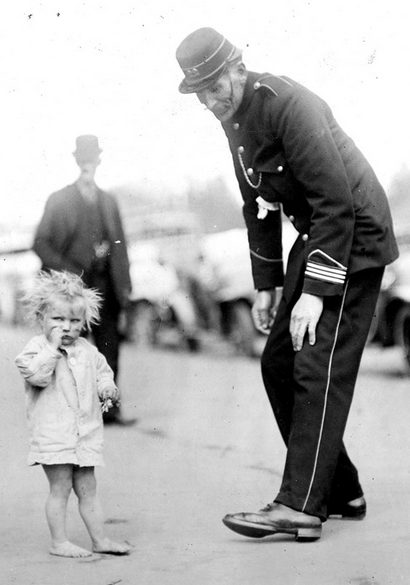
Officer approaching lost child in Adelaide. 1913. https://collections.slsa.sa.gov.au/resource/PRG+280/1/7/480
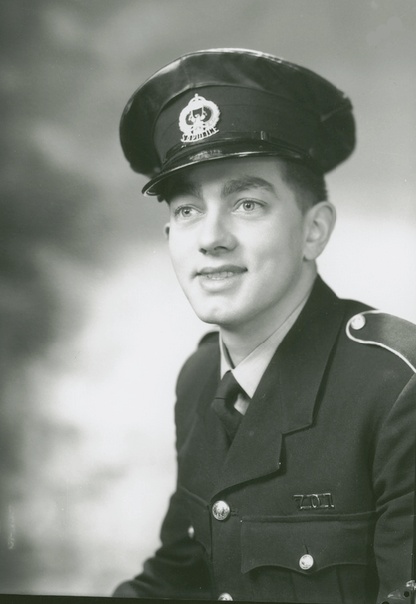
SA Police Officer in 1955. Detail of button below. https://collections.slsa.sa.gov.au/resource/BRG+347/5590
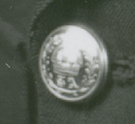
Tasmania Police
Tasmania had a chequered history with regards to policing. Convict watchmen were replaced by military patrols, then by martial law and increasing numbers of constables, but crimes and bush-ranging remained out of control. In 1828 Lt-Governor Arthur established 9 police districts with centralised control in Hobart. However, as most police were convicts, there were abuses of power and so around 1858 the people demanded a decentralised system with non-convict police.
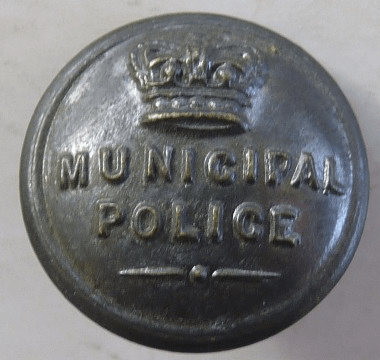
These were used by some of the minor municipal controlled police forces c.1858-1898
Twenty Municipal councils controlled their own police, with non-municipal areas divided into 8 policing districts. As councils wished to reduce costs, this lead to poor police wages and/or reduced police numbers. It also meant that there was uneven policing as councillors expected favourable treatment! The councils relinquished control, and in 1898 a Police Regulation Act created a state wide force under a commissioner and answerable to Parliament.
http://www.austbuttonhistory.com/uncategorized/9th-november-2020/
Hobart City Police.
Launceston Municipal Police
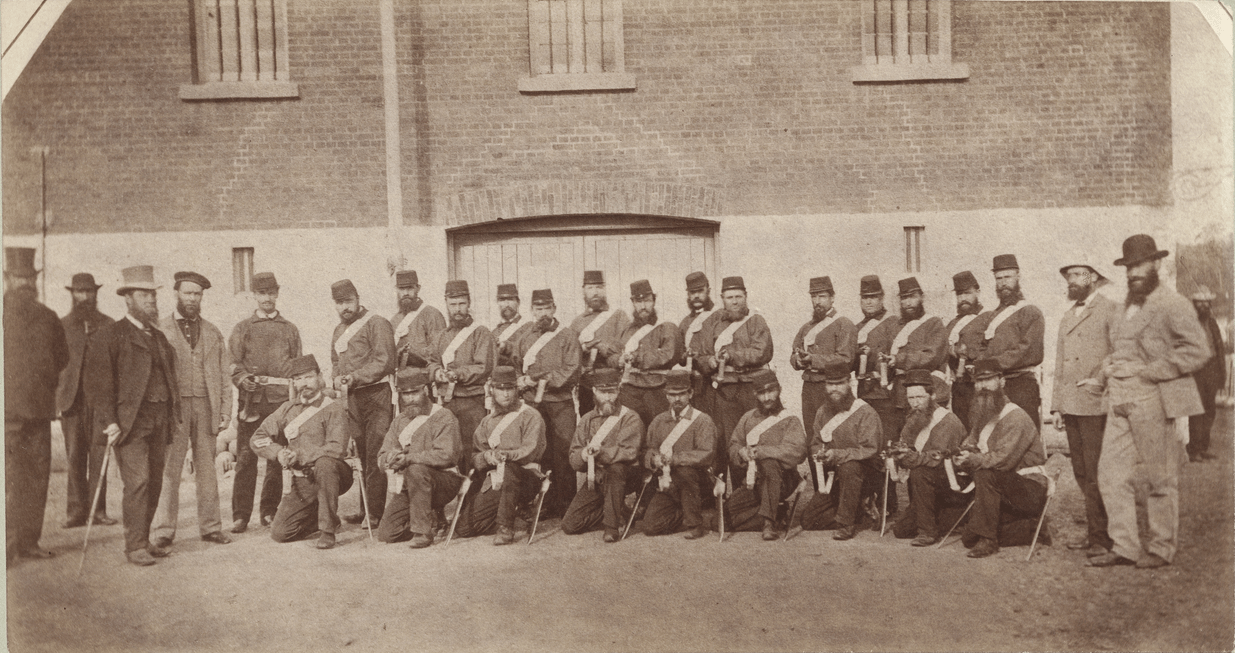
Libraries Tasmania: Record ID: SD_ILS:615595 Launceston Police 1876.
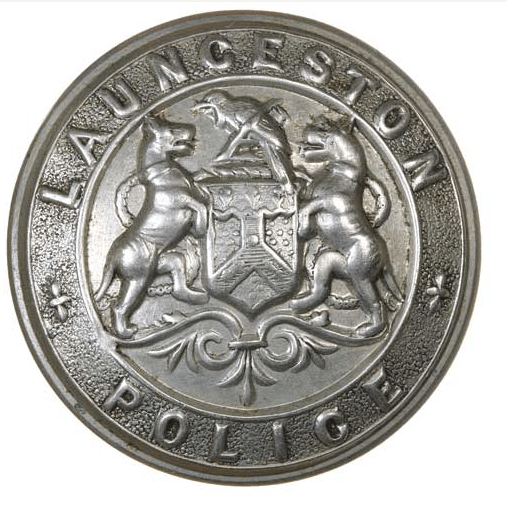
Launceston Municipal Police, 1889-1898. (Launceston was declared a city in 1889, This button has the City’s coat of arms on it.)
Port Arthur Police
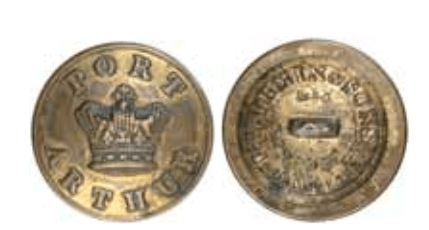
Thanks to Noble Numismatics. c 1850.
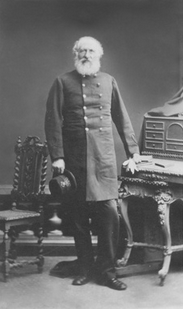
Superintendent of Hobart Police 1879. (National Trust of Tasmania).

Stokes & Sons
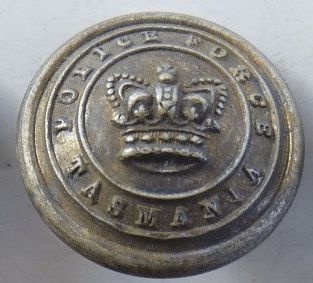
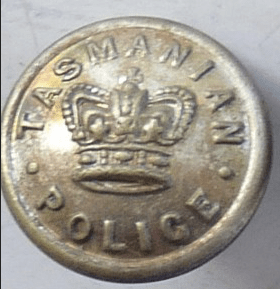
These 1898-1901 buttons vary: some have ‘Tasmanian’ on the top of the crown, some underneath.
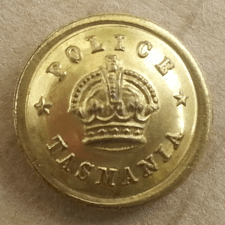
Stokes & Sons.
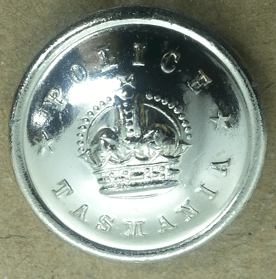
Stokes & Sons Melb. 1953 (Anodised aluminium but King’s Crown).
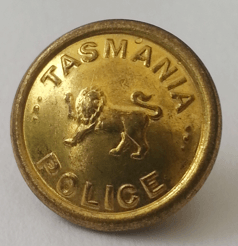
Stokes Vic ?post 1962.
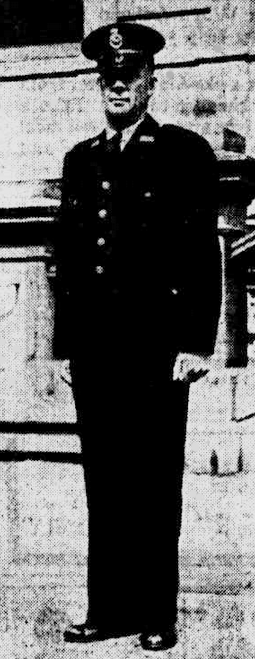
Examiner (Launceston) 23rd February 1945 page 4. The new uniform.
Victorian Penal Department
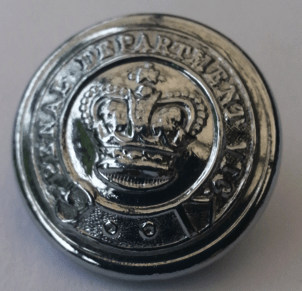
Stokes & Sons
The Penal and Gaols Branch of the Chief Secretary’s Department was formed in 1870, and took over the running of Melbourne Gaol and all other Victorian gaols from the Sheriffs department. It lasted until 1960.
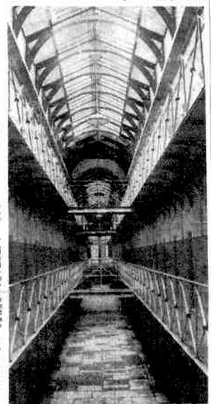
The Herald (Melbourne) 11th September 1954 page 1.Division B, Pentridge.
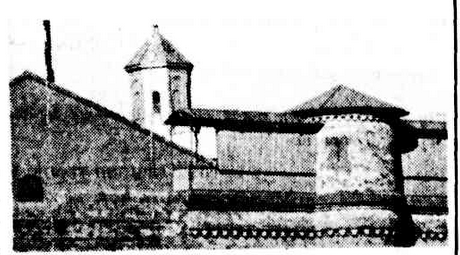
The Argus (Melbourne) 27th October 1954 page 4. Pentridge.
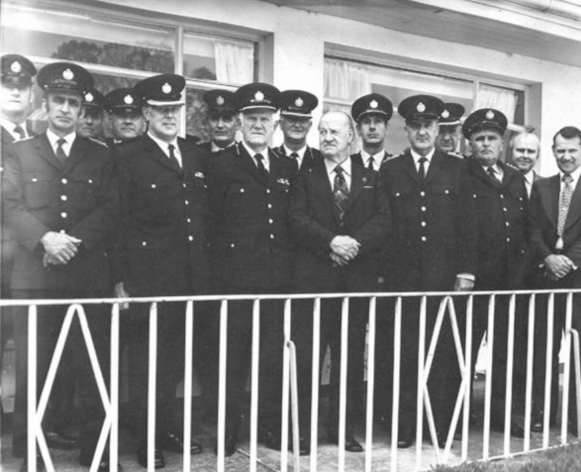
With permission from Coburg Historical Society, photo 14793. Prison Officers 1975. See http://coburghistoricalsociety.wordpress.com/
Victorian Police Force
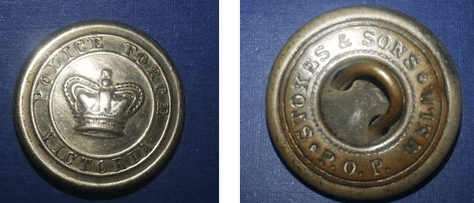
Stokes & Sons P.O.P Melb, QV crown button date 1893-1901.
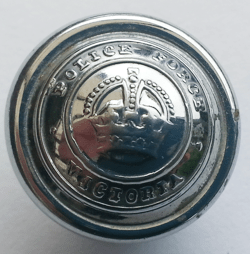
K. G.Luke Pty Ltd Melb, Kings crown
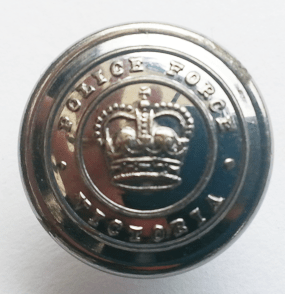
K. G.Luke A/Asia Ltd. Queens crown
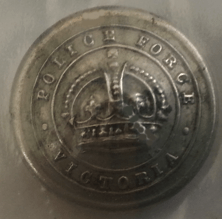
Stokes & Sons
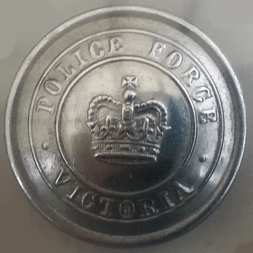
Stokes & Sons Melb
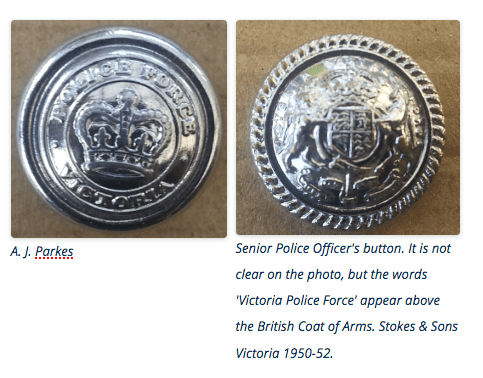
The Victoria Police was formally established in 1853, although there had been constables from 1840. It was the first colony to merge all its police into one force, and the only one to this day to do so under a Chief Commissioner of Police.
The first woman to be part of the Force was Madge Connor in 1917 as a ‘police agent’. Women became full police officers in 1924, although it took until 2001 for a woman to be appointed Chief Commissioner.
The only strike by any Australian Police Force occurred in 1923, with resulting riots and looting in the city.
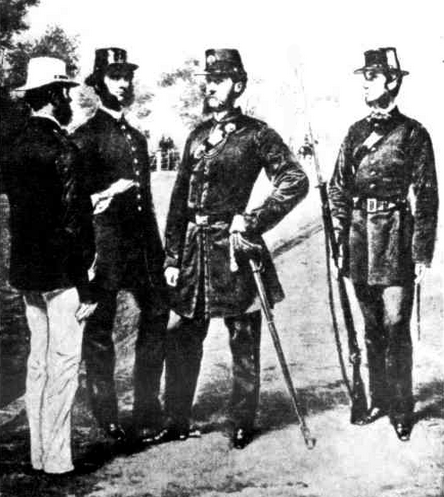
The Australasian (Melbourne) 4th April 1903 page 26.Victorian Police,Late 1850s.
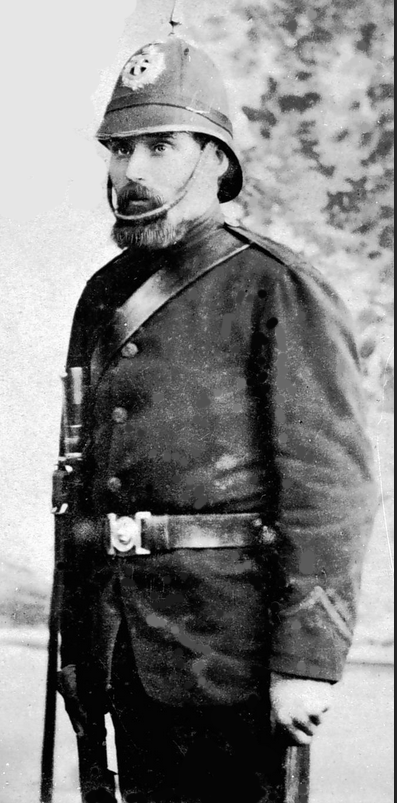
Ballarat Officer, c1880. https://collections.museumsvictoria.com.au/items/772772
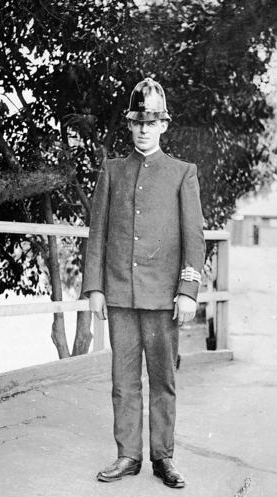
Officer c.1905
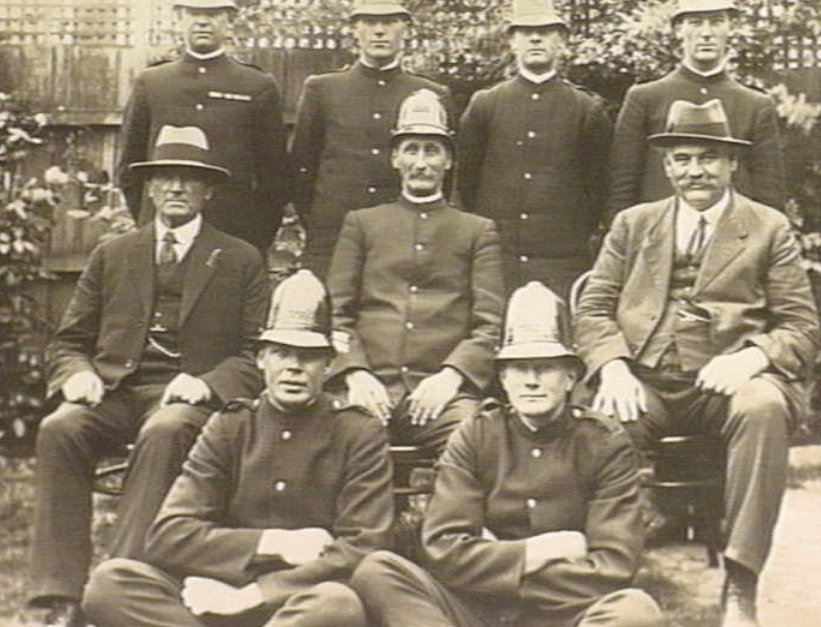
State Library Vic # a15989. Officers from the Elsternwick station, 1924.
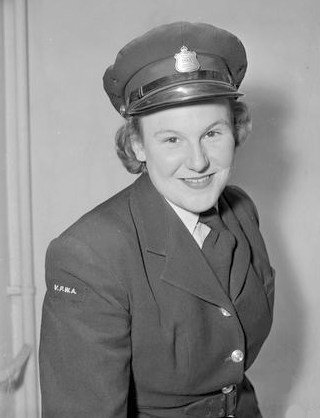
Victoria Police 1953 with detail of button below. Museum Victoria https://collections.museumsvictoria.com.au/items/1709830
Victoria Water Police
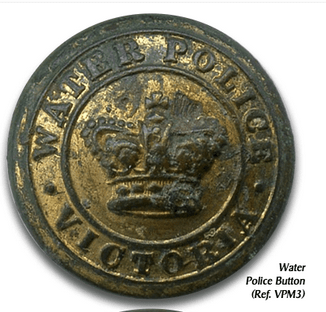
The backmark is MASON & CULLEY WILLIAMS TOWN, dating this button to 1852-1854.
From 1838 Water Police dealt with crime, looked for runaways and dealt with customs.
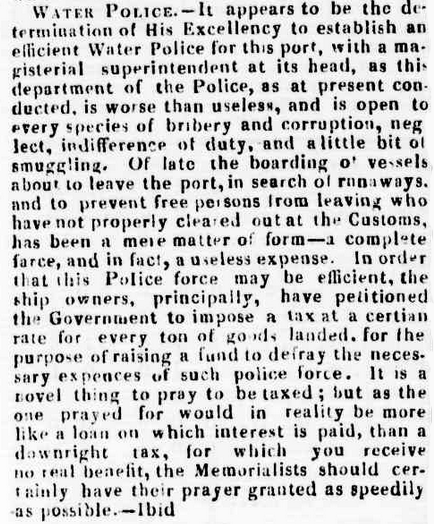
Port Phillip Patriot and Melbourne Advertiser, 10th August 1840 page 5.
Today the Water police manage law enforcement on the water, also search and rescue.
West Australian Penal/Gaol/Prison/Correctional Services
The Swan River Colony, also known as the Swan River Settlement, was established in 1829 at the location that would soon be known as Perth. The colony formally became West Australia in 1832. Although some NSW convicts were sent to King George Sound in 1826 to help establish the new colony, convicts were mostly sent to the colony from 1850-1868.
Fremantle
Convicts were temporarily housed in a rented warehouse from 1850 until they built the Convict Establishment Prison ( built 1850-59). The old Fremantle Prison, also known as the “Round House”, was built in 1830-31, an eight cell prison with a gaoler’s residence. It was used for local and indigenous prisoners until 1886. In that year the Convict Establishment prison, (since renamed Fremantle prison) was returned to the control of the colony, and the Round House was then used as a police lock-up.
During the wars, Fremantle prison was partially used as a military prison and internment centre. The prison being long overcrowded, seven new prisons were opened in the State from 1960-1971, including a new women’s prison.
Fremantle Prison was closed in 1991, replaced by the new Casuarina Prison. The old buildings are now heritage listed.
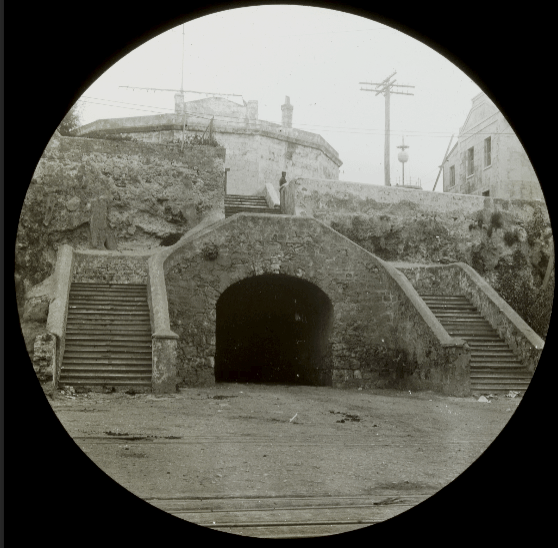
State Library Victoria BIB ID 2281130. Roundhouse prison.

WA Department of Agriculture, Water and the Environment. Drawing by Thomas ‘Satin’ Browne, 1864. The Convict Establishment Prison, later named the Fremantle Prison.

State Library Victoria BIB ID 1765192. Possibly the Fremantle Gaol.
Perth
A merchant ship that ran aground in the mouth of the Swan River in 1829 was used as a prison hulk. In 1830 A six cell lock-up in Perth was built. It was demolished in 1855 after the ‘old’ Perth Gaol was built to replace it.
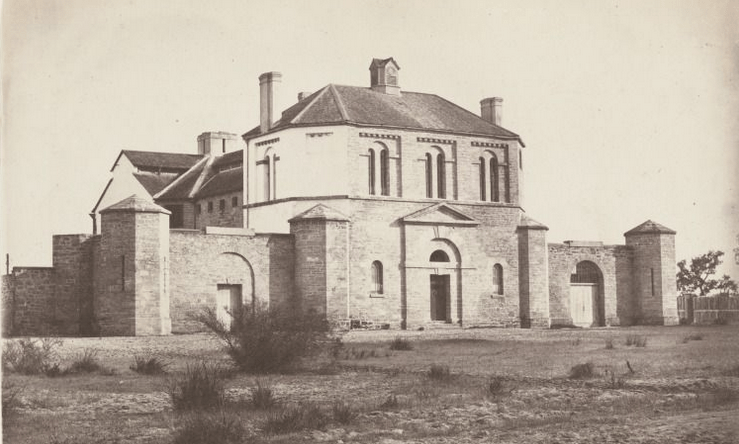
State Library WA image # 6923B/137. Perth Gaol, 1862.
The Goals Department was a sub-department of the Colonial Secretary’s Department from 1890. It was renamed the Prison Department in 1947, the Department of Corrections from 1972-82, the Prisons Department from 1982-87, the Department of Corrective Services (1987-93), the Offender Management of the Ministry of Justice (1993-2001) and the Department of Justice (2001-2006). Since 2006 it is the Department of Corrective Services. And every name change brings the expense of new stationary, buttons, etc, etc.
Below are various warder/prison staff uniform buttons.
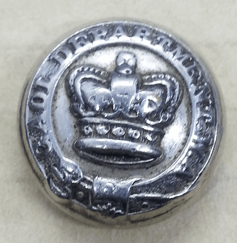
No backmark.
According to the State records Office of WA, a “Gaols Department” appears to be a sub-department of the Colonial Secretary’s Office by 1890. However, it dated as early as 1883.

The Daily News (Perth), 6th September 1883, page 3
In 1947 the Gaol Department was renamed the Prisons Department. The above button presumably dates from around 1890- 1901 due to the use of the “Queen Victoria crown”.
The button below is described as dating from 1930-40s, which does not fit in with the St Edward’s crown. During that era a Tudor (King’s) Crown would have been used. As it is backmarked ‘Sheridan” it would date from post 1952, and Elizabeth’s era.
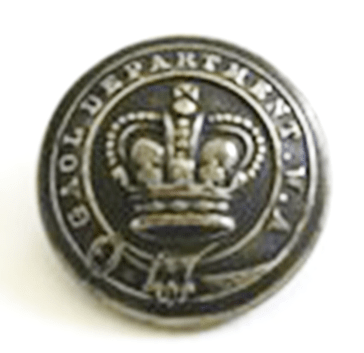
Fremantle Prison Collection, backmark: Sheridan 842 Hay St . http://mosaicweb.com.au/Collection/FremantlePrison/Item/1137511/UNIFORM_BUTTON_FOR_PRISON_OFFICER
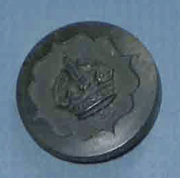
King’s Crown(1902-1953) Unknown dating of button.

King’s Crown with a GR (?V or VI) cypher so unknown dating of button.

Unknown dating.
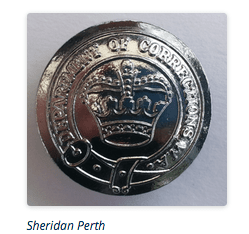
West Australian Department of Corrections. 1972-1982.
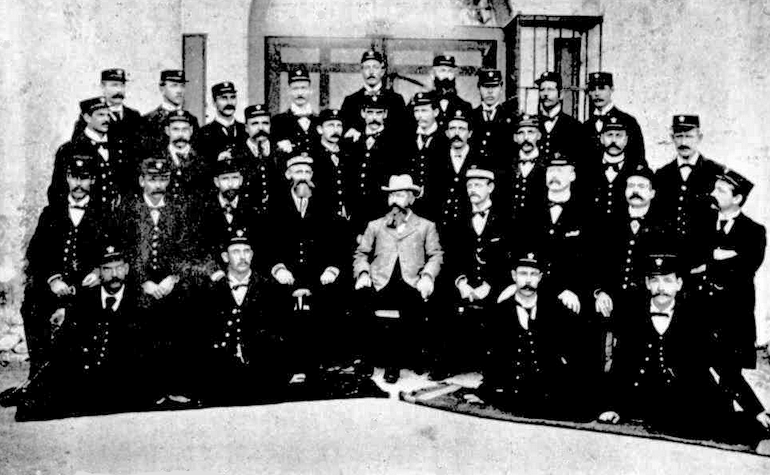
Western Mail (Perth), 26th May 1899 page 41. Group of Officials of the Fremantle Prison.
See also:
https://en.wikipedia.org/wiki/Convict_era_of_Western_Australia
West Australian K-9 Force
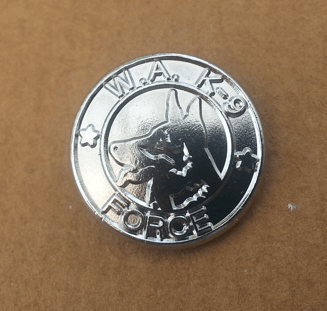
Mark: Sheridan Perth. The Canine Section of West Australia’s Police Force was started in 1993 with just two dogs.
West Australian Police Force
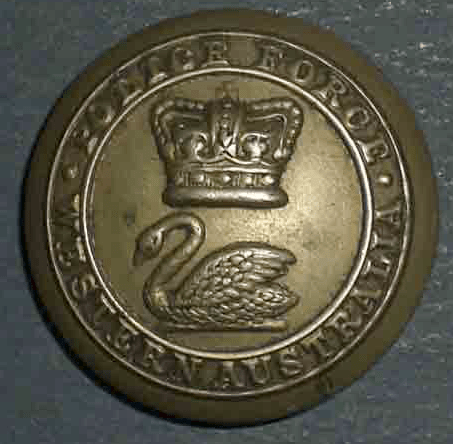
unknown maker
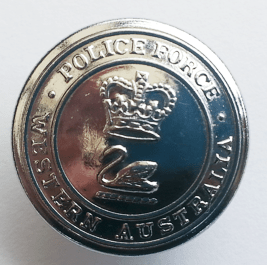
Sheridans West Australia Queens’s Crown post 1952.
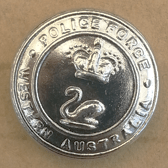
A. J. Parkes Brisbane
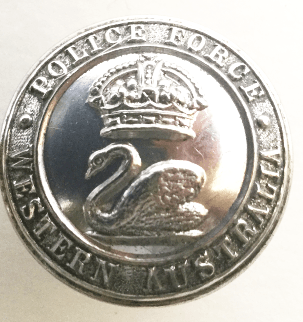
Stokes & Sons. Kings Crown 1902-1952.
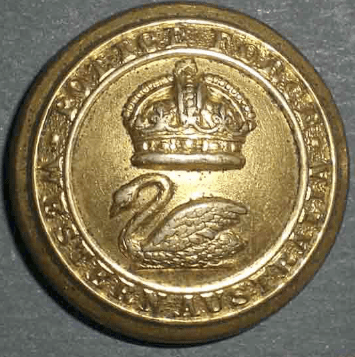
The West Australian Police Force formally came into existence in 1853, although there were part time constables, etc. from the origin of the colony in 1829. It is responsible for the largest single police jurisdiction of 2.5 million square kilometres.
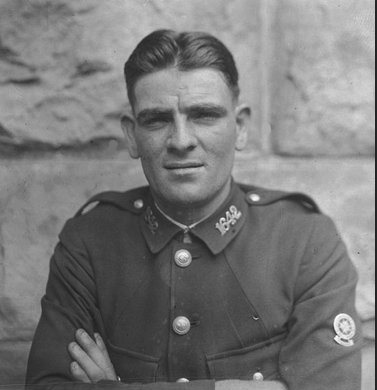
State Library of WA, photo ID 47861260. Police officer, 1928-9
WA Road Traffic Authority
This department existed from 1975-1982, in charge of traffic regulation, licensing and road accident investigation.
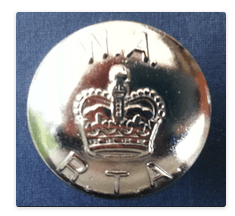
WA Traffic Inspector
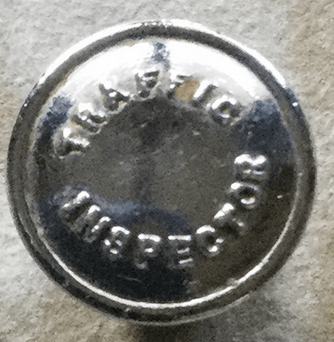
Sheridan Perth
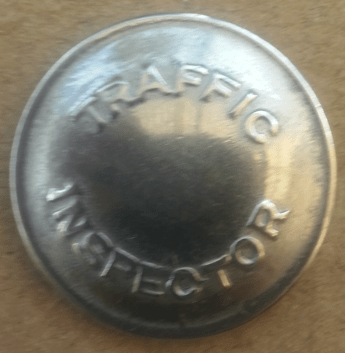
Perth Traffic Inspectors were first appointed in 1896. The inspector was to control traffic flow and safety, and to attend to speeding and parking offenses. They also investigated accidents. There were still inspectors in 1971.
POST OFFICE DEPARTMENTS
General Post Office, Melbourne
The General Post Office of Meblourne is located at the corner of Elizabeth and Bourke Streets. The inital construction was from 1860-1867, although several stages of extensions occurred through until 1919. The building is now a retail site.
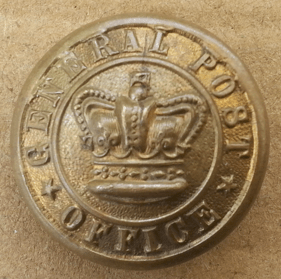
Backmark: Stokes & Sons, Melbourne
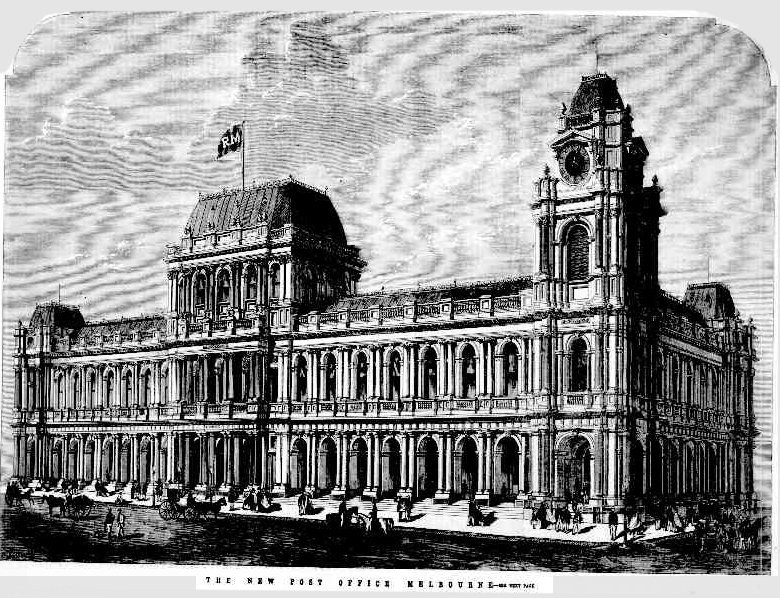
The Australian News for Home readers (Vic) 23rd February 1866 page 9.
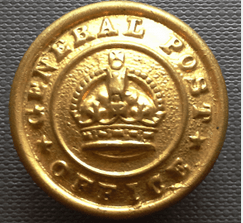
General Post Office; backmarked Stokes & Sons, Sydney.
The General Post Office in Sydney (up to 1996) stands in Martin Place, and was built from 1866-91. It is interesting that the staff that worked there had their own buttons, rather than just using Post Masters General Department buttons.
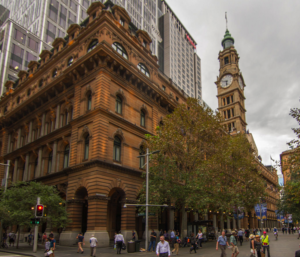
Post Office Victoria
These Post Office Victoria buttons date up to the year of Queen Victoria’s death in 1901.
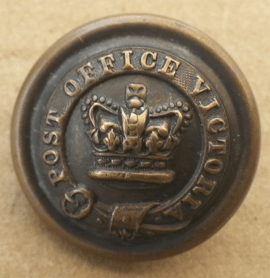
Backmark: Firmin & Sons London
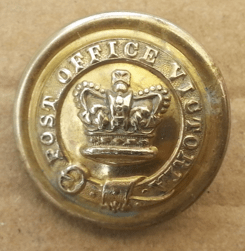
Backmark: Firmin & Sons London
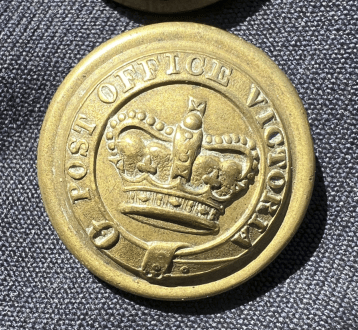
Stokes & Martin
Post & Telegraph/Post Office Tasmania
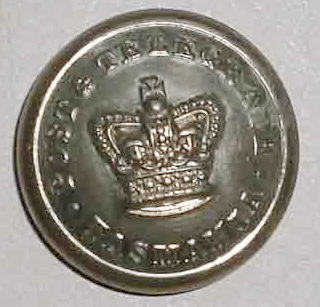
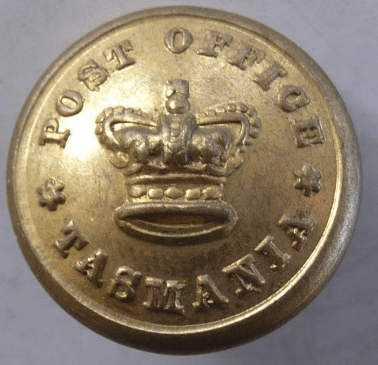
The ‘Post & Telegraph Department’ was reported in Tasmanian newspapers from 1892. However, telegraph was established in Van Diem’s Land as early as 1821, with “Post & Telegraph” offices built around Australia in the 1860s.
Following Federation the colonial post and telegraph services came under the control of the Post Master General’s Department. It was not until 1975 that postal services were separated from telegraphic communications when the PGM was split into Australia Post and Telecom.
Post Master-General’s Department
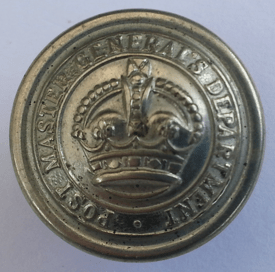
A. J. Parkes Brisbane
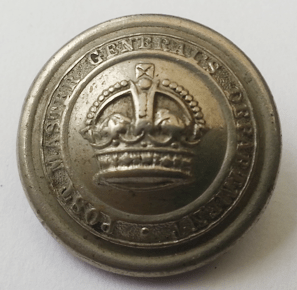
Stokes & Sons Melbourne
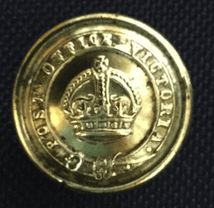
A. Bowley & Co Melbourne
This department took over control of the separate state postal and telegraph services on 1st march 1901 for the provision of postal and telegraphic communication throughout Australia, and continued until 1975, when it was replaced by the Postal and Telecommunications Department, which had two separate entities, Telecom Australia (later Telstra) and Australia Post.
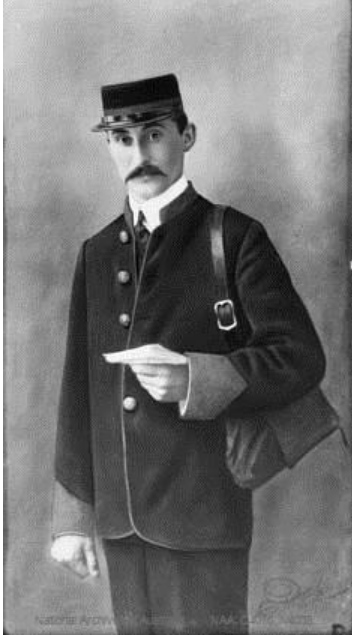
National Archives of Australia: photo of NSW postman c1905. Item barcode: 1650311.
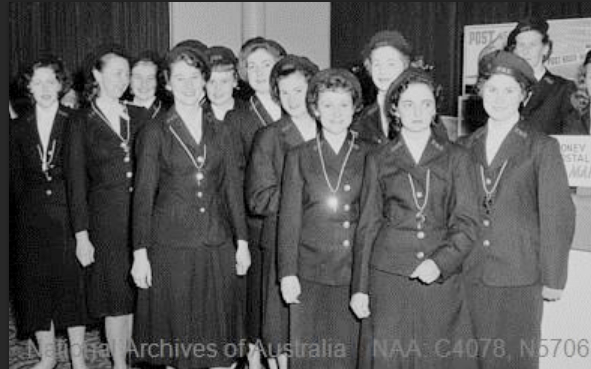
National Archives of Australia. Photo ID Image Number C4078:N5706. Women in Post Master-General’s department uniforms, 1954.
RAILWAYS
See under ‘Private companies’ for South Maitland Railways.
Commonwealth Railways
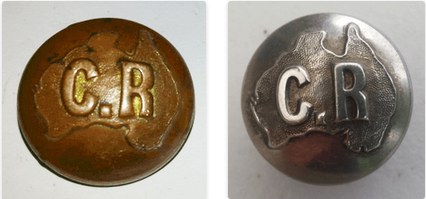
Stokes & Sons Melb
Commonwealth Railways was responsible for train services in the Northern territory, South Australia, Western Australia and New South Wales from 1917 to 1971 when it was absorbed into Australian National Railways. It included such famous trains such as the Trans-Australian, The Ghan and the Indian Pacific.

Chronicle (Adelaide) 15th January 1927 page 39. Special train en route to Oodnadatta.
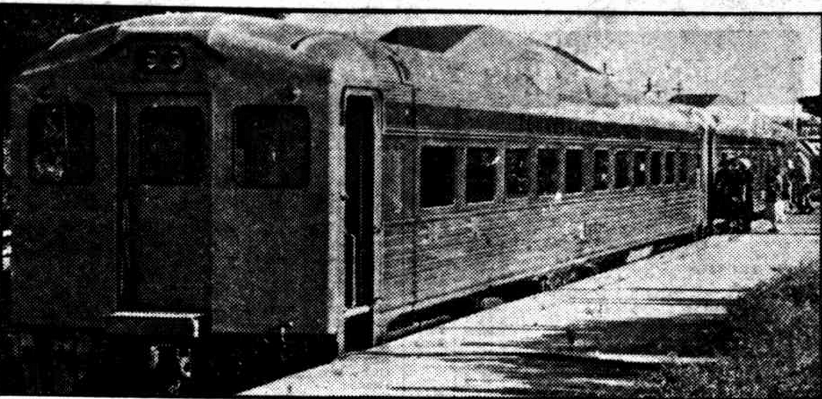
News, 10th April 19511 page 5. A new diesel-electric railcar for service in South Australia by Commonwealth Railways.
New South Wales Railways
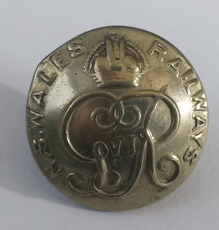
A. J. Parkes Brisbane George VI 1936-1952
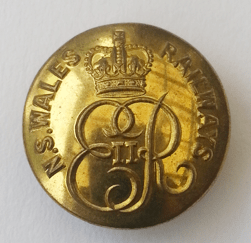
Stokes & Sons Melb 1953-1962 Elizabeth II cypher.

Backmark: Anderson Sydney British Make. Edward VII 1902-1910
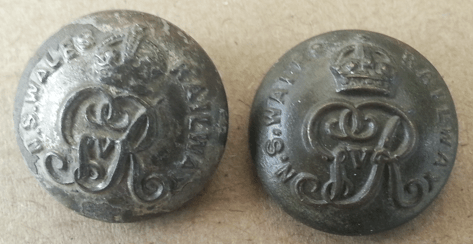
Backmark: Anderson Sydney British Make. Approx 17mm diam. George V 1910-1936
The New South Wales Government Railways was succeeded by the Department of Railways in 1932 through to 1972, which was followed by the Public Transport Commission.
The first public Sydney line was built in 1855. The network was electrified from 1926. As in other states, the freight business has been privatised.

State Library NSW # YRlBl2qn New Uniforms for the NSW Railways in 1939.
The NSW Railways ran ‘The Season Ticket Shop’. The staff may have used the following buttons.
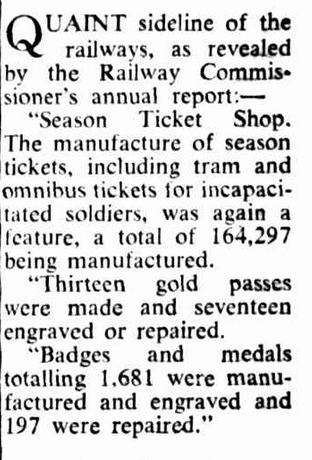
The Sydney Morning Herald, 16th November 1954 page 1.

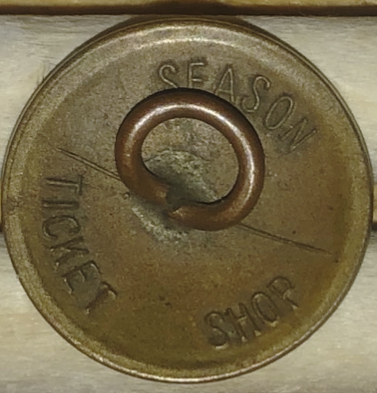
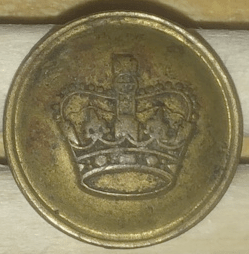
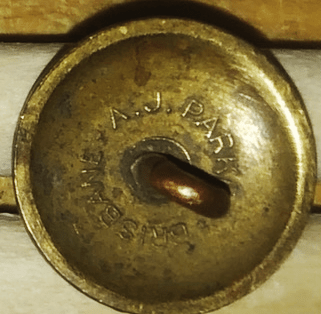
CityRail
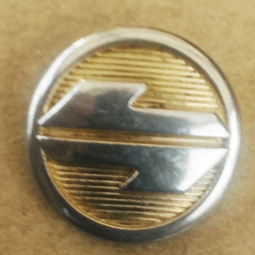
No backmark.
CityRail was the branding of passenger services in Sydney, Newcastle and Wollongong from 1989-2003. In was superseded by Sydney Trains and NSW Trainlink. The logo on the button was used until 2010.
Queensland Railways
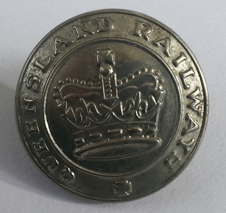
A. J. Parkes Brisbane
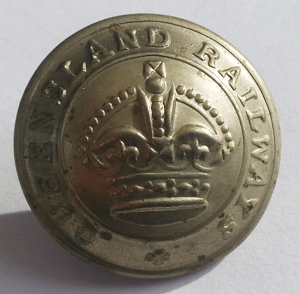
A.J. Parkes Brisbane
Rail transport was a priority for the young colony of Queensland. The first (narrow gauge for cost and speed of construction) line was built in 1865.
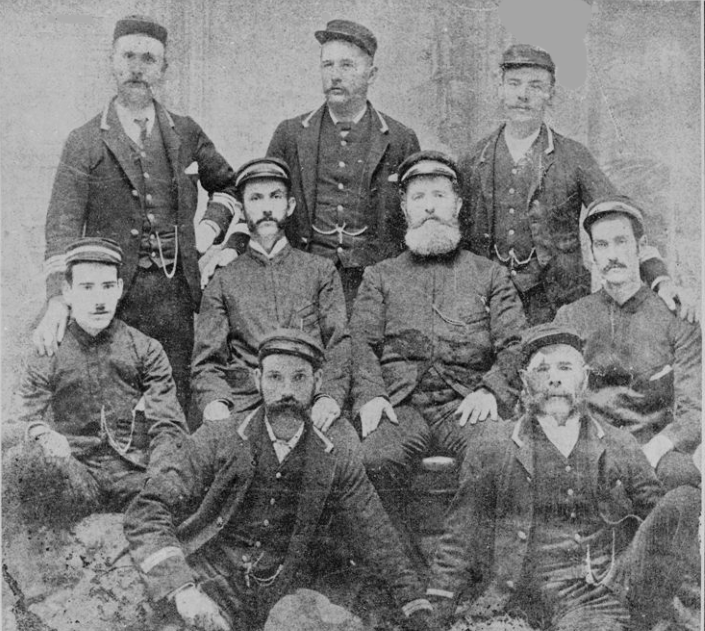
State Library Queensland, ID 66947711. Northern Queensland Railway men, 1880s.
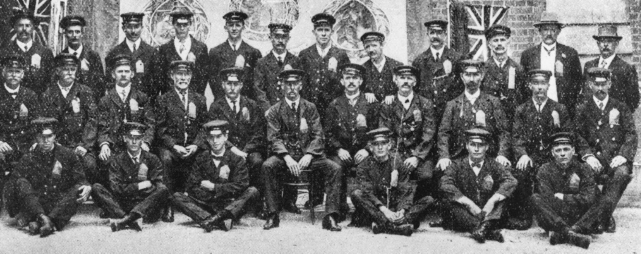
State Library Queensland; ID 66911589. Detail from photo of Brisbane railways staff 1912.
The network reached its peak in 1932, with branch lines closing from 1948 onwards. The suburban network did not start to be electrified until November 1979, replacing the diesel-electric fleet. It was rebranded QR in 1999. As in other states, the freight business has been privatised.
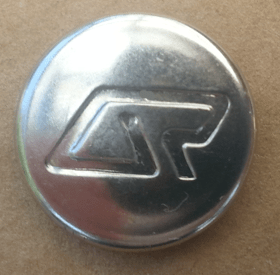
No backmark
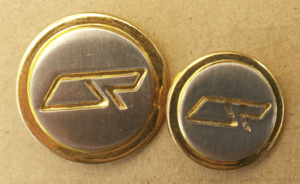
Queenslandrail was rebranded as QR in September 1999. It operates local, long distance, interstate and freight services.
South Australian Railways
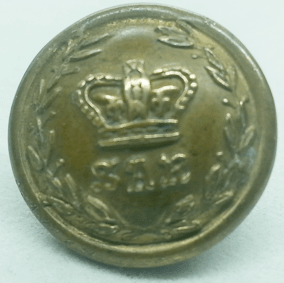
A. J.Parkes Brisbane: 1899-1902
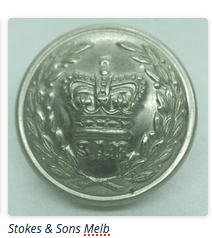
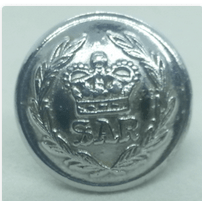
A. J. Parkes Brisbane post 1952
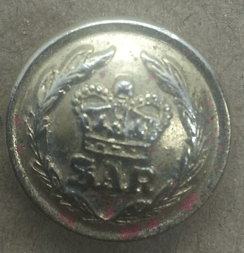
A. J. Parkes Brisbane (gilt)
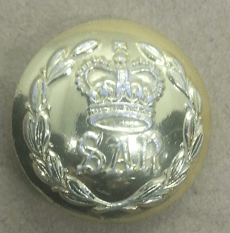
Stokes & Sons post 1953 (Stayrbrite Gilt)
Tasmanian Government Railways (TGR)
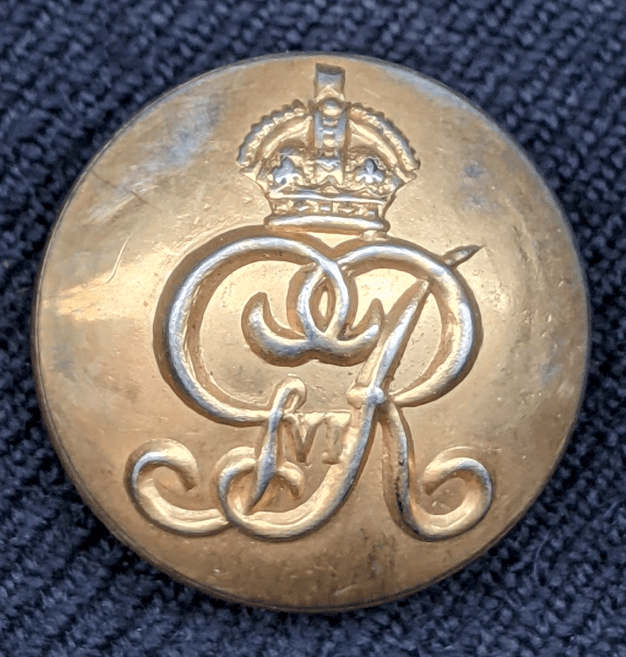
Tasmanian Transport Museum: George VI: 1936-1952
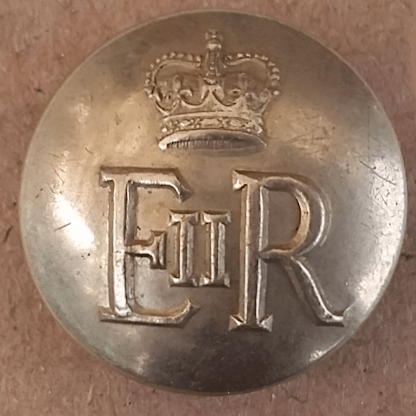
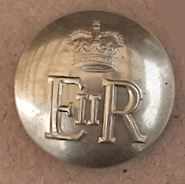
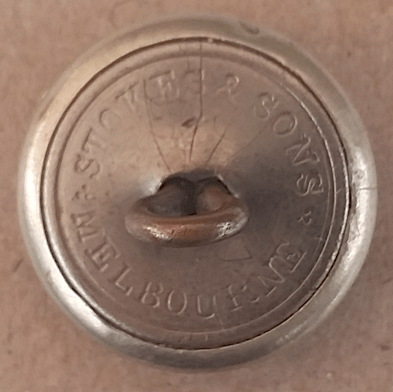
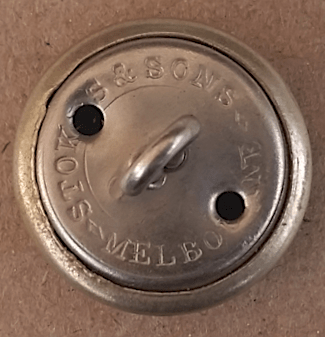
The button on the left would date from Queen Elizabeth’s coronation in 1953, and the other soon after, as this type of back plate with 2 vent holes was adopted in 1953 with the introduction of equipment to produce anodised aluminium buttons, although this doesn’t appear to be an aluminium example. It is likely that this design was used for other government departments.
Rail services in Tasmania were initiated by private firms. The two main operators were the LWR and the TML.
In 1872 the Launceston and Western Railway (LWR) , which had officially commenced running trains between Launceston and Deloraine in 1871, was struggling to repay the credit that had been required for construction of the line. The Tasmanian Government had to step in and take over from 31st October 1873. This was the beginning of the Tasmanian Government Railways, although the title was not used until around 1883, and was formally established in 1888.
From 1872 to 1876 the Tasmanian Main Line (TML) Company started creating a line from Hobart to Launceston. Using the consistently flawed logic of rail services throughout the colonies, a different gauge line was used to that of the LWR! In 1890 the Tasmanian Government bought the TML after years of strife between the government and the company. All the exiting railways were relaid to match the narrow (3ft 6 inch) gauge of the TML.
In 1975 the Federal Government made offers to all the struggling state run railways, with South Australia and Tasmania accepting the takeover by the new Australian National Railways, ending the TGR.
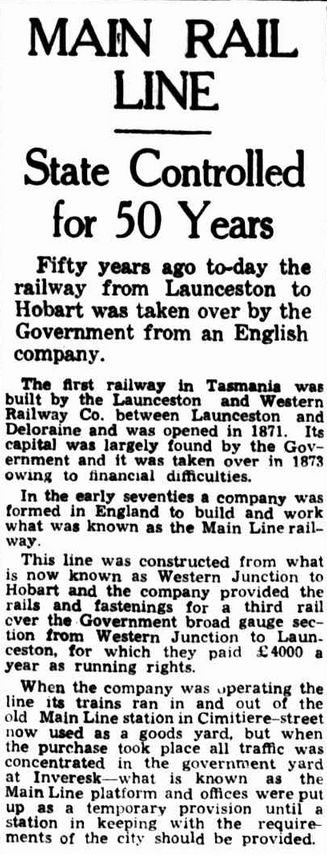
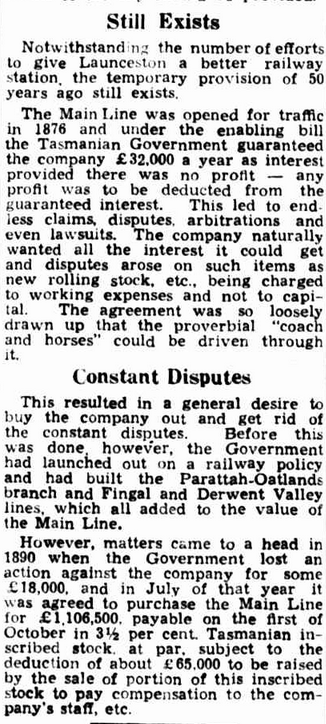
Examiner (Launceston), 1st October 1940 page 4.
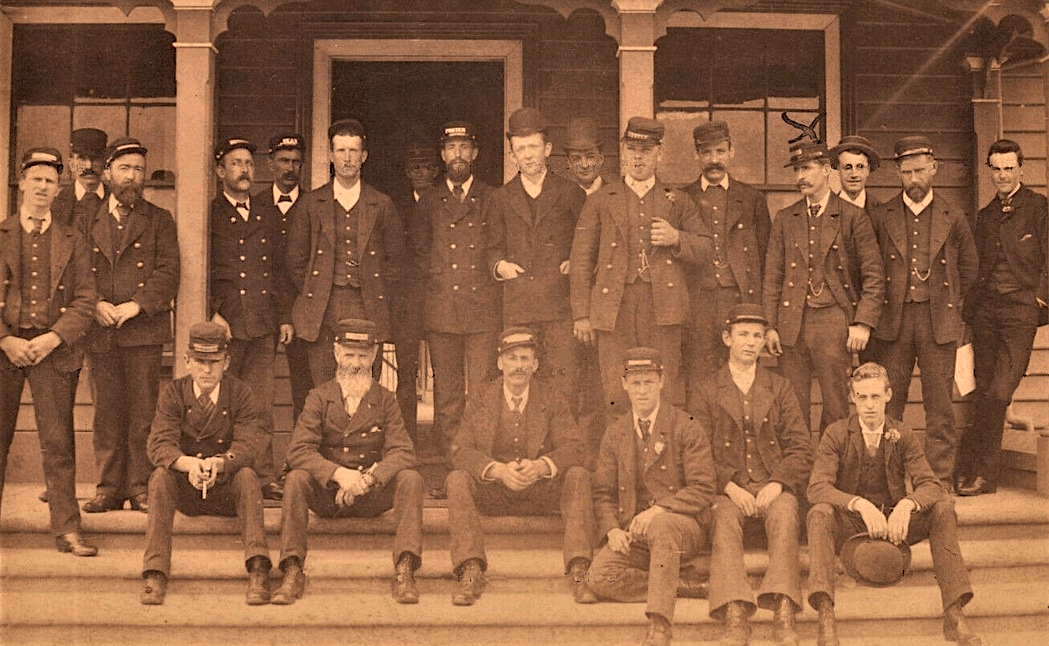
As per Flickr: Tamanian Goverment Railways staff, 1890s.

Sunday Times (Sydney), 27th October 1912 page 19.
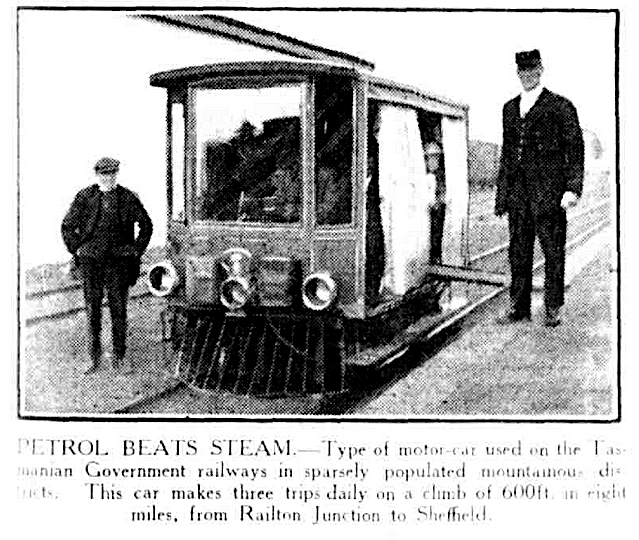
The Suns News-Pictorial (Melbourne), 15th March 1923 page 10.
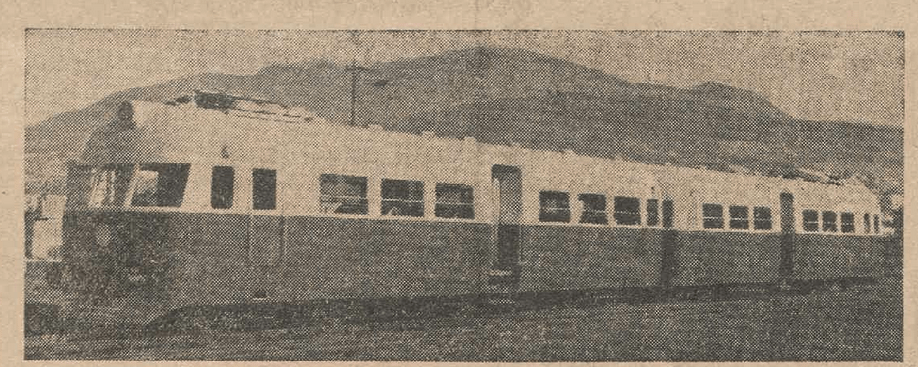
Benalla Standard (Vic), 1st December 1939 page 1. New diesel rail cars.
Victoria Railways
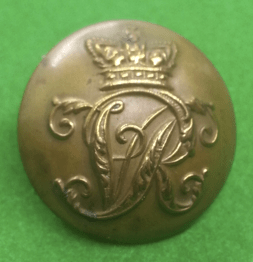
C. R. Martin Melbourne
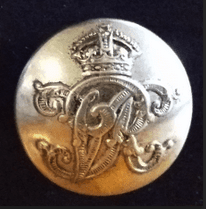
Stokes & Sons Melbourne
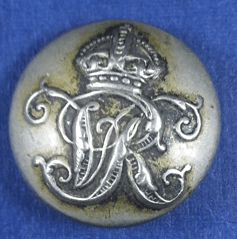
Anderson Sydney

Lincoln Stuart & Co, Melbourne
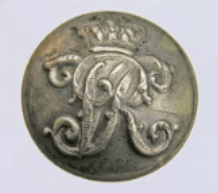
Sol Davis Melbourne
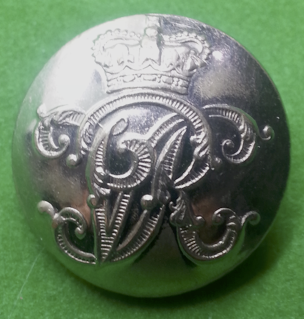
Stokes & Sons Melbourne
Some people make the mistake of thinking these buttons with VR (Which admittedly looks like Queen Victoria’s cypher) is a pre-federation military uniform button. As you can see three of these buttons have a King’s Crown, not a Queen Victoria crown. Therefore, the VR stands for Victorian Railways. (Rules the regarding use of a Sovereign’s cypher and crown preclude any mix and matching. In Victoria’s times various departments including the railways could use this design.)
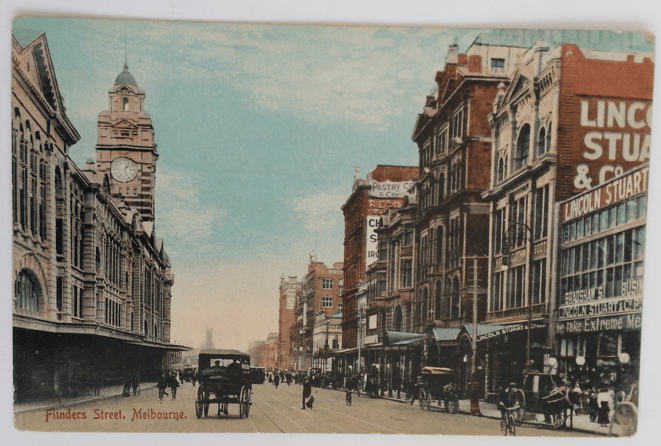
Flinders Street c.1910, with the station on the left.
A department of Railways was established in 1856. The Spencer Street headquarters were opened in 1893.
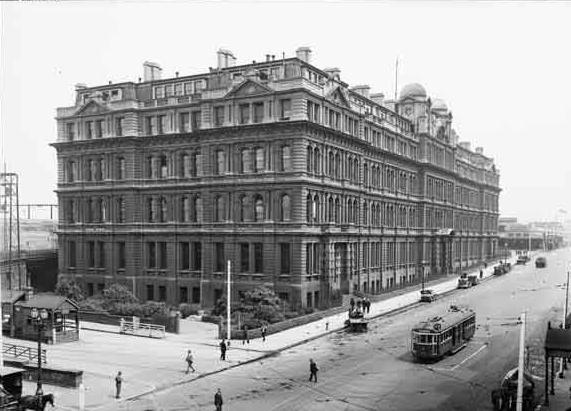
Spencer Street head office of Victorian Railways, from Public record Office of Victoria:
PROV, VPRS 1163/P1, Unit 744, 1883/291.
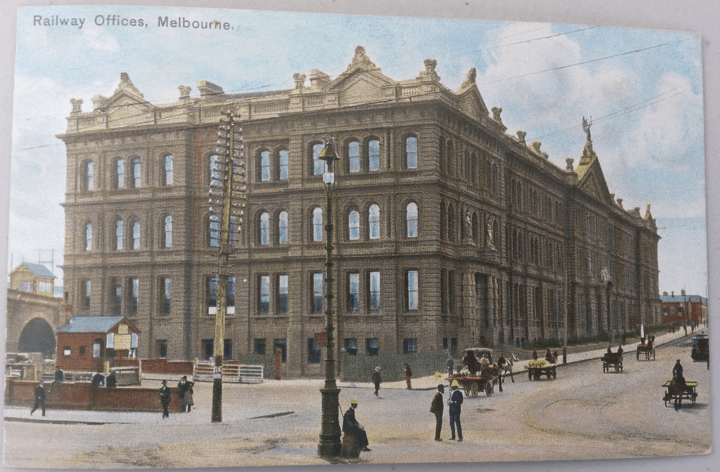
A postcard printed in Germany.
The railways grew from 409km in 1864 to a peak of 7652km in 1939, after which there was a slow decline. The system was electrified from 1919 to 1930. Diesel was introduced in 1951. The last steam loco ran in 1972. A standard gauge with New South Wales did not get built until 1961.
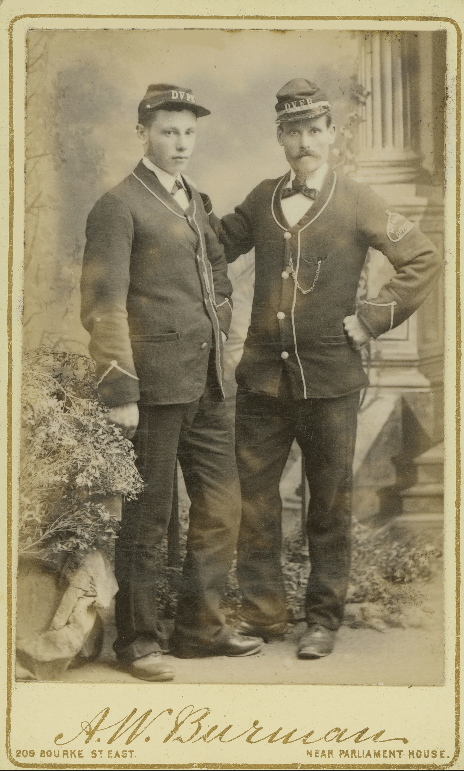
State Library Victoria # 2154372, ?1878-1888
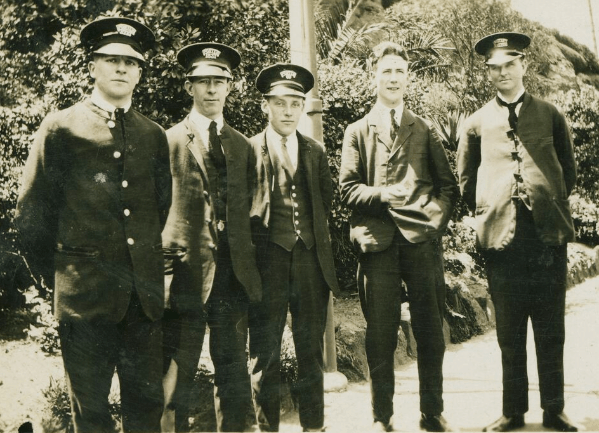
Four of these men are in Victorian Railways uniforms c1930-1948. https://viewer.slv.vic.gov.au/?entity=IE1912229
In 1974 it was renamed VicRail and in 1983 it was split into metropolitan (Public Transport Corp/The Met) and country divisions (VLine). Freight services have been privatised,. V/Line passenger services have returned to Government ownership after a period of privatisation.
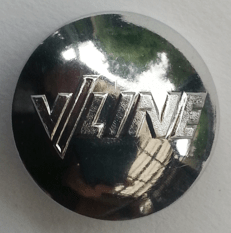
Stokes Australia
Western Australian Government Railways

Backmark: Sheridan Perth 1902-1952
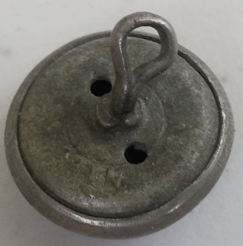
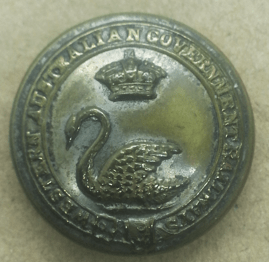
Stokes & Sons Melbourne 1902-1952
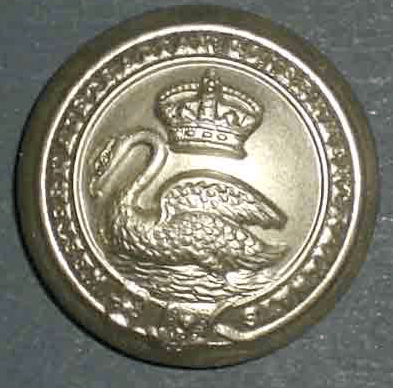
Unknown maker. Nice details with the rippling water.
In 1890 the Department of Works and Railways was split in two, with the formation of the Western Australian Government Railways (WAGR). In 1914 the name was changed to West Australian Government Railways and Tramways. After several more name changes, it again became WAGR from 1949 until 1975 when the trading name became Westrail, although the official name was still WAGR. Perhaps the Sheridan button dates from 1949-1952, as the 2 holes in the back plate seem to date from c.1950?
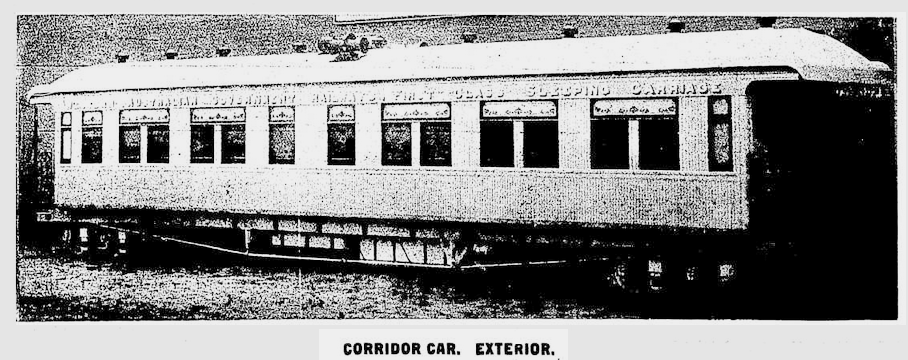
The Daily News (Perth), 8th November 1905 page 3.

The Daily News (Perth), 8th November 1905 page 3.

Kalgoorlie Station staff, 1930.
TRAMWAYS
Ballarat Tramways

Stokes & Sons Melb
Ballarat had horse drawn trams from 1887. In 1904 the first electric trams were put in service, and by 1913 had replaced the horse-drawn examples. The State Electricity Commission of Victoria, which was already running Bendigo’s trams, took control in 1934. As in Bendigo, the service ceased in 1970.
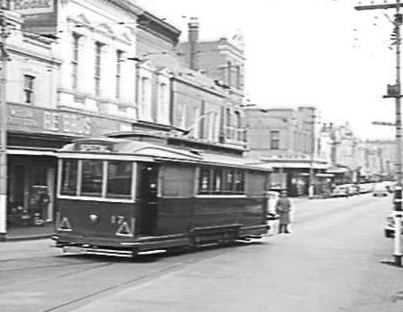
Museum Victoria. Ballarat 1959.https://collections.museumsvictoria.com.au/items/763919
Bendigo Tramways

Stokes & Sons Melbourne
The State Electricity took control of Bendigo’s electric tramways from 1921. It closed in 1970, having not been financially viable for some years.
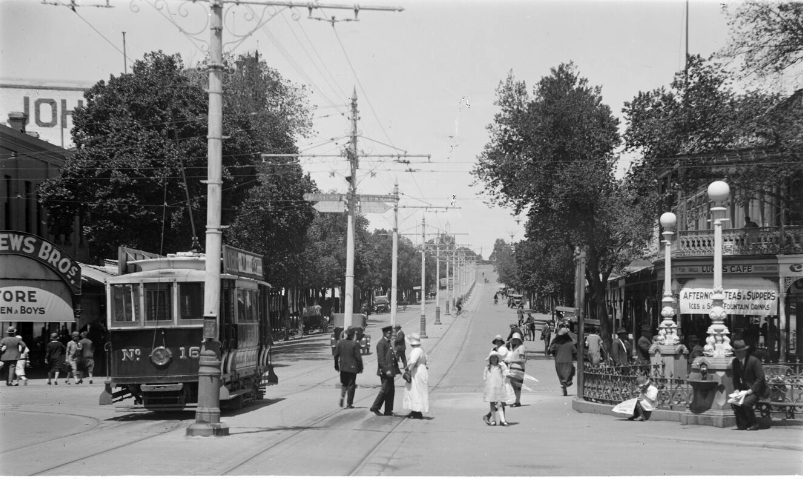
Mitchell Street, Bendigo ?1920-30s
Brisbane Tramways
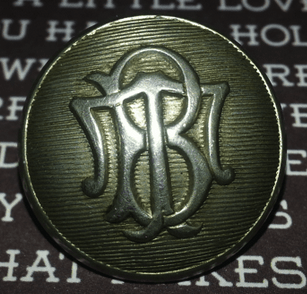
Brisbane Tramways. A. J. Parkes
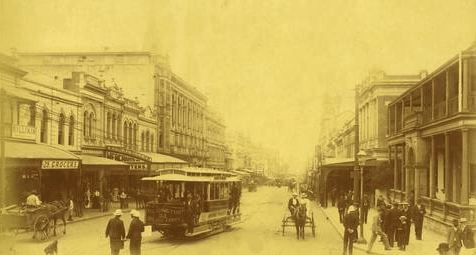
State Library Queensland; Queen Street, Brisbane 1895
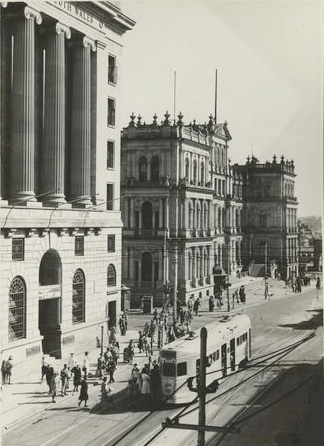
State Library Queensland. Tram stop George & Queens Sts. 1938. Image Number oai:bishop.slq.qld.gov.au:256048
In 1878 a Royal Commission into the linking of the Southern and Western railways in Queensland was told that railway in Brisbane would cost 14,000 pounds per miles whereas road tramways would cost 3400 to 8000 pounds per mile. The next year a ‘Brisbane Railway and Tramway Company and also a “Brisbane Steam Tramway Company” were being proposed. However, due to legal concerns about the safety and amenity of steam engines and/or raised rails upon roads, the issue was delayed. Some felt the government, not private concerns, should build such a service. It took until 1882 before legislation was passed allowing the construction of a tramways, and then until December 1883 before the ‘Brisbane Tramway Company’ was registered. Even then, it remained a contentious issue and it was not until May 1884 that construction commenced. Official services commenced on the 10th August 1885 by horse drawn tram owned by the ‘Brisbane Metropolitan Tramway and Investment Co.’ Unfortunately, only 6 weeks later the first fatality occurred when an employee was run over.
The first item of uniform provided to tramways men was a cap. It took some years for matching tunics and trousers to be supplied. The first mention of tramways uniforms in the newspapers was in 1899.
Electric trams ran from June 1897 although horse-drawn trans were in use until 1899. With competition from buses and private cars the service became uneconomical by 1948 and was wound down; the last services running on 13th April 1969.
https://en.wikipedia.org/wiki/Trams_in_Brisbane
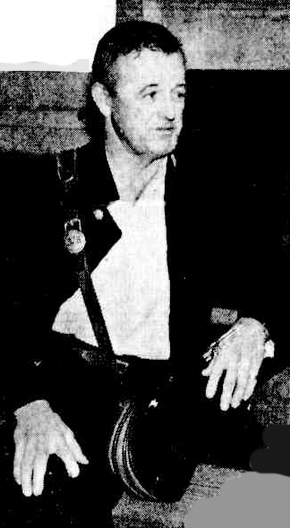
The Courier-Mail (Brisbane) 18th January 1938 page 19. A tramways conductor throws open his jacket for relief during humid weather. Tramways and police personnel were seeking summer weight uniforms.
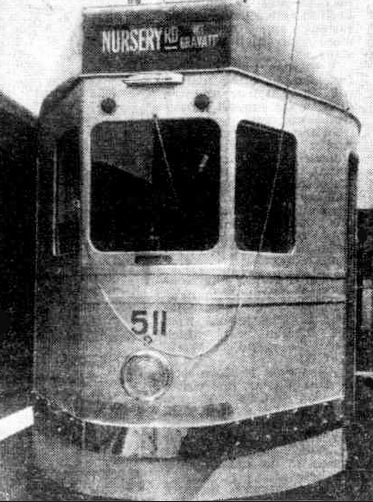
Brisbane Telegraph, 10th November 1950 page 6.
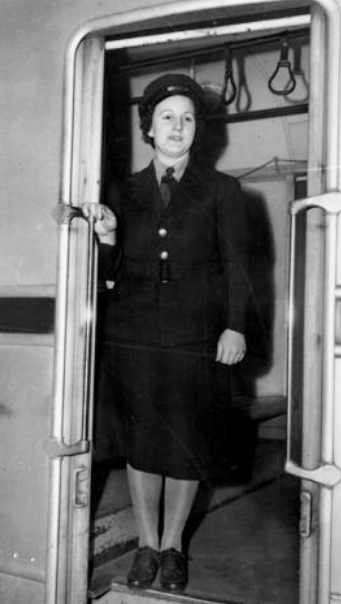
State Library Qld image #195049. Tram conductress in her new uniform, Oct 1942. Women were employed due to a shortage of manpower during WW2.
Hawthorn Tramways Trust
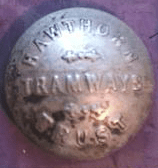
The Hawthorn Tramways Trust was formed in 1914 to construct and manage electric tramways within the cities of Melbourne, Richmond, Hawthorn and Camberwell. They also purchased a horse tramway. At that time most tramways around Melbourne were the cable type. In 1920 their responsibilities transferred to the Melbourne & Metropolitan Tramways, when all the separate tramways were amalgamated.
They operated the Hawthorn Tram Depot and set up Wattle Park in Burwood in 1916, which was officially opened in April 1917.
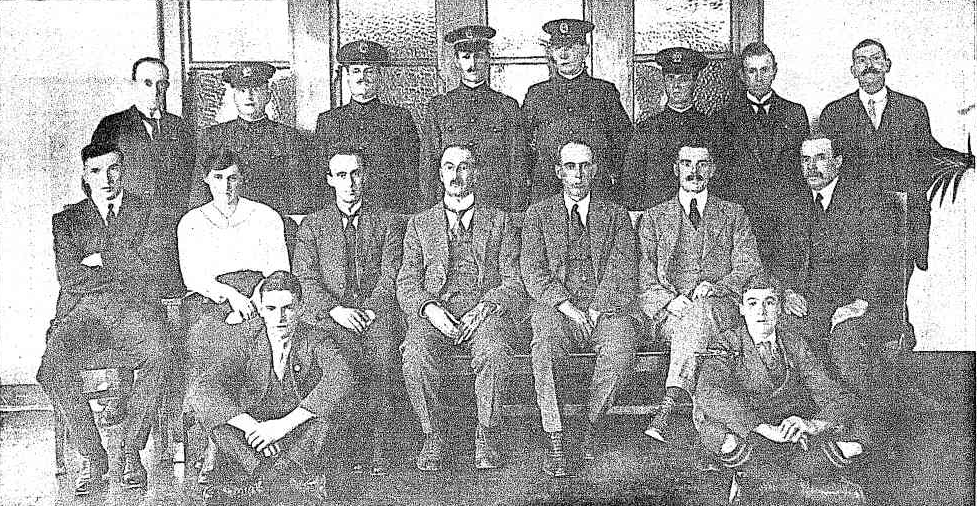
Punch (Melbourne), 14th March 1918 page 24. The Hawthorn Electric Tramways Trust Official Group.
Hobart Municipal Tramways
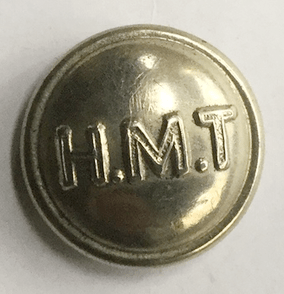
No backmark
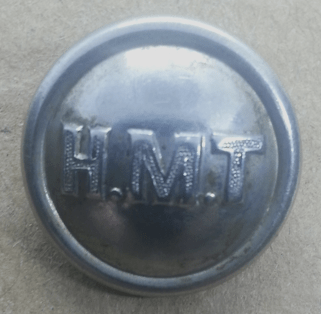
Stokes & Sons. 1950-62.
A tram service provided by the Hobart Electric Tram Company started in 1893. This was compulsorily bought out by the Hobart council in 1913, becoming the Hobart Municipal Tramways. It was phased out then replaced by a bus service by 1968.

The Tasmanian (Launceston), 7th April 1894 page2 of supplement.
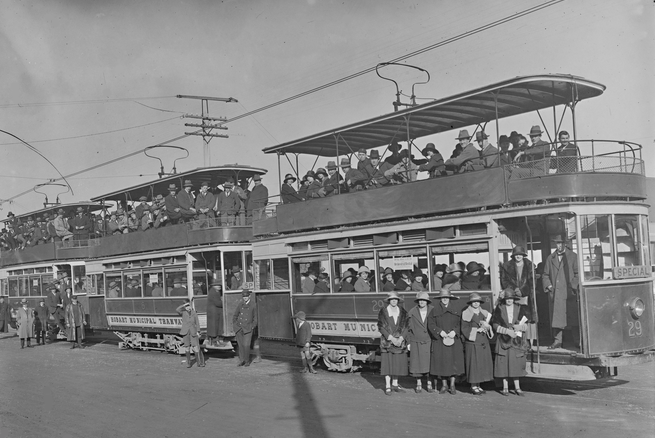
Libraries Tasmania: 1922 https://stors.tas.gov.au/NS4023-1-163
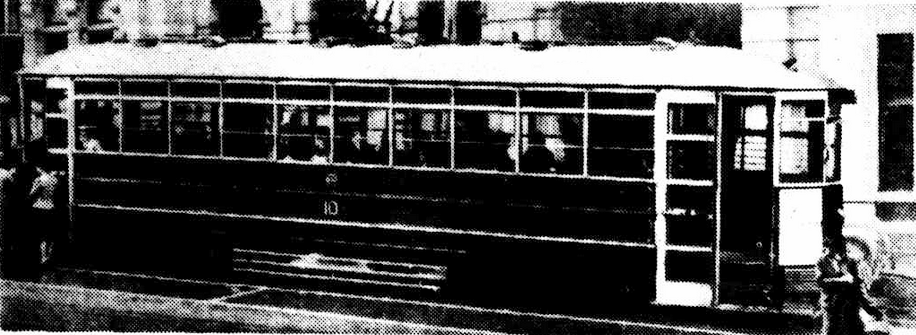
The Mercury (Hobart), 21st September 1943 page 12. “The latest double-bogey type”.
Melbourne & Metropolitan Tramways Board
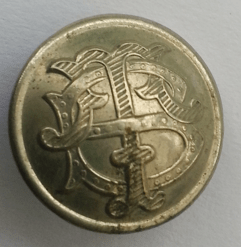
Stokes & Sons Melb.
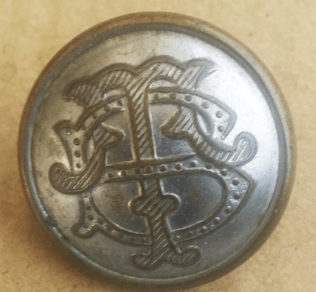
K. G. Luke A’Asia Ltd. (Blackened finish).
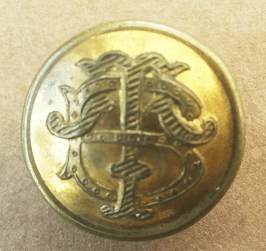
Stokes Vic
Horse drawn trams ran from 1884 to 1923. The first cable tramways ran in 1885 from Bourke Street to Bridge Road. The first electric tram ran from Box Hill to Doncaster in 1889, but closed in 1896. From 1906 various electric tramways companies ran lines through Melbourne suburbs. In 1916 the cable network was taken over by the Melbourne Tramways Board (M.T.B.). The M. & M.T.B. was formed in 1919, taking control of Melbourne’s cable network, most of the electric tramways, and the one remaining horse-drawn line that ran to the Zoo. By 1940 all lines were electric.
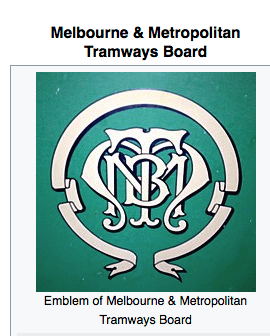
From Wikipedia.
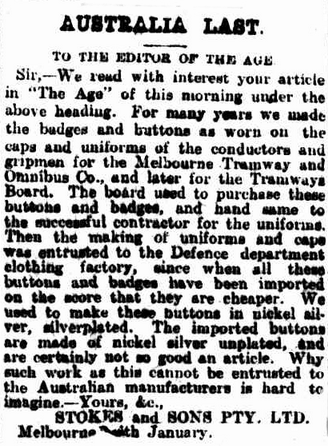
The Age, 25th January 1927 page 10.
In 1983 The Melbourne and Metropolitan Tramways Board was absorbed into the new Metropolitan Transit Authority.
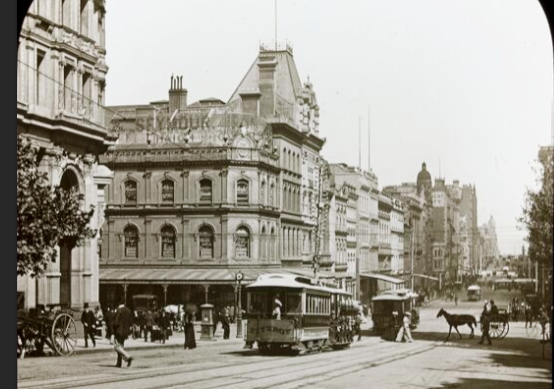
Collins Street ?late 19th century. State Library Victoria https://viewer.slv.vic.gov.au/?entity=IE51615&mode=browse
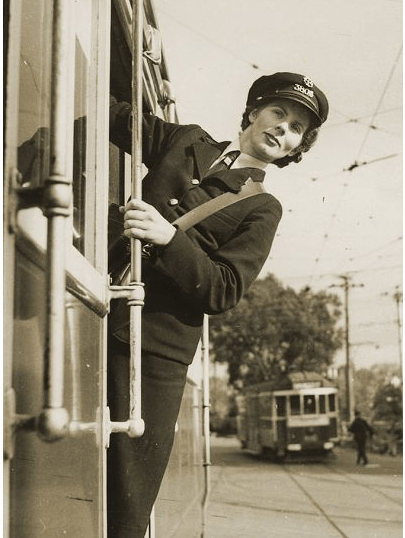
State Library Victoria ( but seen on Melbourne tramways Museum website), Uniforms were made by the Commonwealth Clothing Factory from 1919-1938, then the M&MTB set up its own clothing factory in Hawthorn.1942.
Municipal Tramways Trust, South Australia
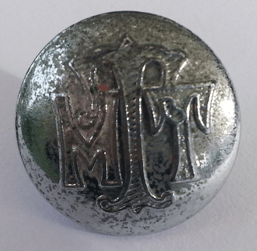
A. J. Parkes Brisbane
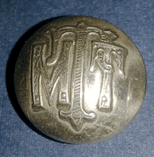
Stokes & Sons Melb
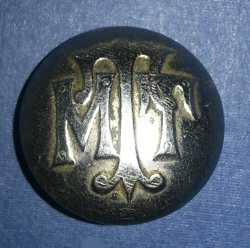
S. S. & Co. Ltd., Adelaide (Silias Schlank & Co)
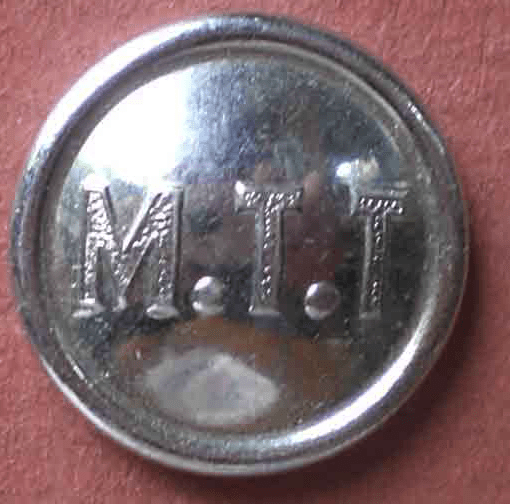
The M.T.T. was established in 1906 to purchase all of the horse-drawn trams in Adelaide. It would afterward run electric trolleybuses, as well as petrol and diesel buses. In 1975 it was replaced with the State Transit Authority.
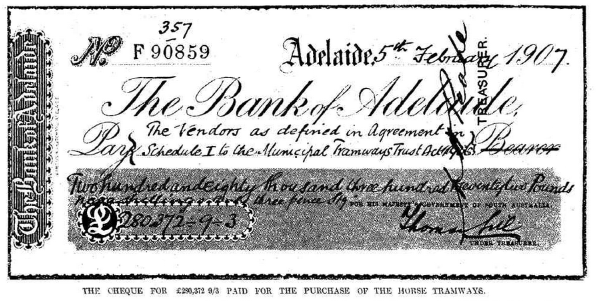
Chronicle, 9th February 1907 page 29.
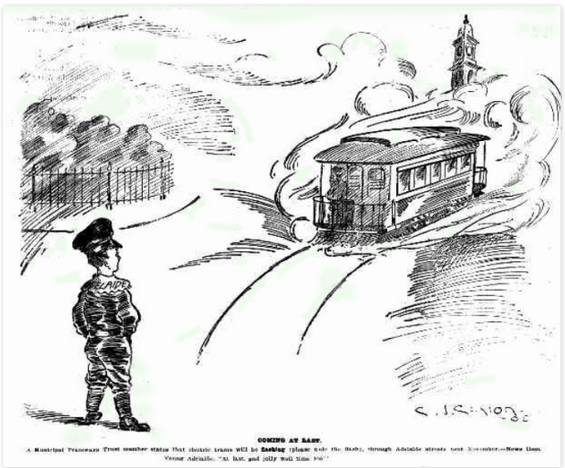
Critic (Adelaide), 12th February 1908 page 20: “A Municipal Tramways Trust member states that electric trams will be flashing (please note the flash), through Adelaide streets next November.—News Item.
Young Adelaide: “At last, and jolly well time too!” This cartoon reflects the frustration of the years of waiting for an upgrade system.
New South Wales Tramways
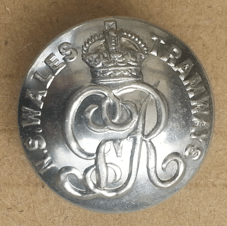
Stokes & Sons Melbourne 1911-1936
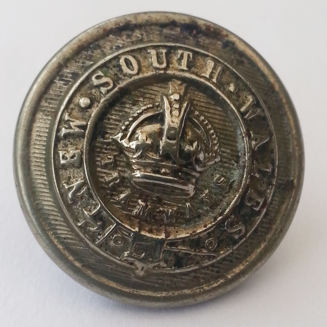
Stokes & Sons Melbourne King’s crown
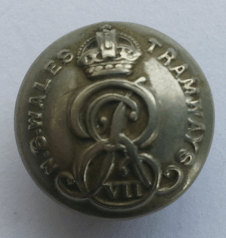
Anderson Sydney British Make Edward VII cypher.
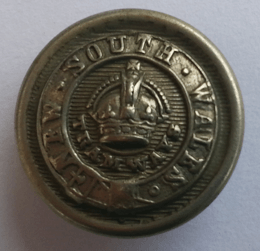
A. J. Parkes Brisbane King’s crown
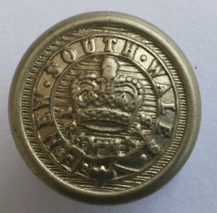
A. J. Parkes Brisbane Queen’s crown.
Horse drawn tramways started use in Sydney from 1861. Steam trams ran from 1879. Electrification occurred between 1898 to 1910 with the exception of a privately owned line.
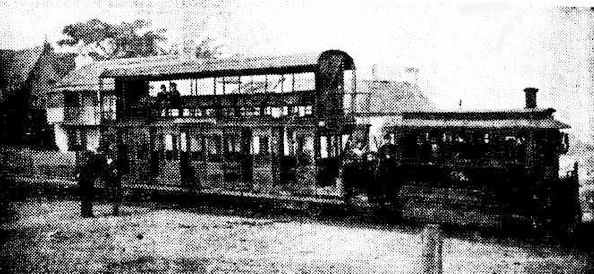
The Daily telegraph (Sydney), 14th June 1947 page 17. Double-decker steam tram 1879.
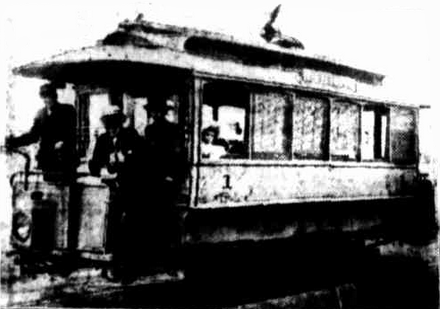
Evening News, 15th February 1922 page 10. Showing the first electric tram from 1890.
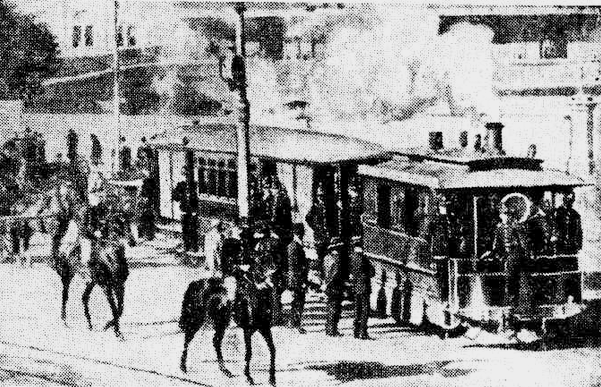
The Daily telegraph (Sydney), 14th June 1947 page 17. Steam tram in 1908.
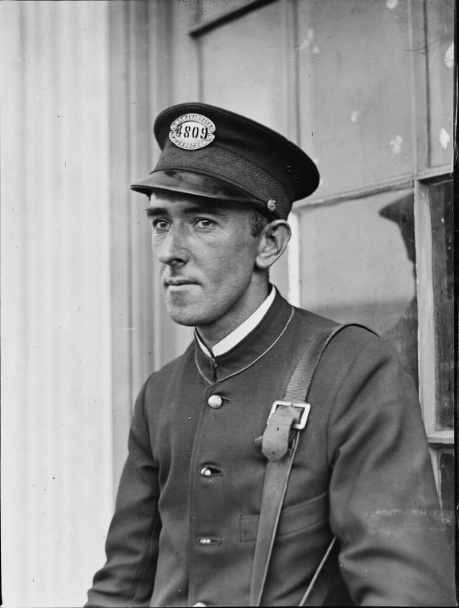
National Library. NSW tramways conductor c.1930 call no. PIC/15611/10081 LOC Cold store PIC/15611 .
When usage peaked in 1945 it was the largest in Australia, and second only to London in the Commonwealth. As cars and buses grew in use, tram lines were closed from the late 1930s. Despite public support, the post WW2 Government took advice that the tram network, in need of upgrading after war-time neglect, was better closed. It was therefore wound down from the late 1950s until 1961.
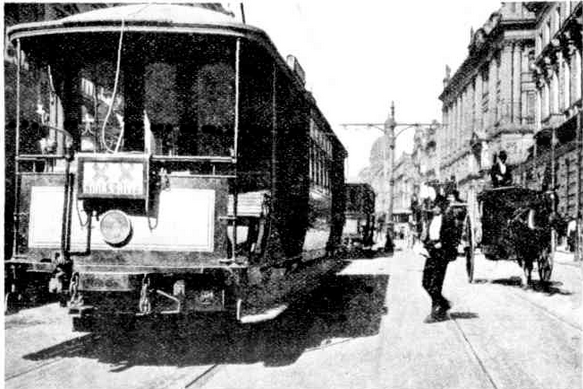
The Sydney Mail and NSW Advertiser, 21st September 1901 page 738.
(NSW) Department of Government Transport
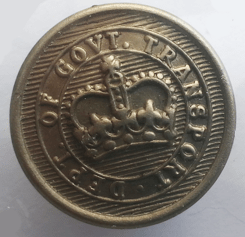
A. J. Parkes Brisbane
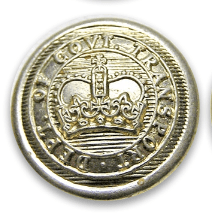
Tony’s button: Stokes Vic
This Department existed from 27/10/1952 until 20/10/1972 in New South Wales to oversee bus and tram services. It was superseded by the Public Transport Commission.
Prahran & Malvern Tramways Trust
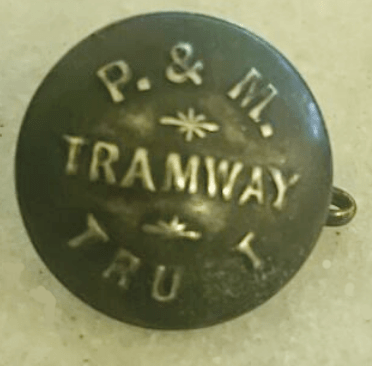
Image used with permission. Backmark Stokes & Sons Melb
This tramways was established in 1907. Although it had been proposed as early as 1891 it had been delayed due to the financial depression of the 1890s, then by years of negotiations.
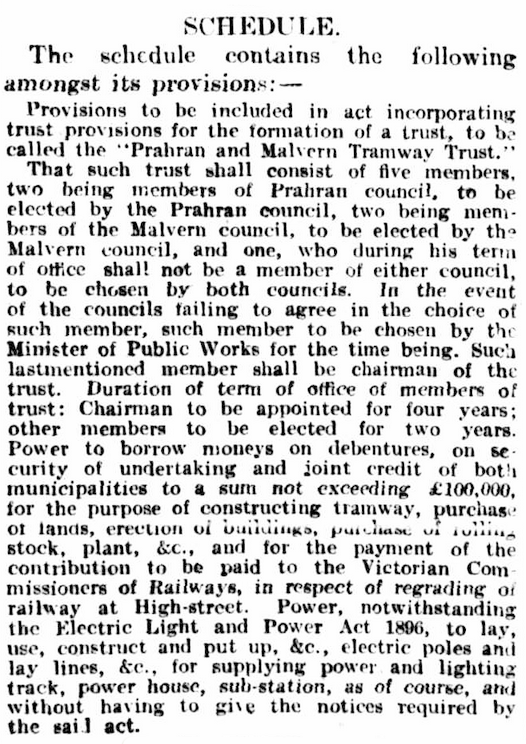
The Age (Melbourne), 24th September 1907 page 6.
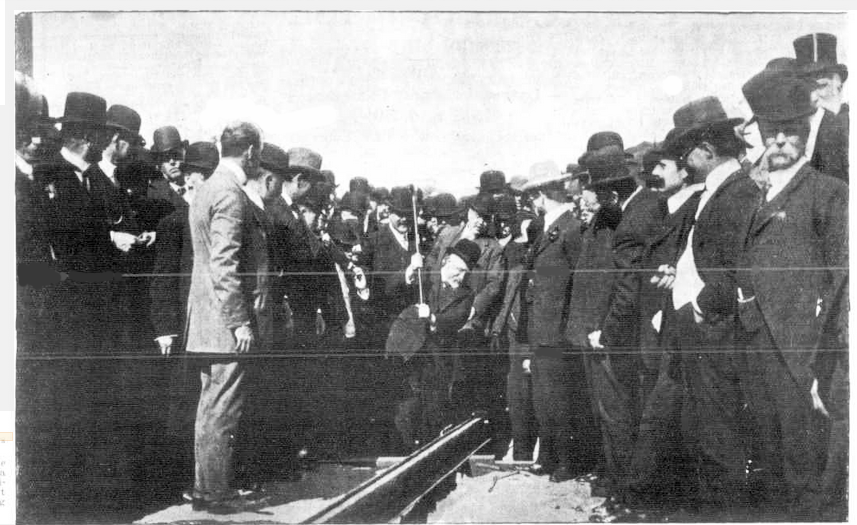
Punch (Melbourne), 28th October 1909 page 27. The mayor of Prahran drives in the first spike.
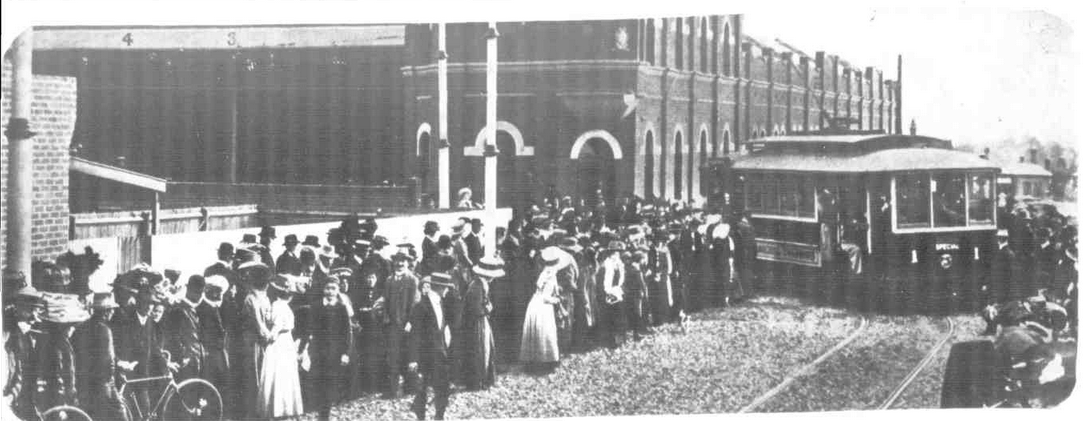
The Australasian (Melbourne), 4th June 1910 page 34. The Official Opening of the tram line, with the first car leaving the “barn”.
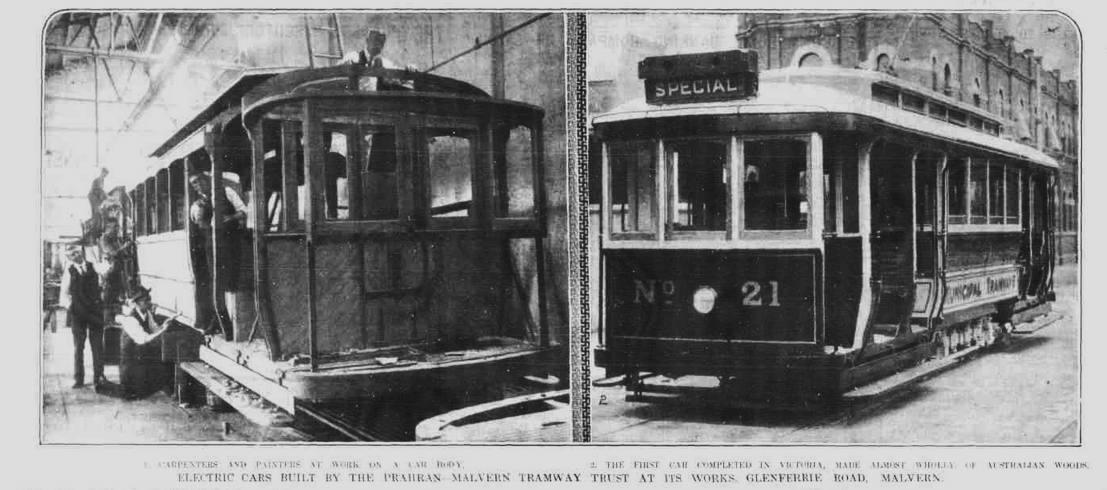
The Australasian (Melbourne), 3rd February 1917 page 52. Electric trams built at the P & M Glenferrie Road works.
It existed until until 1920 when it was merged with the Melbourne & Metropolitan Tramways Board.
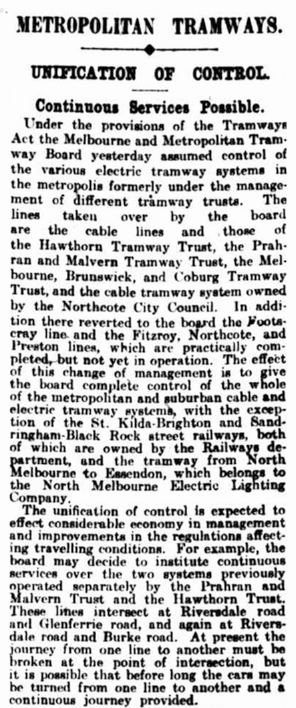
The Argus (Melbourne), 3rd February 1920 page 6.
Western Australian Government Tramways
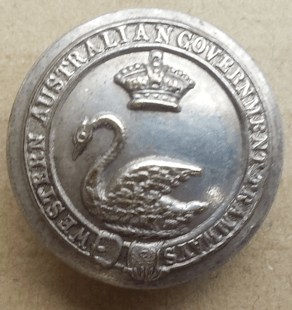
Stokes & Sons Melbourne.
Tramways serviced Perth from 1899 until 1958. The initial service was operated by an English company called the Perth Electric Tramways Limited.
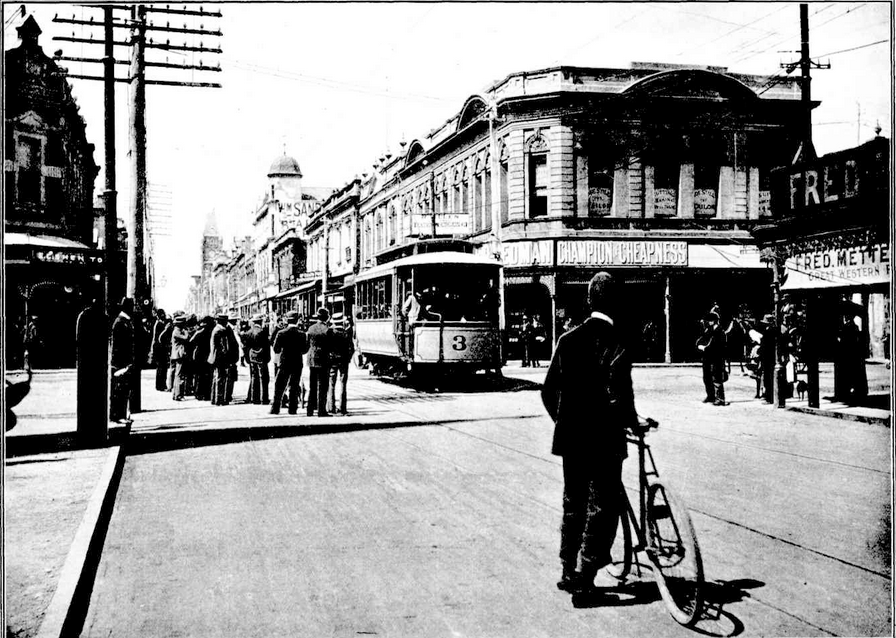
The Daily News (Perth), 1st October 1921 page 22. The opening of Perth Electric Tramways on 28th September 1899. The first tram in Hay Street.
The State Government took over this service compulsorily from 1912-14. From 1948-1958 the trams were replaced by buses.
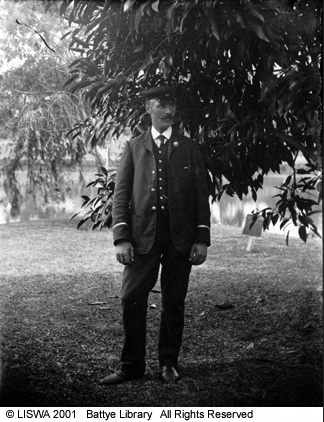
State Library WA: Tramways uniform, 1910. (photo ID 004778D)

